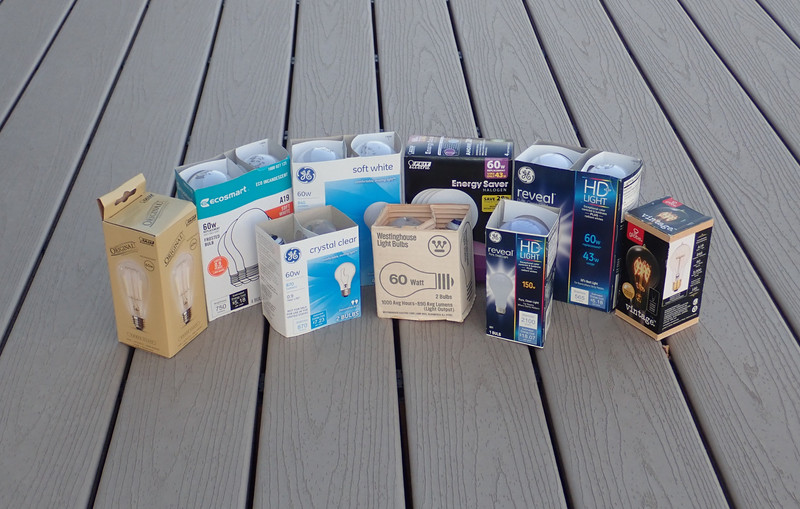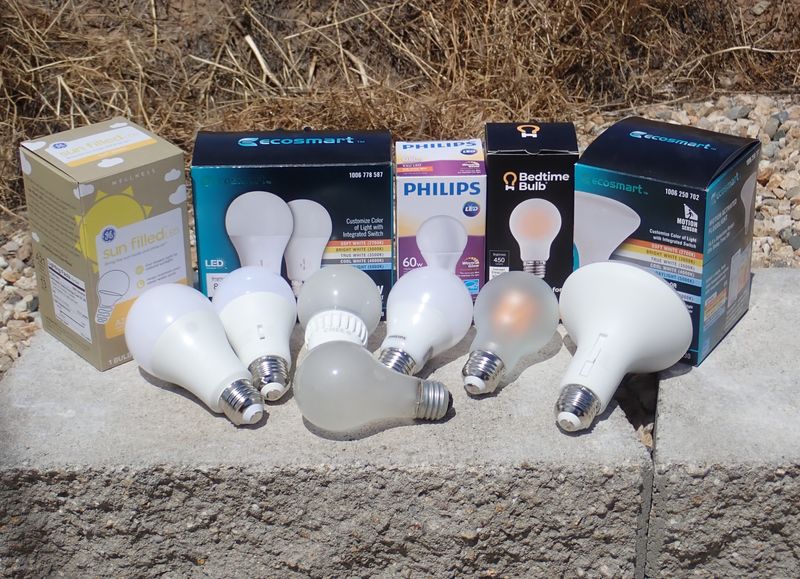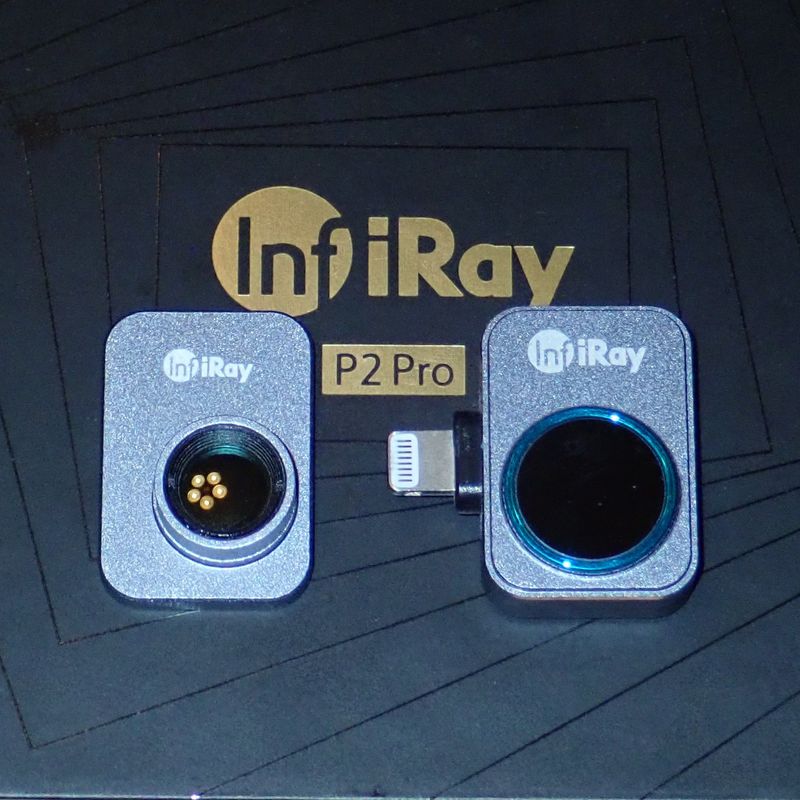My last post reviewed some LEDs, and this week, I’m applying the same sort of analysis to a collection of incandescents, ancient and modern! I’ve got some new production bulbs, some new old stock bulbs, some modern halogen capsule bulbs, some “Reveal” bulbs, and to round it out, some of the long filament Edison bulbs.
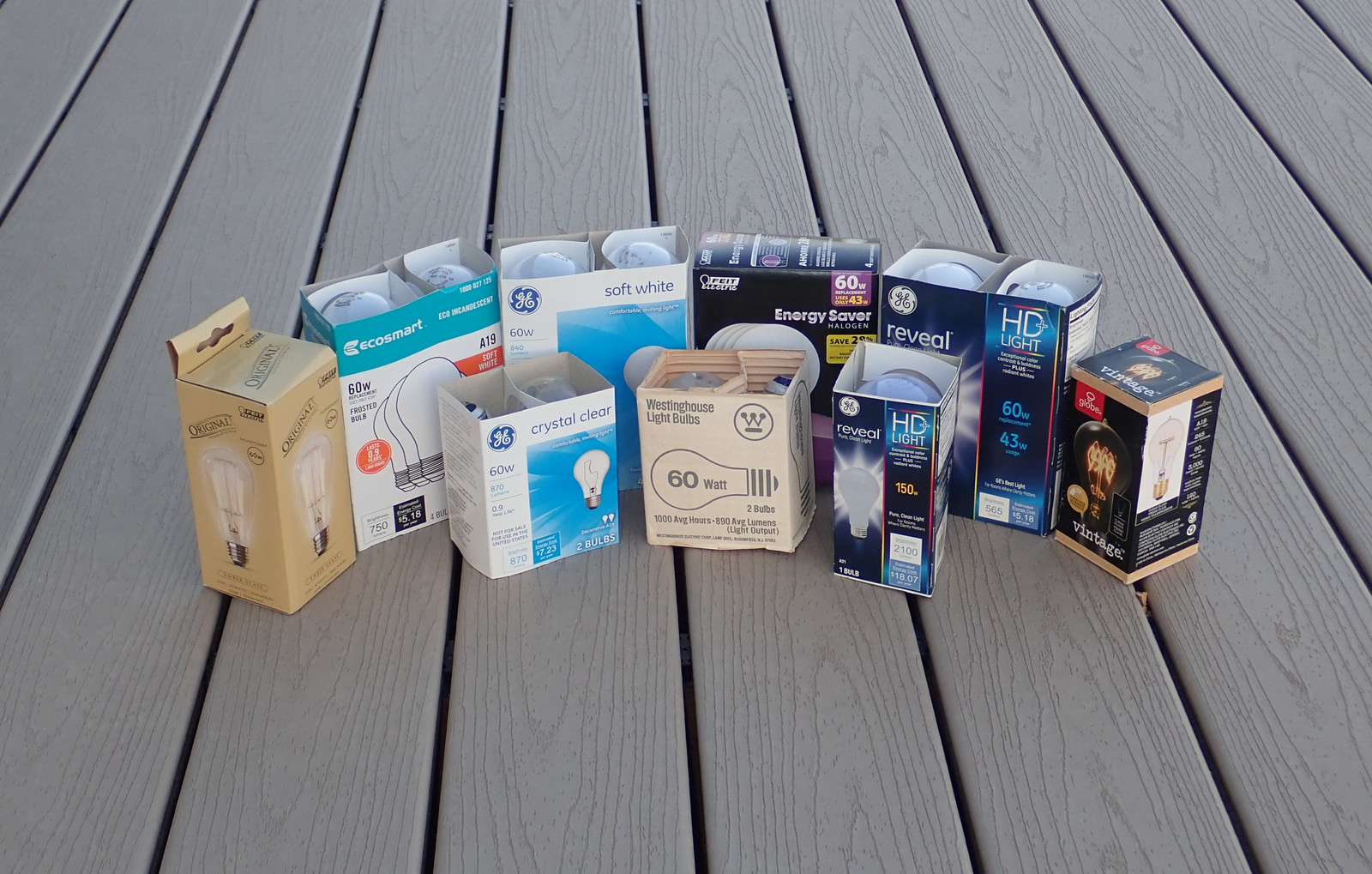
If you’re new to this general category of posts, about a year ago I started looking into the claim that blue light from LEDs messes with your sleep, and I found it to be true, so I’ve moved my evening lighting sources back to incandescents - but, importantly, incandescents on dimmers. Throughout my reviews of bulbs, I’ve noted that as you dim the LEDs, they do get dimmer - but even the ones that are supposed to color shift don’t really drop much of the blue out of their spectrum - and they can’t, because that’s literally how they work. A blue emitter and a bunch of phosphor to convert some of that to enough other colors to create a white light.
But incandescent bulbs do change their spectrum when they dim - and do so rather dramatically in a way that significantly reduces the blue while also reducing the intensity, and you’ll see that throughout this post.
I’ve grouped the bulbs by “general category” - and you’ll certainly notice some trends that show up regularly in categories of bulbs.
Also, yes, the surface in the title image here does mean I’ve gotten a three year project more or less usefully wrapped up, so I’ll be doing a series of posts on my rather large deck at some point in the future. It’s only a third the size of my house…
A Note on Power Use, Lifetime, and Efficiency
If you’re going to comment about LEDs are so much more power efficient (5-6x, not “orders of magnitude”) and last so much longer than incandescents, save it. I’m aware of the claims on the box. I’m also aware that almost all of my incandescents are in “recessed or enclosed” fixtures which most LEDs fail early in, and I quite frankly don’t care about lumens per watt. I care about human-friendly lighting per watt, and LEDs are not that in the evening. They’re all too blue, and most of them don’t dim very deeply at all.
In practical use, many LEDs seem to struggle to reach their rated lifespan - and the number that aren’t rated for enclosed or recessed fixtures is impressive. They overheat in “almost everything you probably have in your house,” and that kills the electronics early in fixtures that don’t bother incandescent bulbs in the slightest. And while LEDs have trouble reaching their lifespan, all my incandescents are on dimmers, which dramatically increases their functional lifespan. I’ll let you know when I figure out what the practical lifespan of my incandescents is, but I’ve had one over the kitchen sink on a dimmer for 5+ years, typically on several hours a night, dimly, in the winter months, and it’s still going strong. A “1000 hour” bulb, dimmed, can easily last 10k+ hours - and it doesn’t care in the slightest about recessed fixtures. If anything, they’re more efficient in them due to running hotter.
I use a minimum reasonable amount of light for evening tasks - I’m not going to strain to read a book, but the amount of light needed to read paper books is an awful lot less than you think. And you’ll see just how much less-blue that light is in this post.
I’m also noting the full wall voltage watts (per my Kill-a-Watt). Most of the modern bulbs don’t actually indicate rated voltage, and older bulbs did - it wasn’t hard to find 130V rated bulbs that quite outlived their rated 1000 hour lifespan at 120V. My evening voltage is around 122V, so I’ll see what the bulbs actually draw.
It’s also worth mentioning that most of my bulbs draw slightly less power on the dimmers - even at full bright. I’ve got a high end Lutron dimmer in my test box, and bulbs draw less power with it turned up all the way than they do in a “simple fixture” - so even if you run bulbs bright, a dimmer is going to help extend their life. Incandescents are harder and harder to get, so, please. Take care of them. Put them on a dimmer, and bring them up to rated current gently (soft start dimmers exist, or just turn it on dim and ramp it up).
A Note on the Phoebus Cartel
Another thing I’d like to bring up is the Phoebus Cartel - the “light bulb life fixing” group often cited as the origins of planned obsolescence. And they did target a light bulb life of 1000 hours, lower than had previously been common. However, physics being physics, incandescent filament bulbs trade off things like “lumenous efficiency” and “life” and “color temperature.” All other things being equal (which, for a tungsten filament, they mostly are), a shorter lived bulb will make more light per watt - and the 1000 hour life, at the time, was seen as a reasonable optimization for total cost of light. Counting bulb costs and power costs, there will be some optimum point in which you minimize total cost, and that was around 1000 hours (at the time).
You can get super long life bulbs. They’re just a good bit less efficient in terms of “light out per watts in” than shorter lived ones - I’ve got an 850 lumen 20k hour bulb that pulls 75W, vs the 60W bulbs that are around 1000 hour life and put out the same light. Useful if it’s a pain to change, not the most cost effective as far as incandescents go.
Flicker
I’m also reporting flicker numbers for these, based on an app that uses high speed cell phone camera data to figure out the variance in brightness over time. Incandescents pulse at 120Hz - this is just a nature of the AC waveform, but it’s also a factor of the thermal inertia of the filament. You’ll see that bigger bulbs have less flicker, because they’ve got a heavier filament in them. It really doesn’t matter much - you won’t notice it - but it’s an interesting data point to compare. Practically, it doesn’t matter - you won’t notice it in any of them. But it’s an interesting metric in “abstract units.”
New Regular Incandescents
I’m starting off with some new production 60W light bulbs. These are similar to the bulbs we all grew up with, if you’re over about 25. They’re no longer for sale for use in the United States, because they don’t meet various efficiency requirements anymore, but they’re just regular old bulbs.
First up, the GE Crystal Clear. Notice that this clear 60W bulb puts out 870 lumens. A mid-800 lumen rating is pretty standard for the old 60W bulbs - so when you see the “energy efficient halogen” bulbs talking about all the light for less energy, do the math and be careful. I’ll point that out below.
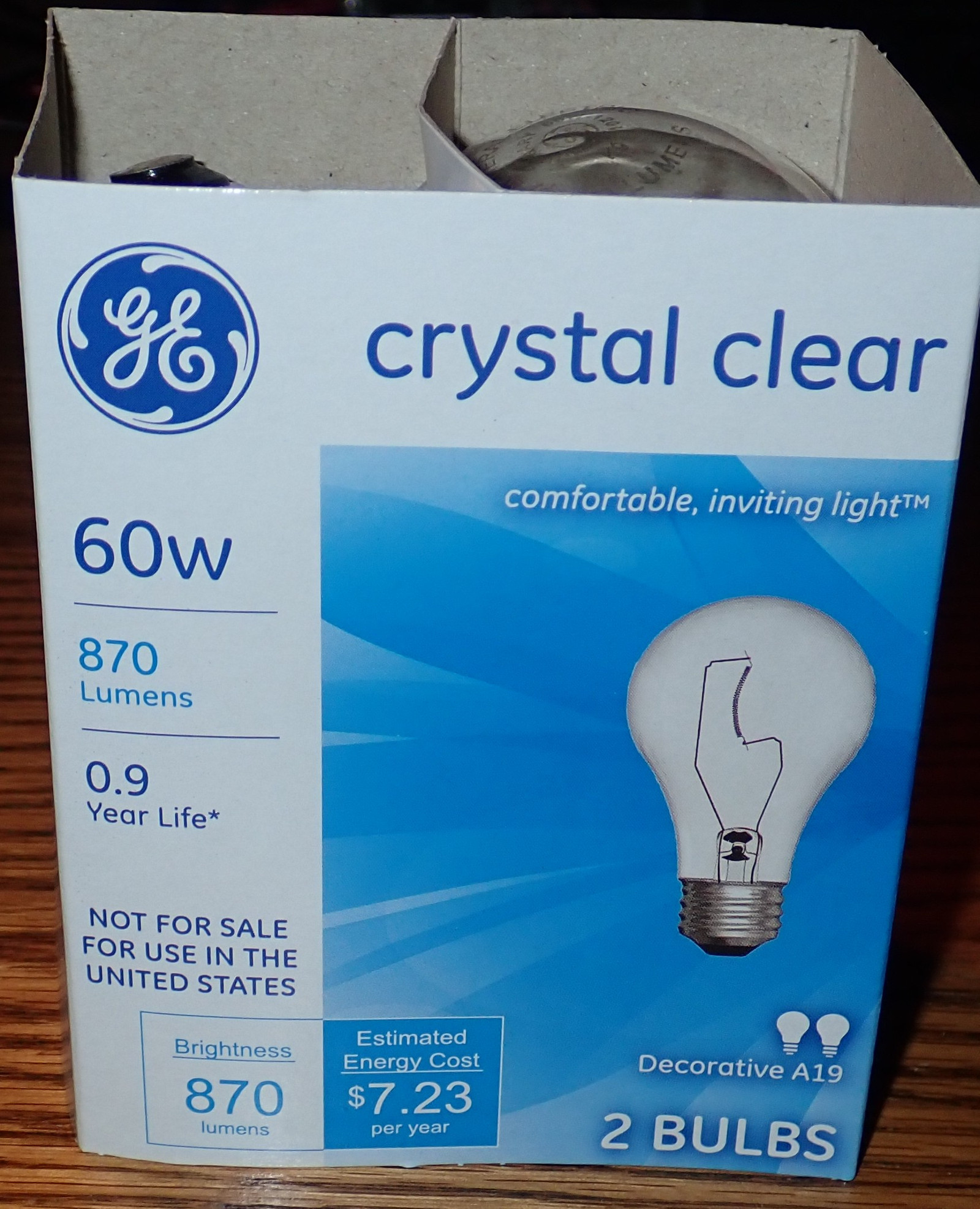
Estimated energy cost isn’t too far off my area, though if you run them dimmed, it obviously costs a lot less. This is a slightly “cooler” (higher color temperature) bulb than many, at around 2800K, and the lifespan listed is rather short - this is a bulb designed to live hot and light well, and you pay for that in lifespan.
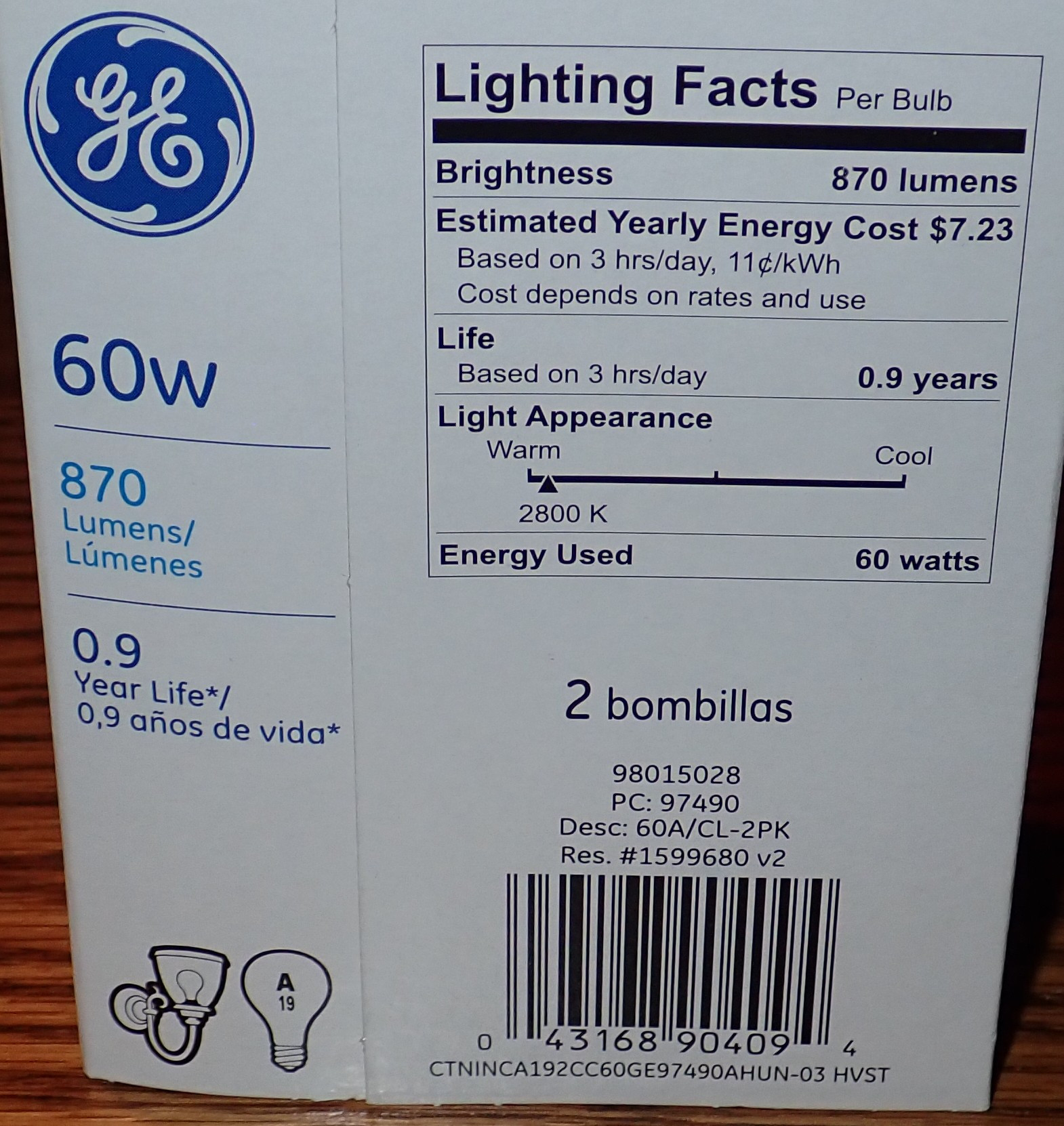
In operation, it looks like this - and pulls, from the wall, 61.7W. My voltage is a bit over 120V, so this is pulling a bit over 60W, and the lifespan, if you run it non-dimmed, will be slightly shorter than rated. It’s not a bad looking bulb, though the filament is prone to wobbling around a lot from any vibration.
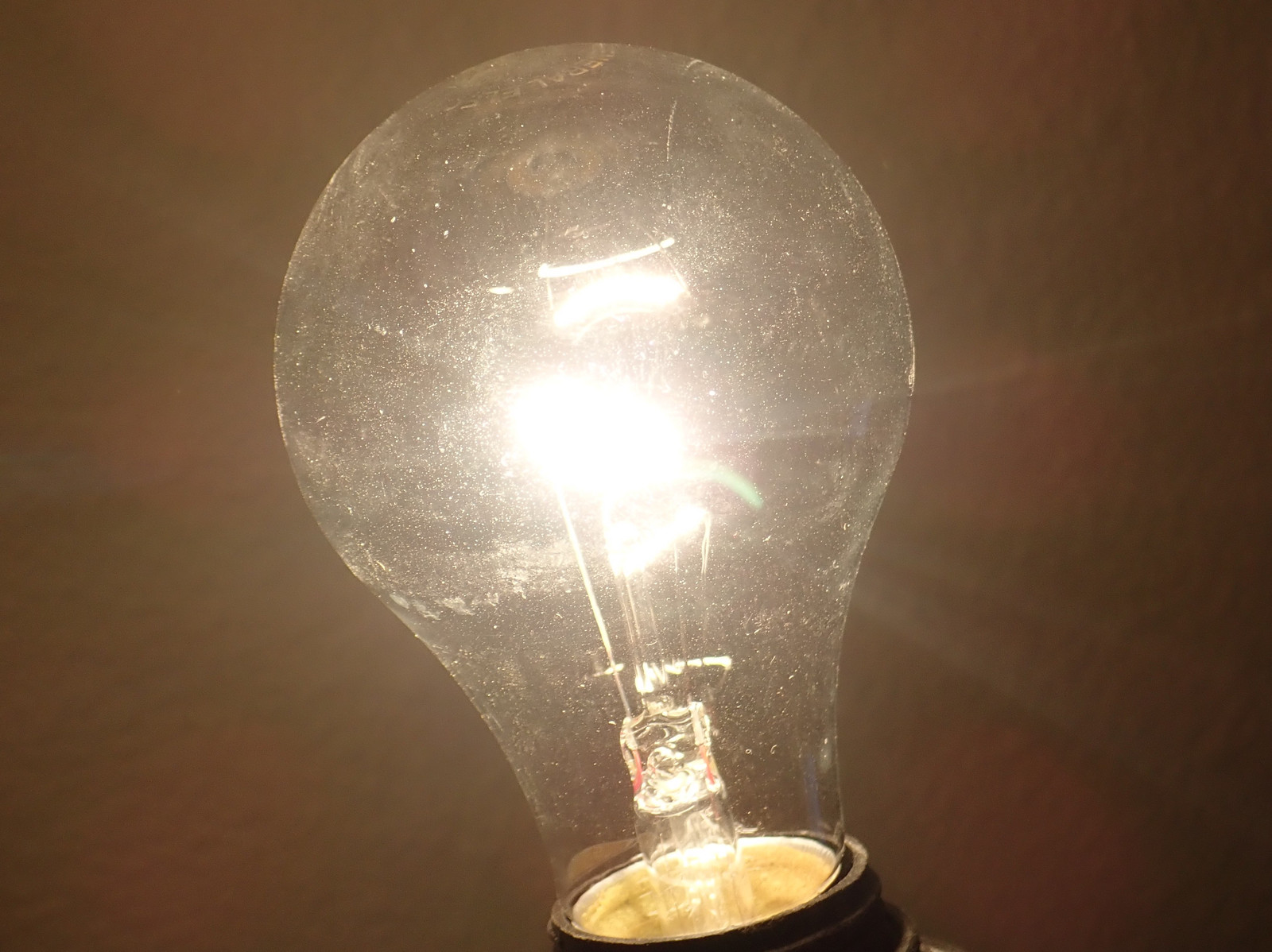
Looking at the full bright spectrum, bulbs like this are why you’ll see the occasional claim that incandescents put out more blue than LEDs - and, you know what? It’s true. Some incandescents pump out a good bit of blue, and this is one.
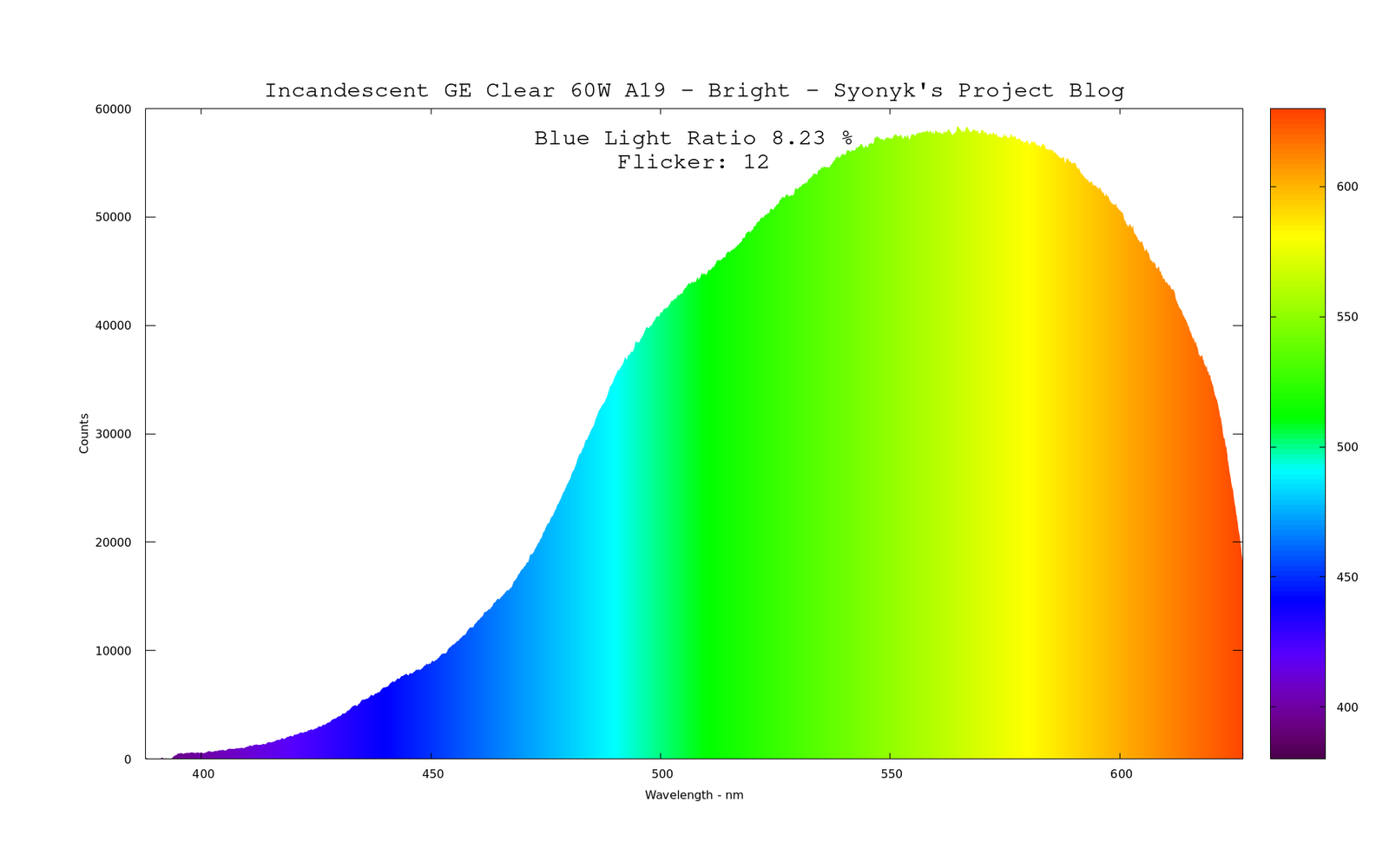
But dimmed, even this hot running, blue leaning bulb manages to get rid of an awful lot of the blue, and outperforms almost all the LEDs out there in terms of “less blue.” Also, these are nice smooth spectrums, without any awkward peaks. This is just a plain old blackbody emitter - though if you’re familiar with that spectrum, you’ll notice my spectrometer is falling off in sensitivity in the reds.
Unfortunately, and rather fatal for modern use in my recommended way, this bulb sings on dimmers. There’s an audible (and annoying) whine from it when running on a dimmer, anywhere between fully dim and fully bright (as I’ve noted, my dimmers seem to trim a bit, even at full brightness). And that’s just a problem. So, useful if you only need full bright incandescent somewhere, but I’m not sure why you’d use this bulb over a modern full spectrum LED unless you needed the heat somewhere.
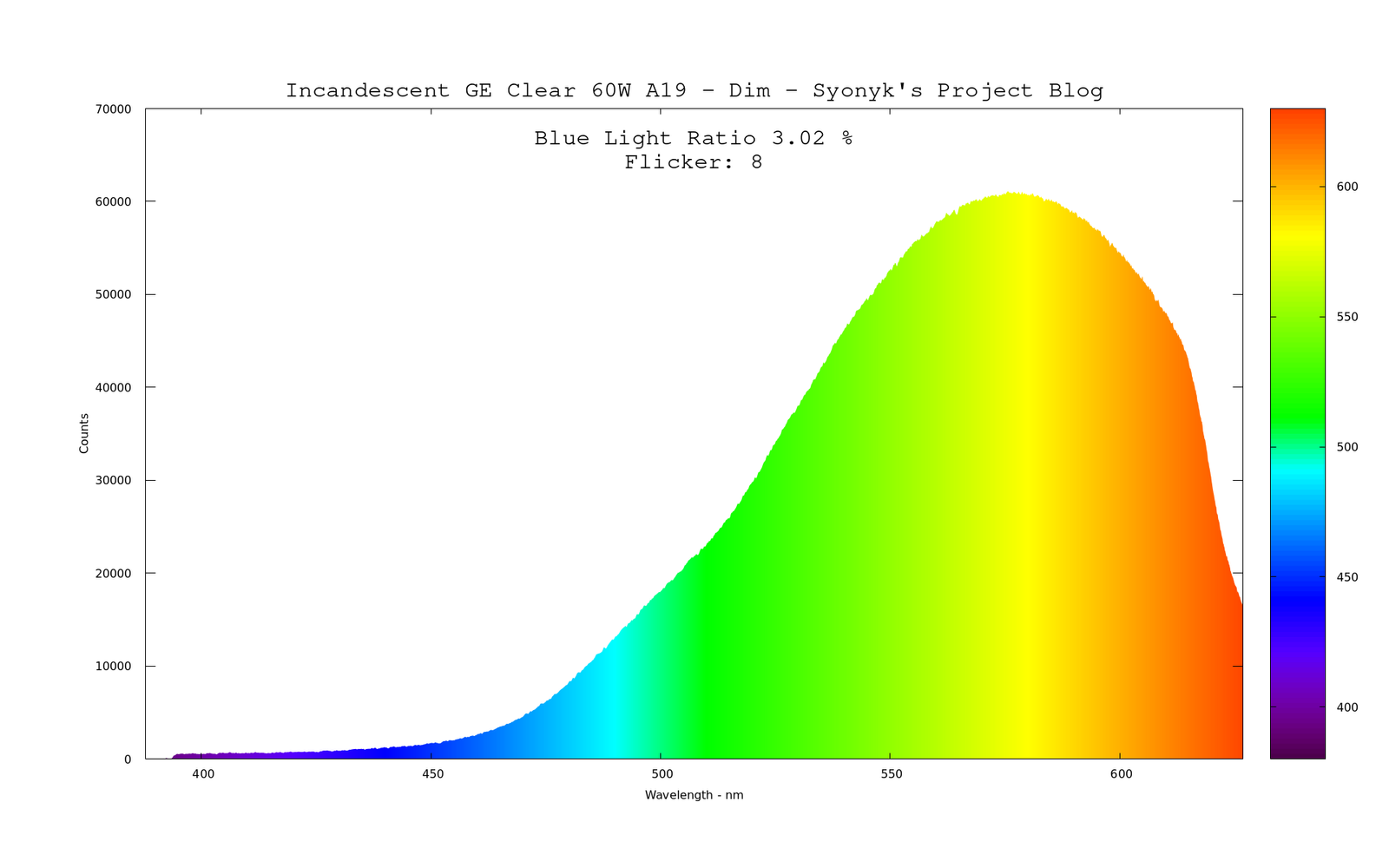
The next bulb here is a GE Soft White - another “standard 60W bulb,” but of the frosted variety. The result is slightly less light output, but it’s a softer, more diffuse glow. This is almost certainly the sort of bulb that was in virtually every fixture in your house growing up, and I’ve got no shortage of varieties of this sort laying around in various forms.
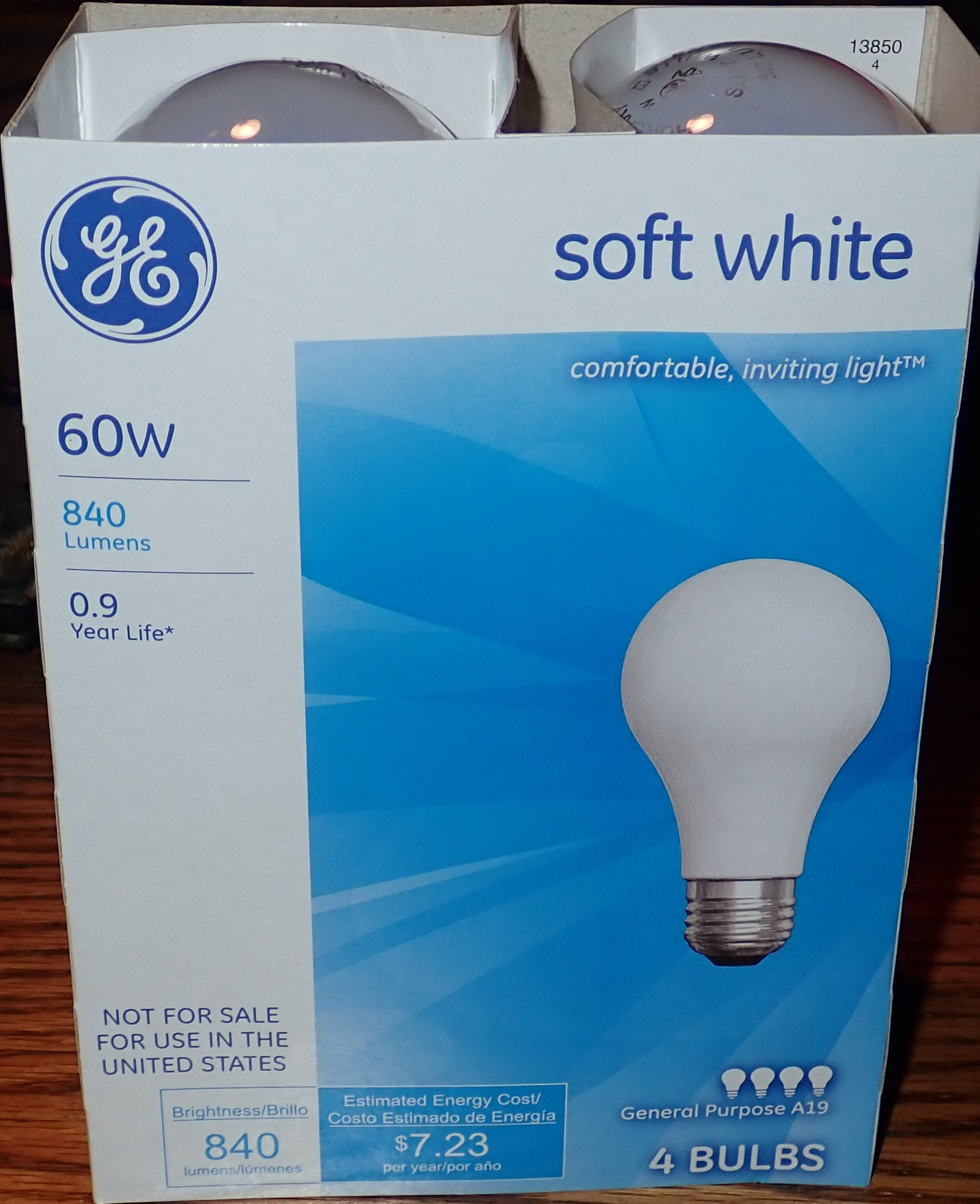
This bulb has a bit of a “line” down the side from the filament supports. At full power, it draws 60.2W - so, should pretty much make rated life.
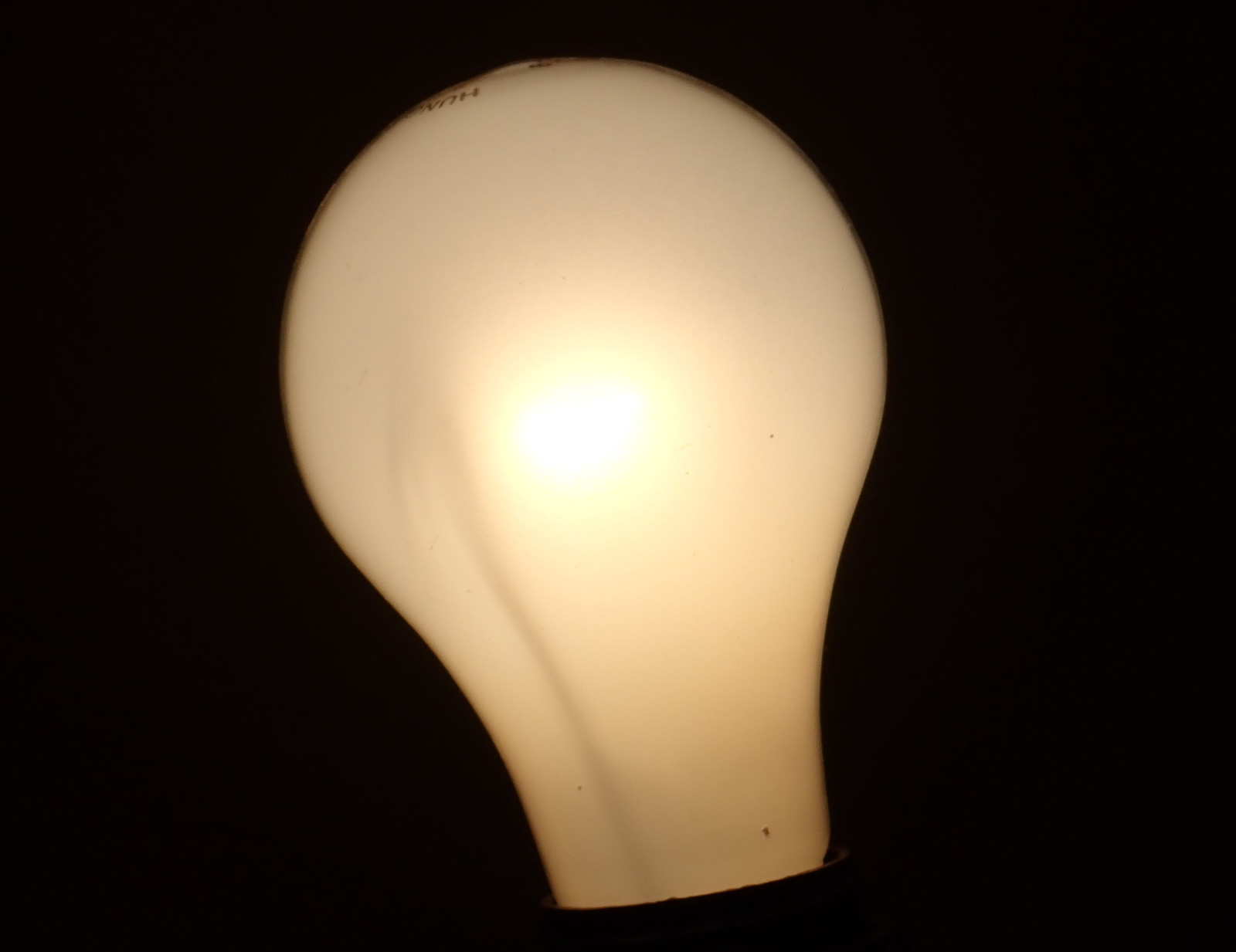
At full glow, you can see the filament - I believe these are a double spiraled filament, so the “wire” of the big coil is actually further coils down smaller - but you can see how the ends are a bit cooler as they contact the supports, and can get a general feel for the nature of this bulb.
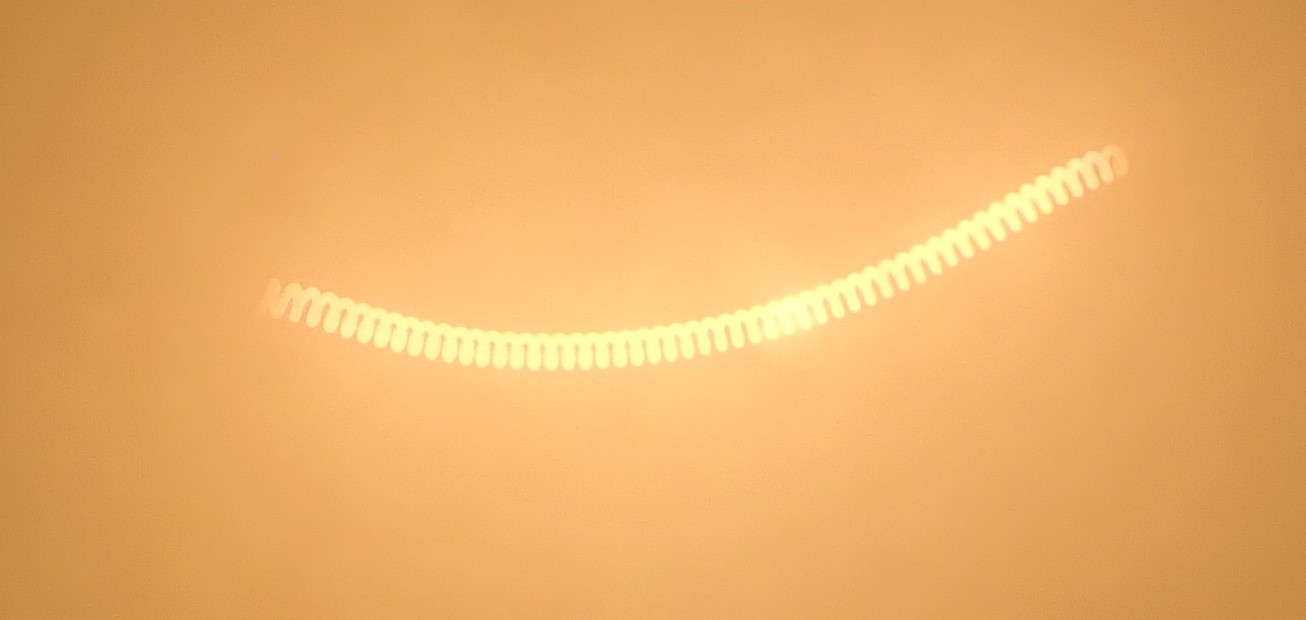
Looking at the spectrum on this bulb, it’s somewhat less blue than the bare filament bulb - this is either absorption by the frosted glass, or just a different filament design that’s not intended to be quite as bright. There are a range of tradeoffs you make in designing a filament, prescribed by the laws of physics - a blue, hot filament will be more efficient (lumens per watt) and short lived, a long lived filament will be (thermally) cooler and less efficient (lumens out per watt in).
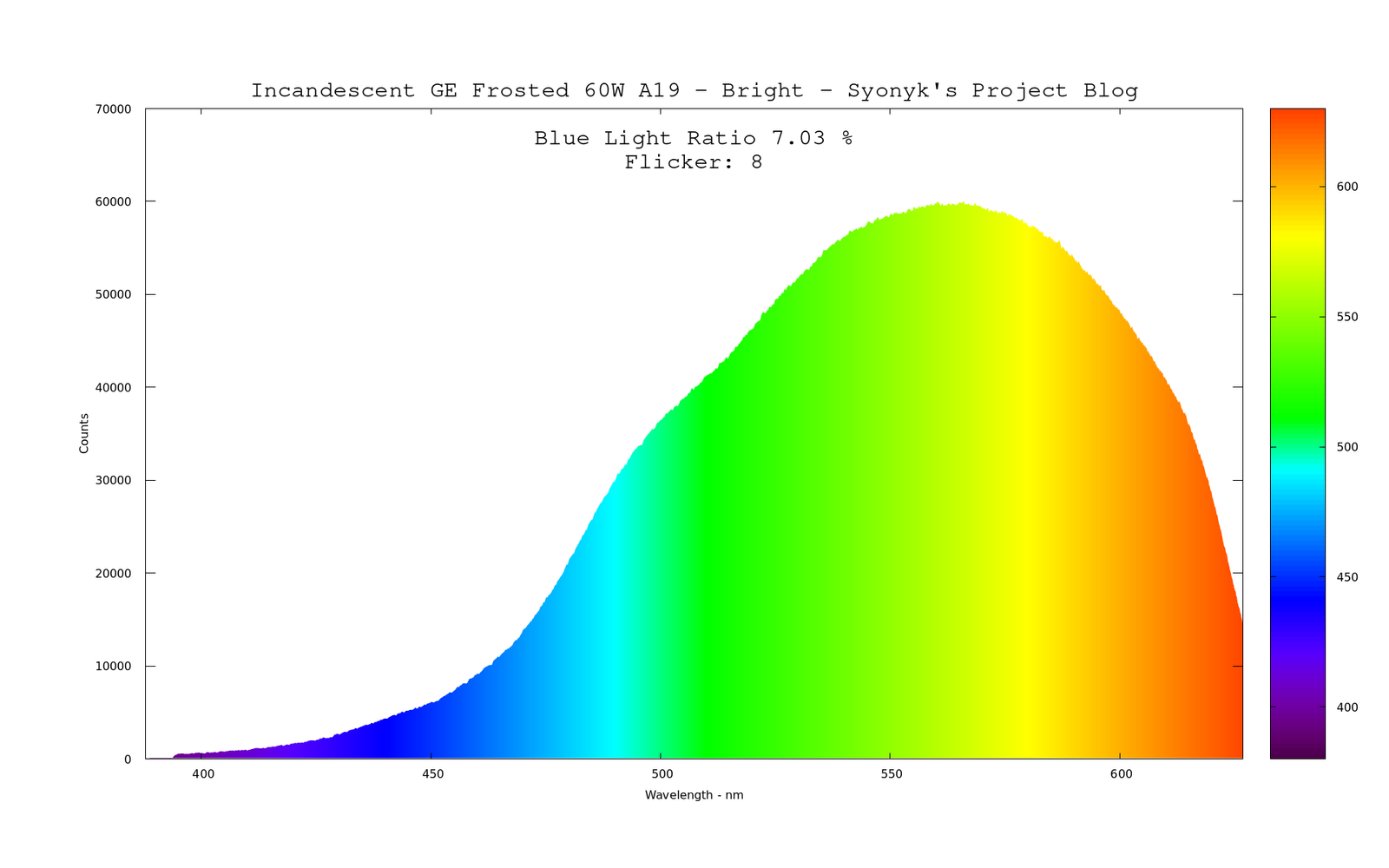
Dimmed, though, you see the expected result - a lot less blue, as the spectrum shifts to the right and into the reds that my meter doesn’t really report well.
Unfortunately, this bulb also sings. Very loudly. The deeper you dim it, the louder it sings. It’s really, really annoying about it. So, yet again, not a bulb to use when you care about dimming, at which point, why bother with an incandescent?
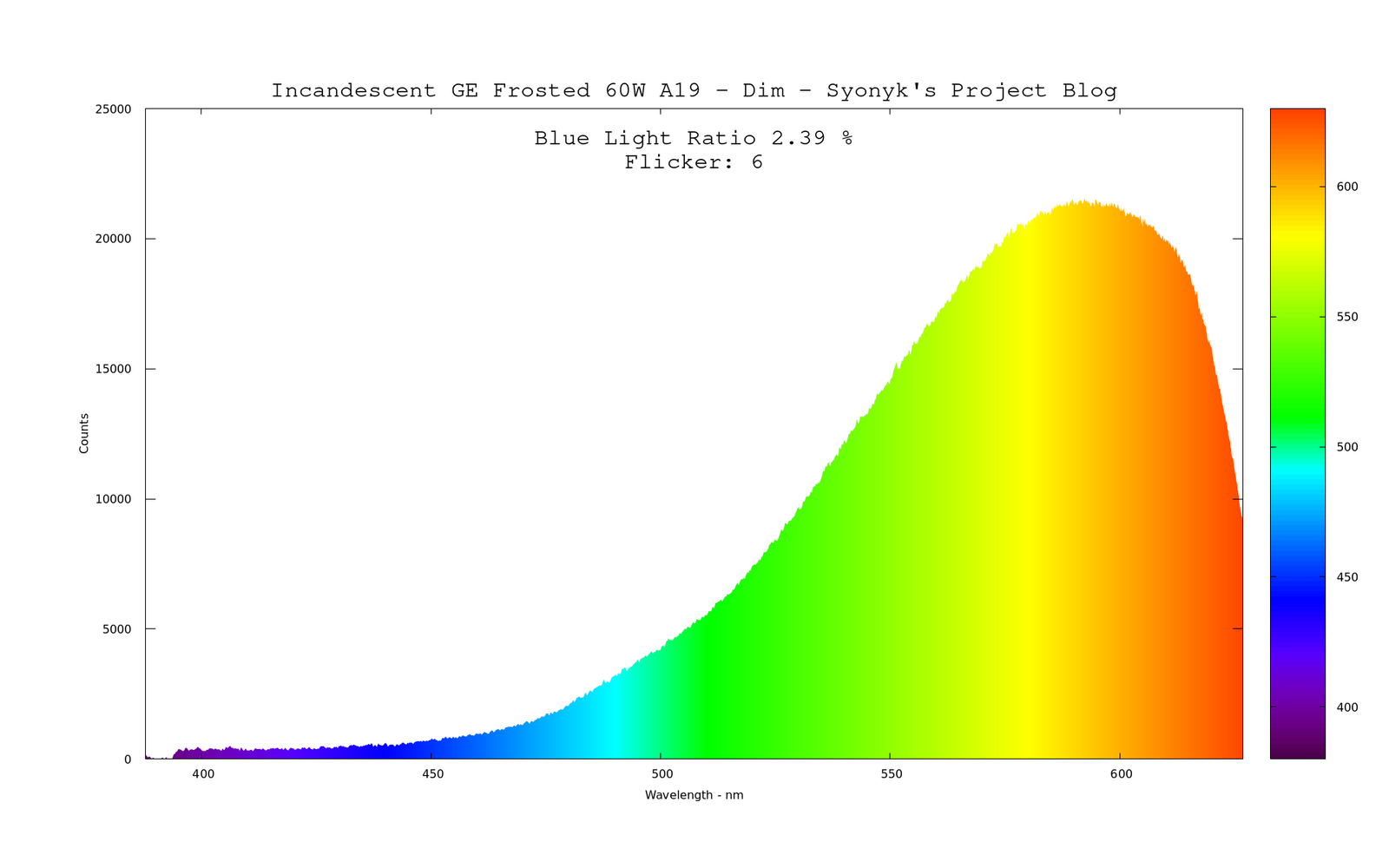
Old Regular Incandescents
However, not all is lost. In addition to the new stock incandescents you can buy, there are also some places selling old stock - and I’ve tested a few of these, as well as some old incandescents I have laying around. I’ve not bothered with the spectrums for these, as they’re basically the same as the others. But they do have some nice attributes - most of them don’t sing!
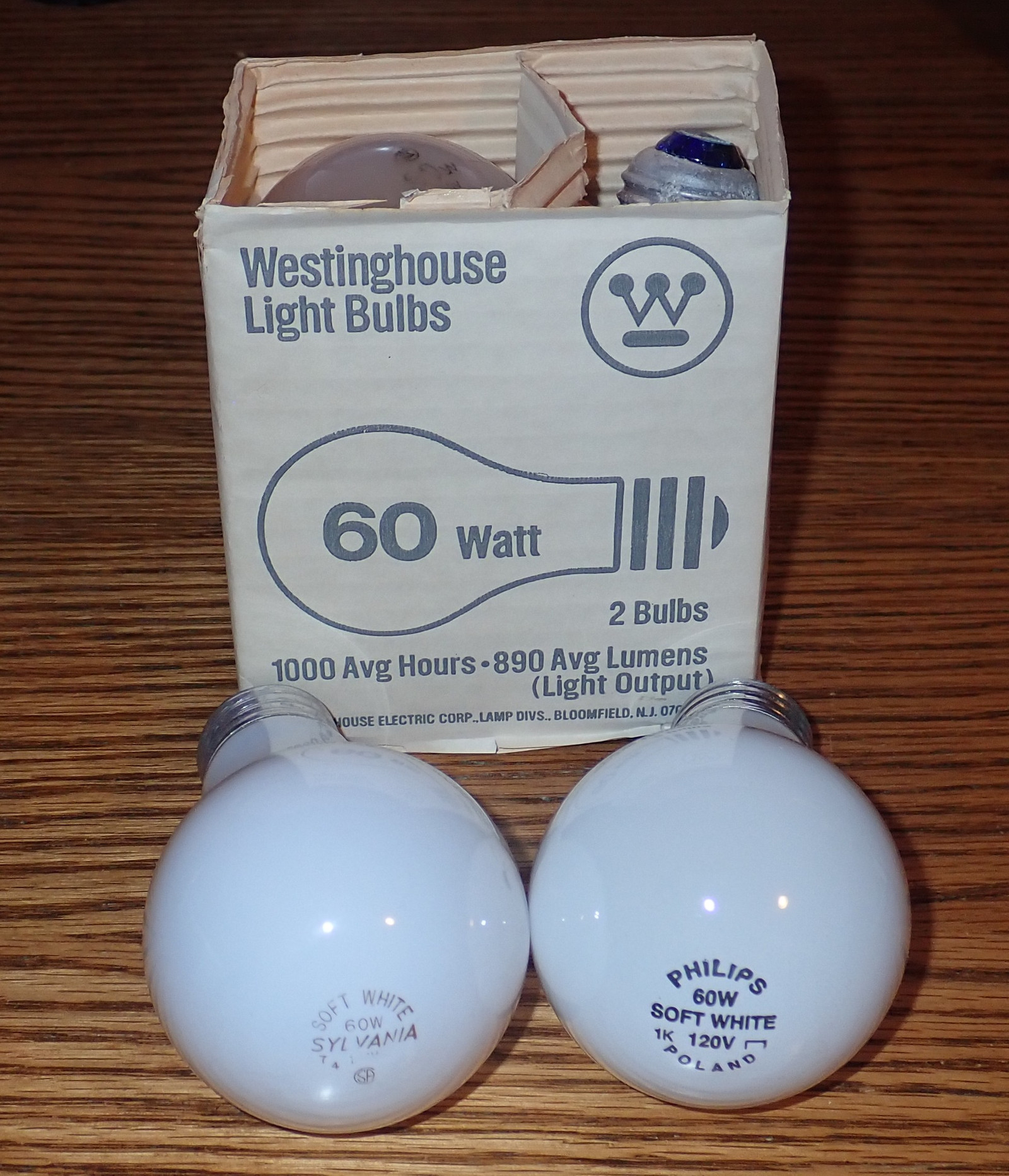
I’ll start with an old Sylvania Soft White 60W. It does a better job of hiding the filament support shadow - I promise, I’d never even thought about this aspect of bulbs until I started looking at some of the new ones, because the older ones do a far better job of hiding it. It pulls 61.5W under normal wall voltage, but, oddly enough, it buzzes when dimmed. It’s not the same high whine as the newer ones - it’s a lower frequency, sharper buzz, but it does it, and it’s more than loud enough to hear. Bah.
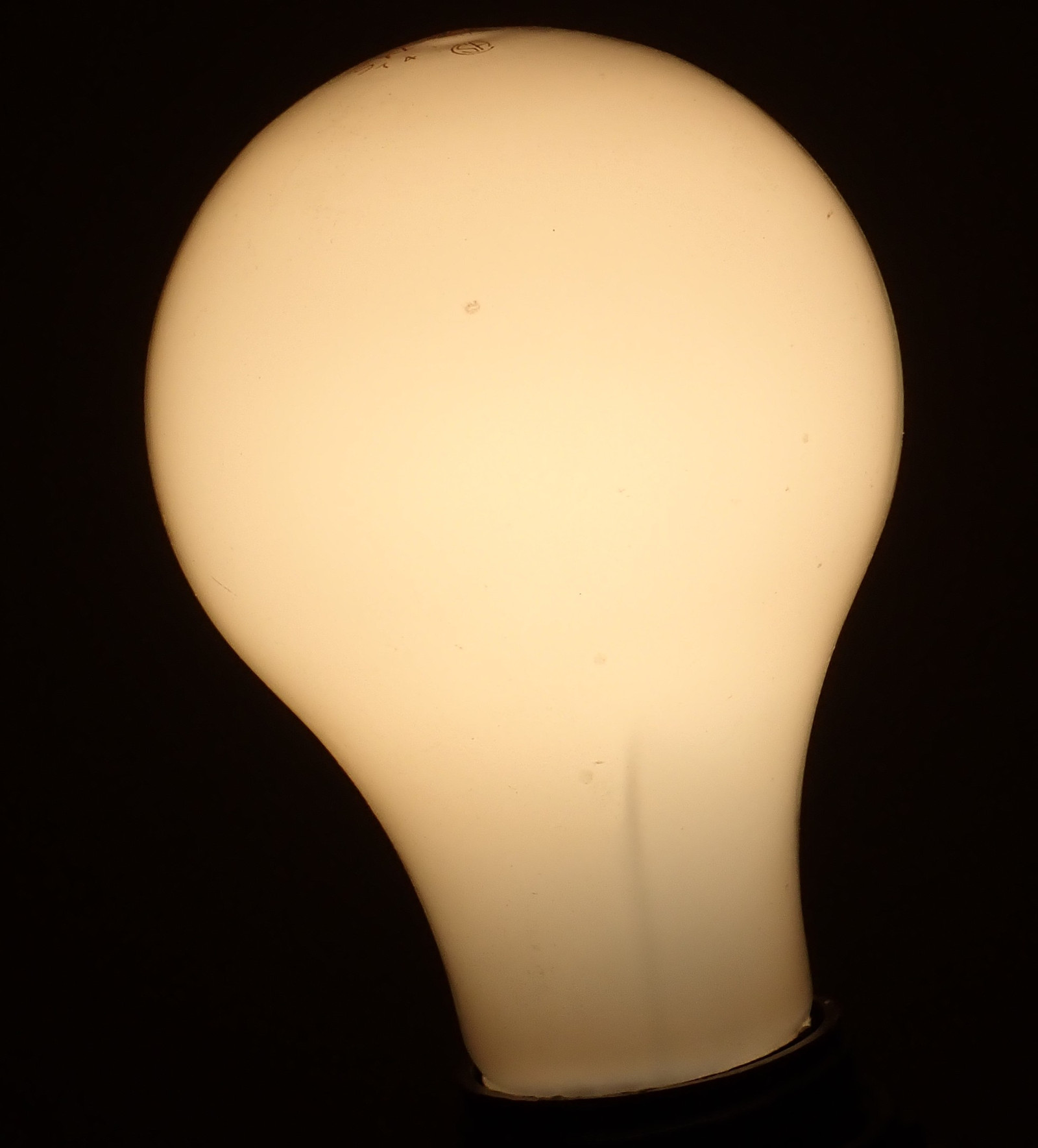
Moving on, I’ve got an old Philips 60W Soft White. It pulls 61.7W from the wall, and, joy of joys, it doesn’t sing! It doesn’t make any noise at all on a dimmer, which is one of the “standard features of a bulb” that I didn’t even realize mattered until this post!
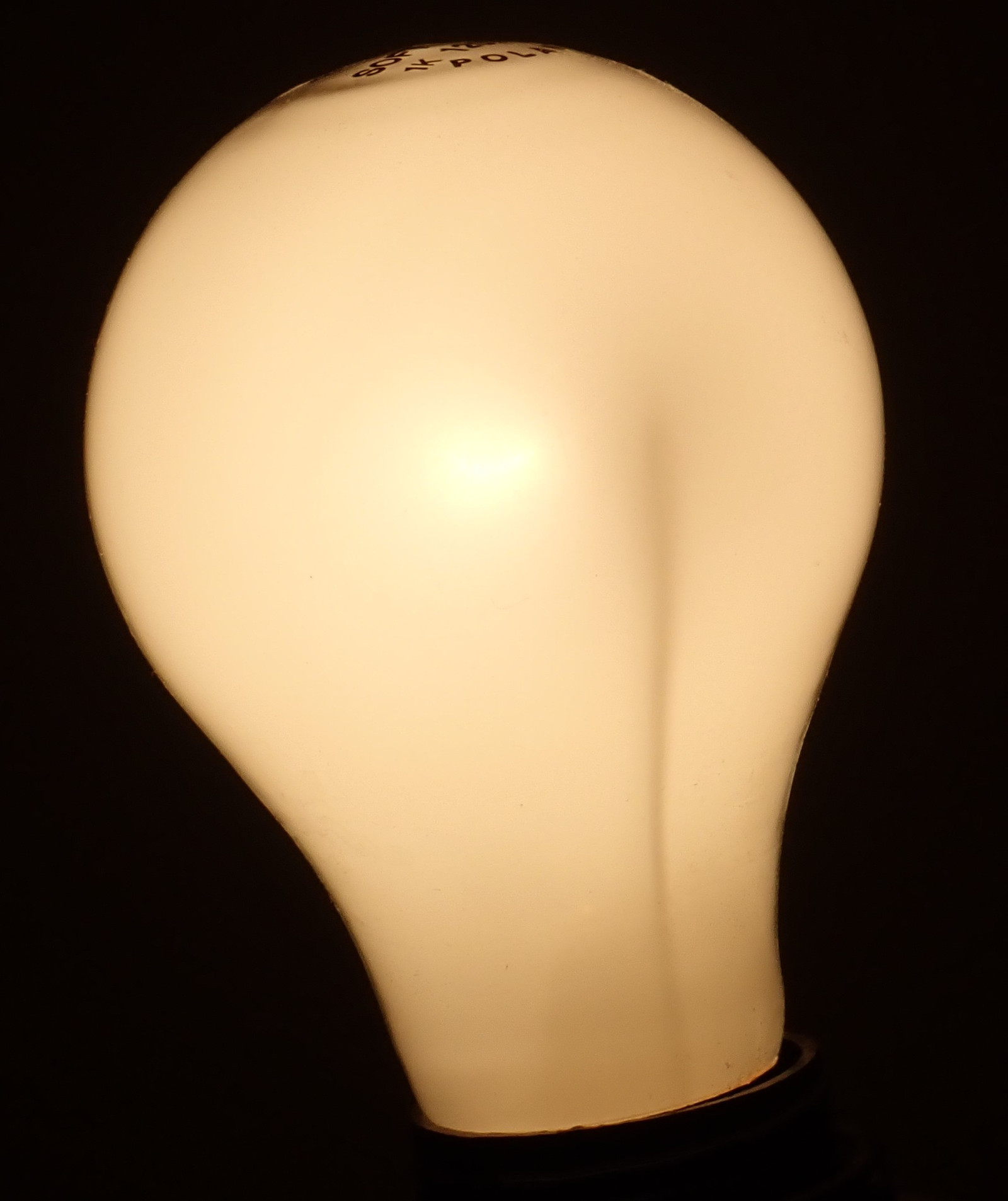
Finally, I’ve got some rather old stock (I’m not sure when these were made - sometime between the 1950s and 1980s, but based on the packaging, I’d wager towards the older side of that) Westinghouse bulbs. Made in the USA, rated 1000 hours, and on my line, pull 60.2W - spot on, though as they’re rated as 130V bulbs, I’d have expected them to pull a bit less. In any case, these don’t sing either!
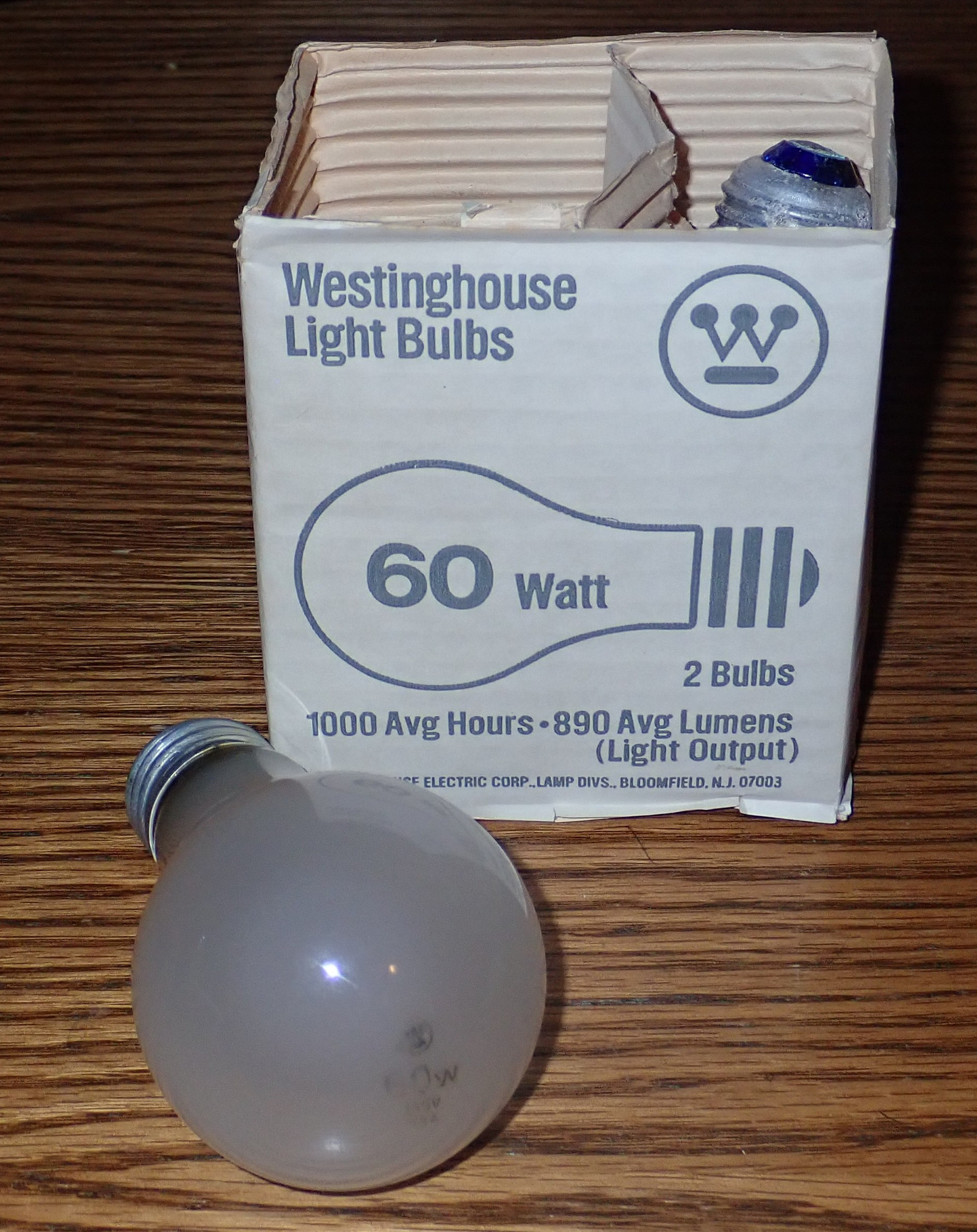
Lit up, you can see a bit of filament shadow on the side, but what’s more interesting is that the bulb, while not being clear, doesn’t go out of its way to try for an even illumination over the surface. You can see there’s a filament glowing within it, and it doesn’t fill the whole envelope with light like most of the other designs do.
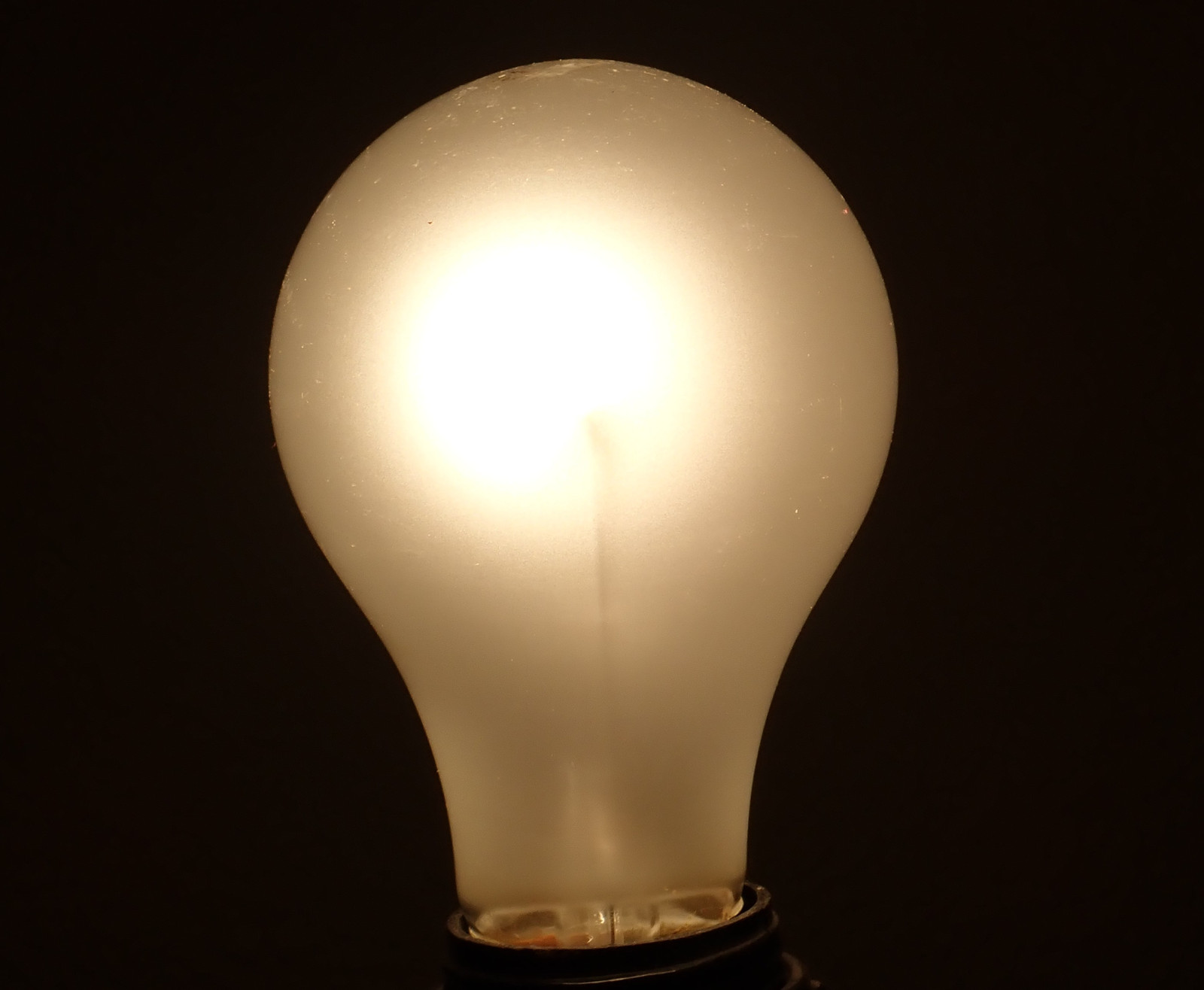
I’ve pulled the brightness down a bit, looking at the bulb from 90 degrees off the previous shot - this is a bit more how it looks when dimmed, but this bulb is proud to be incandescent, and it’s going to show it off to absolutely everyone who looks at it. You’ll see me grumble below more about some of the weird shadows that the modern halogen capsule bulbs cast, but this bulb is one to show off. If you have exposed lights somewhere, where people see the bulb? This is a beautiful, beautiful bulb to show off with. It dims nicely, it’s dead silent, and it’s just amazing to look at. Even holding the bulb, it feels a bit different. It’s a bulb of a different era, and that shows in every single aspect of it.
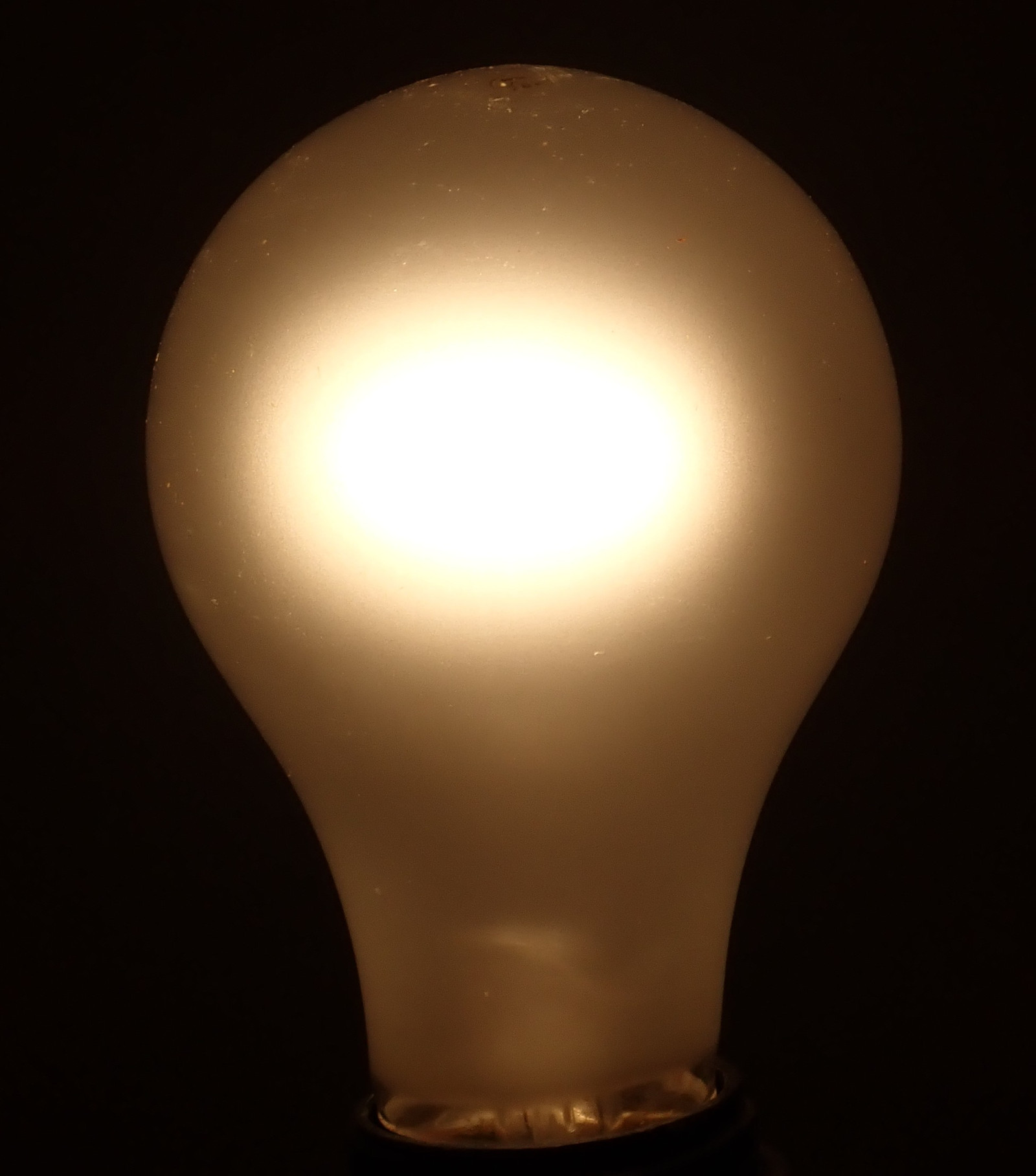
You can (hopefully) still find them on eBay here. Failing that, bug me, I might be willing to sell you a few.
The Modern Halogen Bulbs
If you were to try and buy incandescent bulbs at your local retailer last year, you’d find a lot of “more energy efficient” bulbs (though as of posting, you won’t find these at US retailers anymore because they don’t meet the new energy efficiency standards, and the Biden administration decided that they’d actually put teeth behind them, instead of ignoring the few people who still bought incandescents as has been going on for years). These typically claim to be the same light output as a 60W bulb, but only use 43W - and what they are, internally, is a little halogen bulb capsule in the larger outer envelope. A halogen bulb puts a tungsten filament in a small capsule, and fills it with a gas that helps redeposit the evaporated tungsten on the filament - extending the life, allowing you to run it hotter and more efficiently, or both. They also tend to run hotter, which is why they were banned as fire hazards in many dorms and apartments. These bulbs enclose the little capsule with a normal sized light bulb shell, so they don’t have that problem.
I’ll start with the Feit Electric Energy Saver Halogen. This claims to save 28% in energy vs a normal 60W bulb - and I expect it does. However, it’s also 11% less light output - so the savings may be there, but it’s also somewhat less light. Though you’ll see worse.
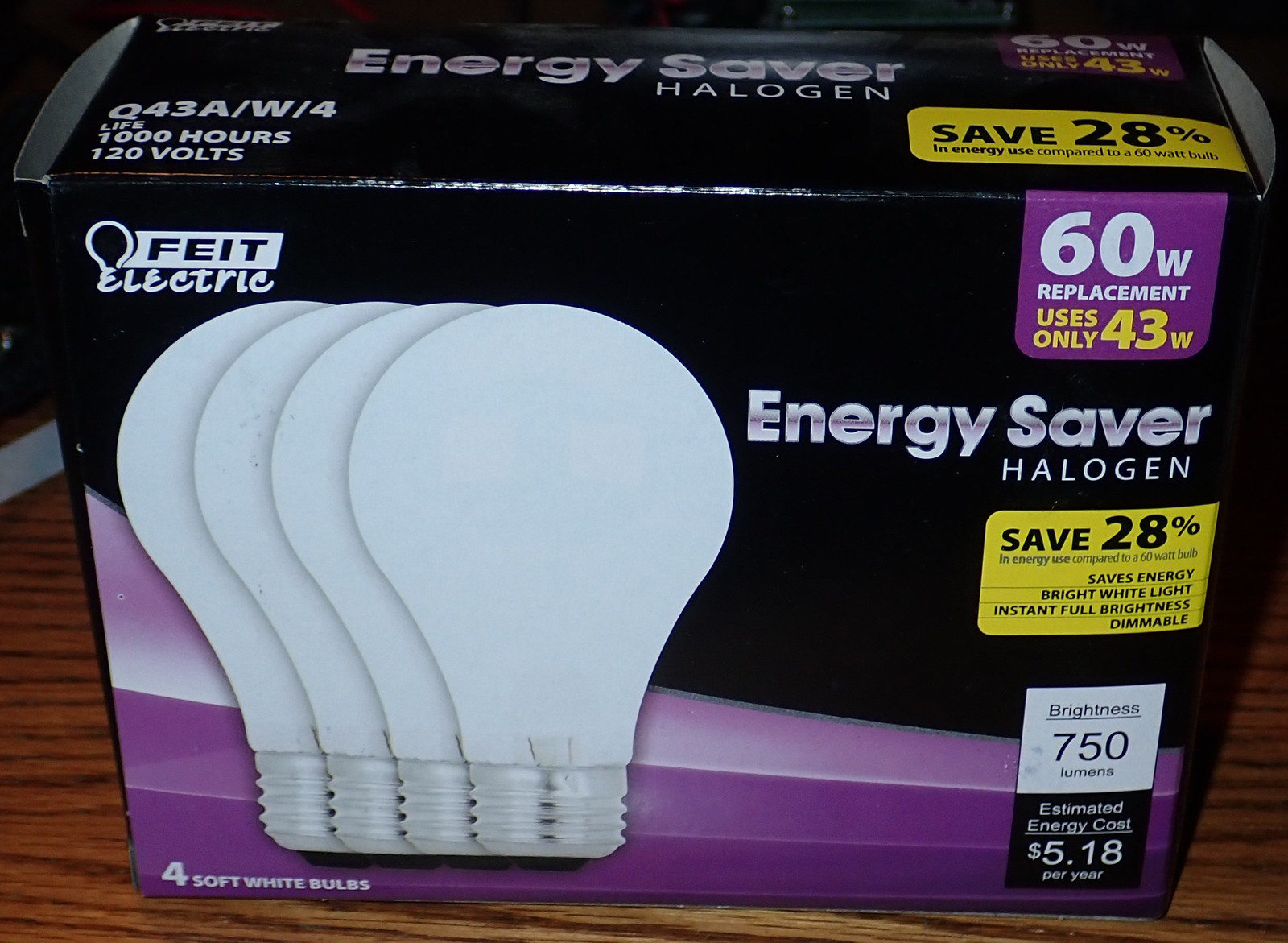
I… have my questions about their description here. A halogen bulb absolutely is still using a filament and heating it to glowing - but, I suppose, if you tell marketing they have to fill a box with fluff, they’ll find some way to do so. By the way, marketing? Please stop using this glossy clay covering on cardboard. It makes it a lot harder for the recycling companies. How about using a biodegradable ink on a plain brown cardboard box, please? Nobody is keeping your box around after they’ve installed the bulbs, and a lot of us will actively prefer plain, easy to recycle or reuse boxes over this sort of glossy trash.
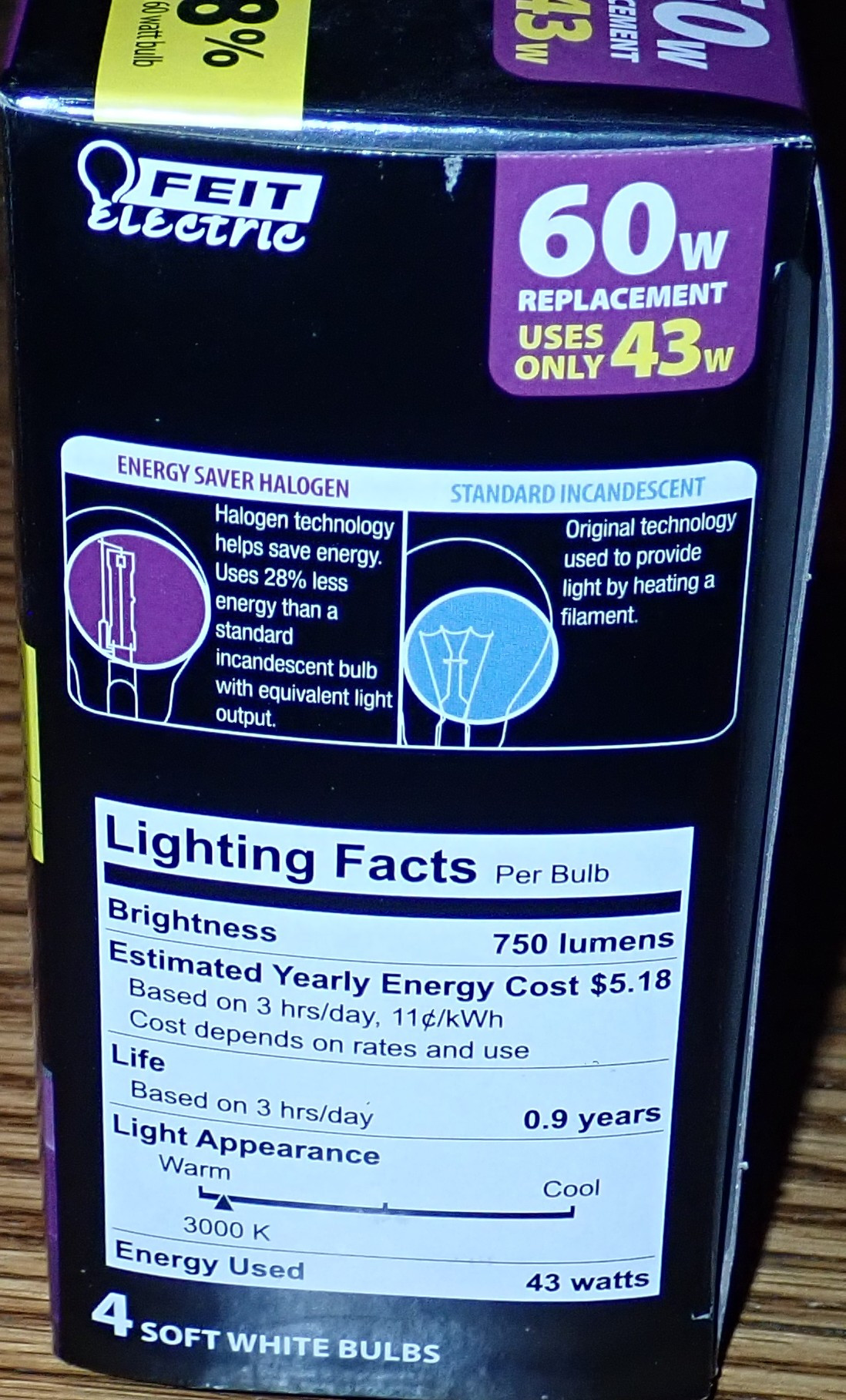
With the bulb lit, it pulls a rather as-rated 43.5W, although there’s a rather weird (and off-center) shadow up at the top, and you can see some full shadow lines around the side. It’s fine if the bulb is hidden behind some other layer, but I wouldn’t use this as an exposed bulb. The light pattern in it is quite ugly, really, and that’s a shame. Older style incandescents have a smoothly lit envelope without odd shadows - scroll up if you’re not sure what I’m talking about there. You can see the glowing capsule in the center from the side, but there’s really no point - with the ugly shadows around the rest of it, it’s a good bulb to keep hidden.
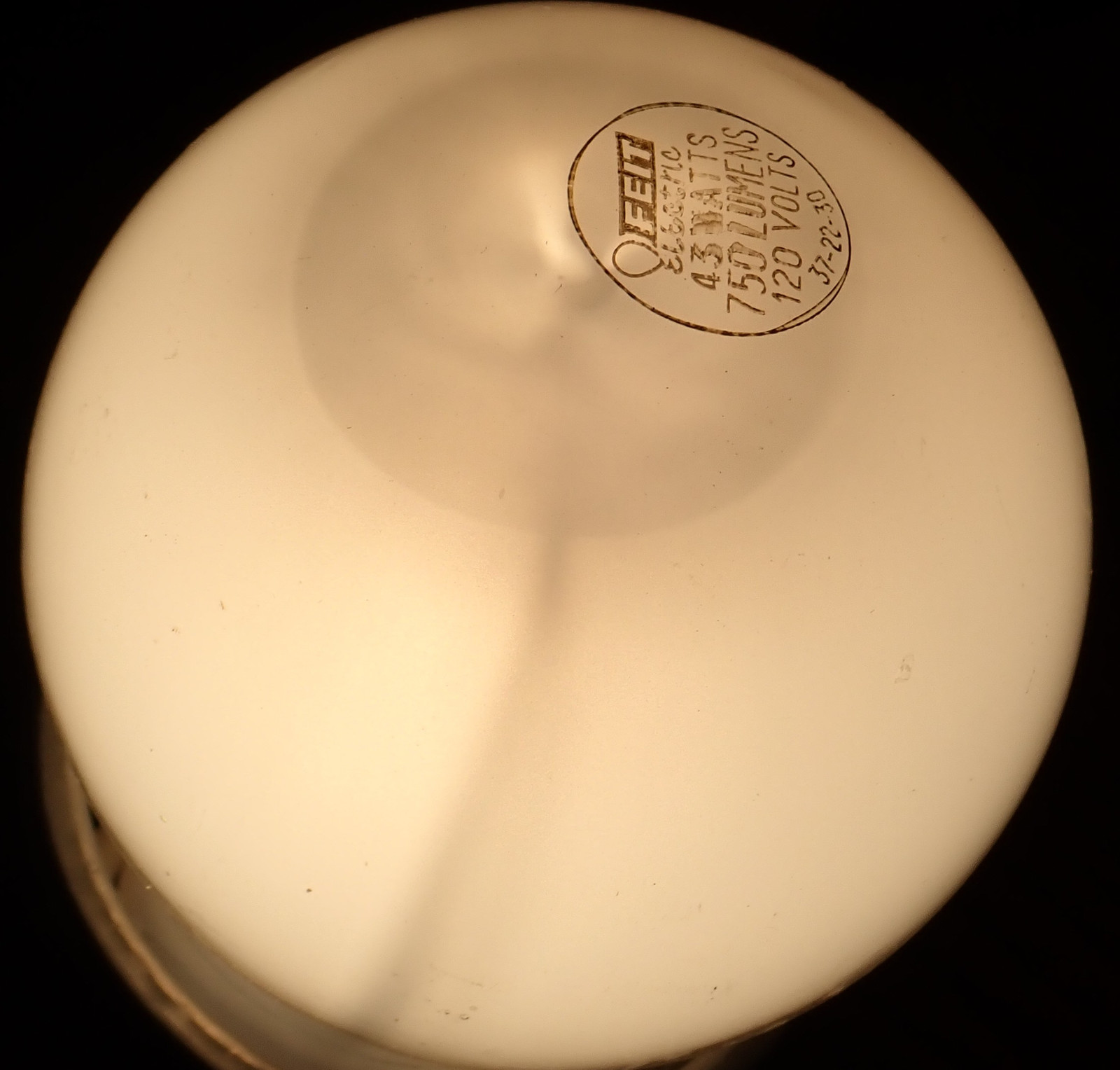
Spectrum-wise, you should be used to this shape by now. It’s a regular incandescent bulb, with no special filtering or anything else.
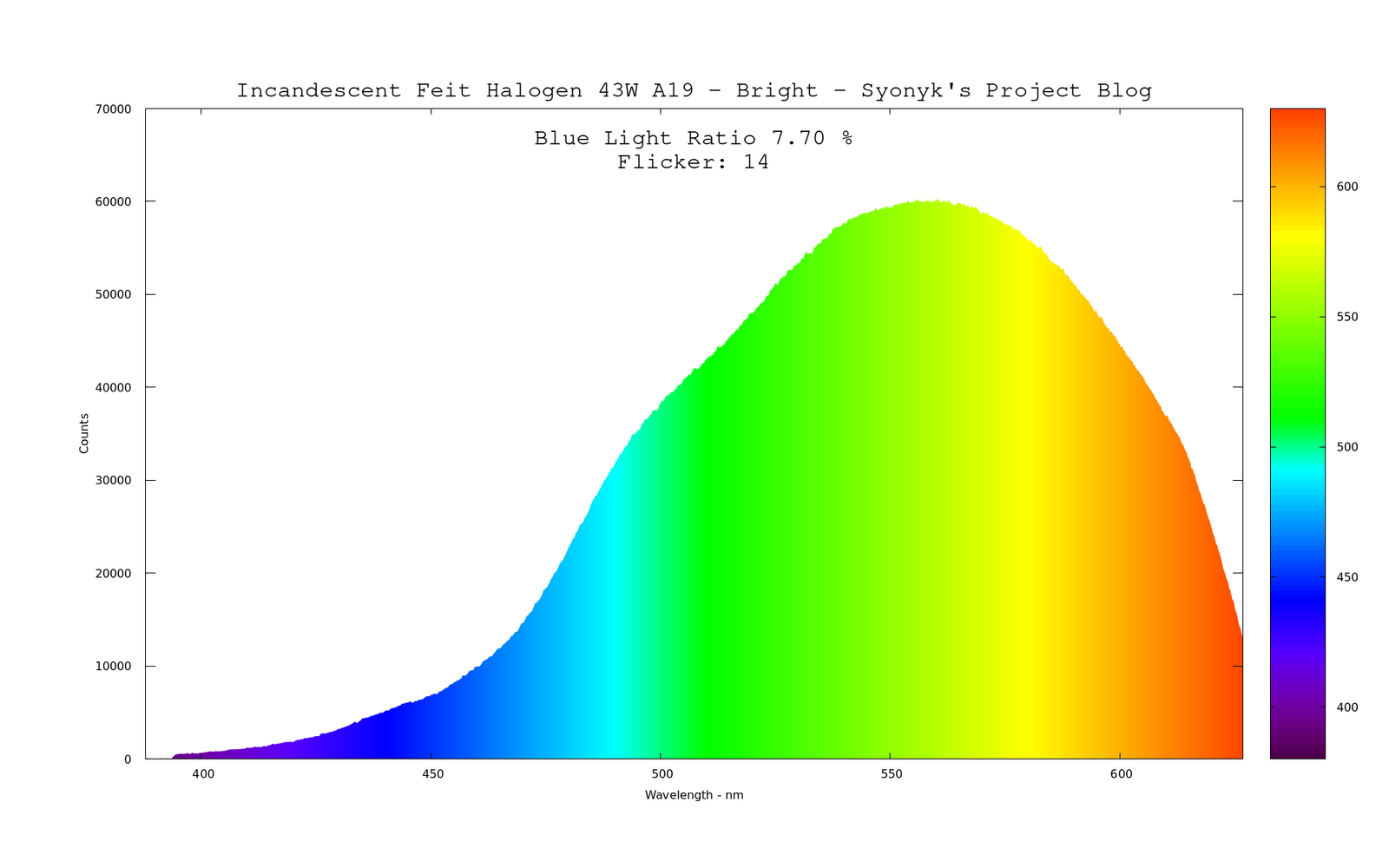
And they dim just fine without singing - although there’s still a good bit of blue in these as you dim them down. It’s better than full bright, for sure, and it’s better than most LEDs, but not by as much as I’d hope. The smaller, hotter filament seems to put out more blue when dimmed.
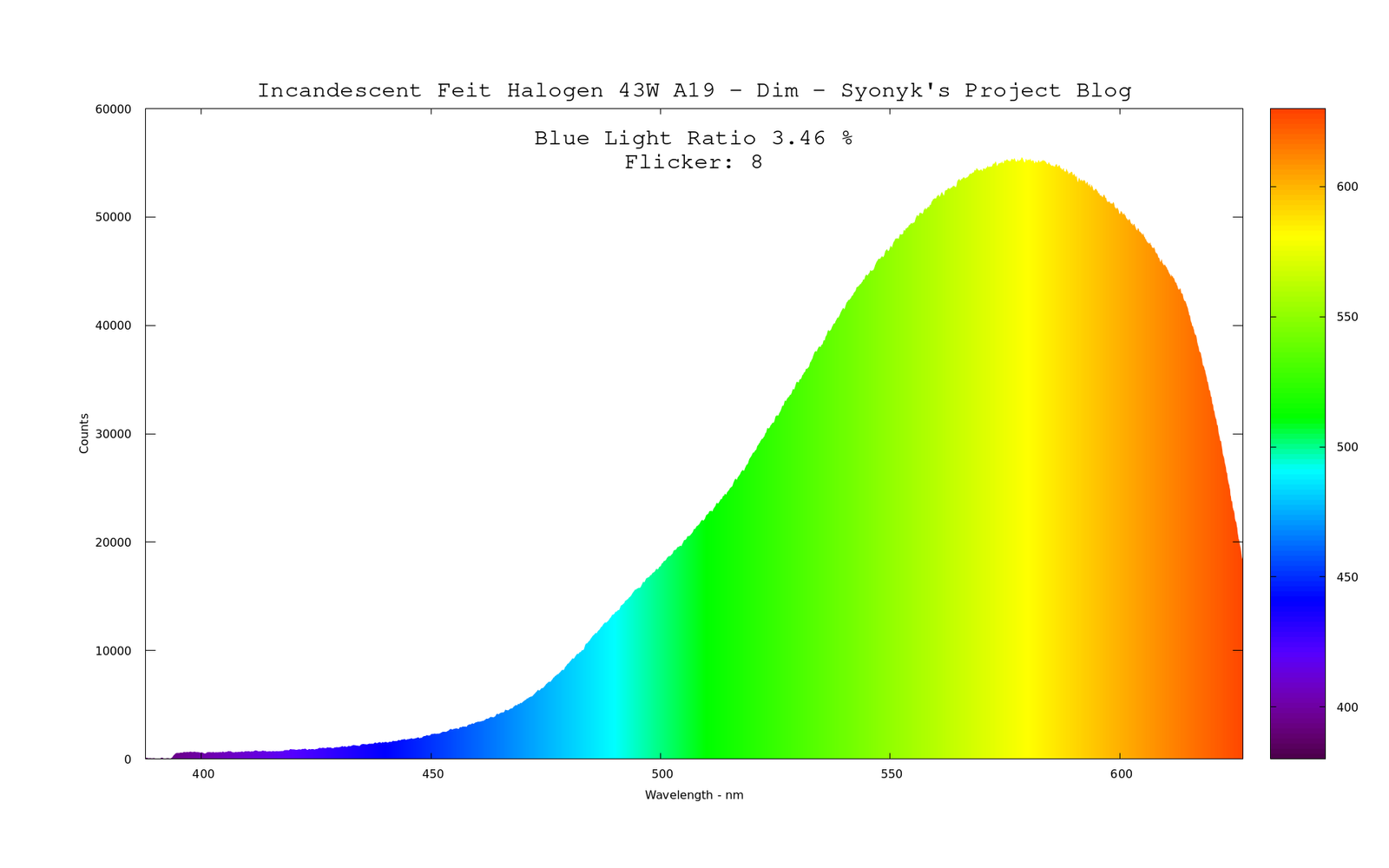
Next on the plate, the Ecosmart Eco Incandescent. Same story, different company - and a question I had going into this post was, “How much white-label bulb reselling is there?” Are these all the same bulb, in different boxes?
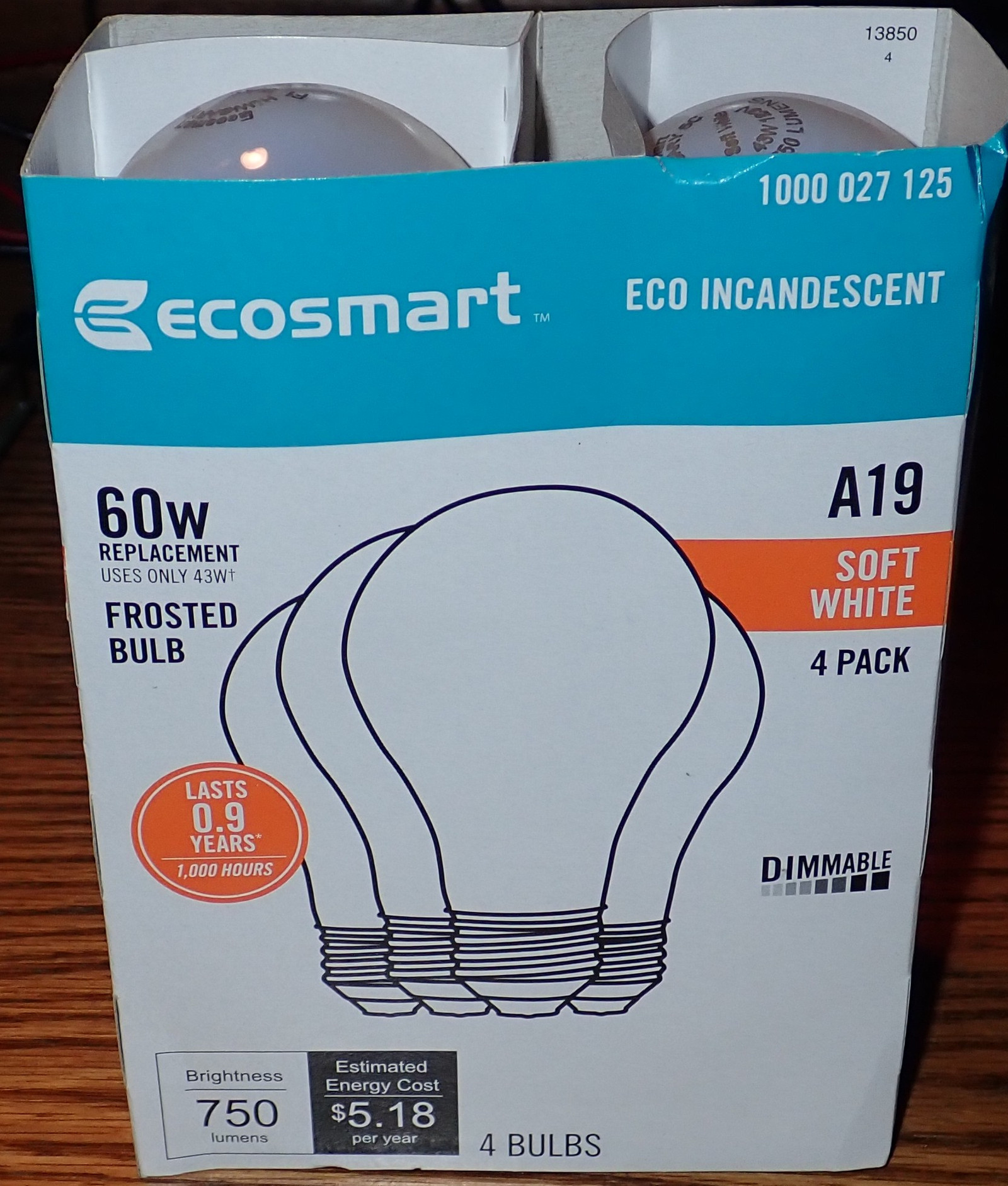
All of the halogen bulbs come with a similar warning about operation with the outer envelope broken. You could shatter the outer envelope and still use it, but now you’ve got a very high temperature capsule that can ignite things. If the big bulb shell breaks, chuck the bulb. It’s also worth noting that if you’re planning to dim a bulb deeply, on a regular basis, halogen bulbs may not be the best idea. They don’t like low temperatures for long periods of time, and will tend to start blackening the envelope if they don’t get hot enough to recycle the tungsten. Sometimes they’ll reset this if you run them hot for a while, but if it’s too bad, they won’t fully recover. Yeah, it’s dimmable, but it’s not a great bulb for a deeply dimmed situation in the evening.
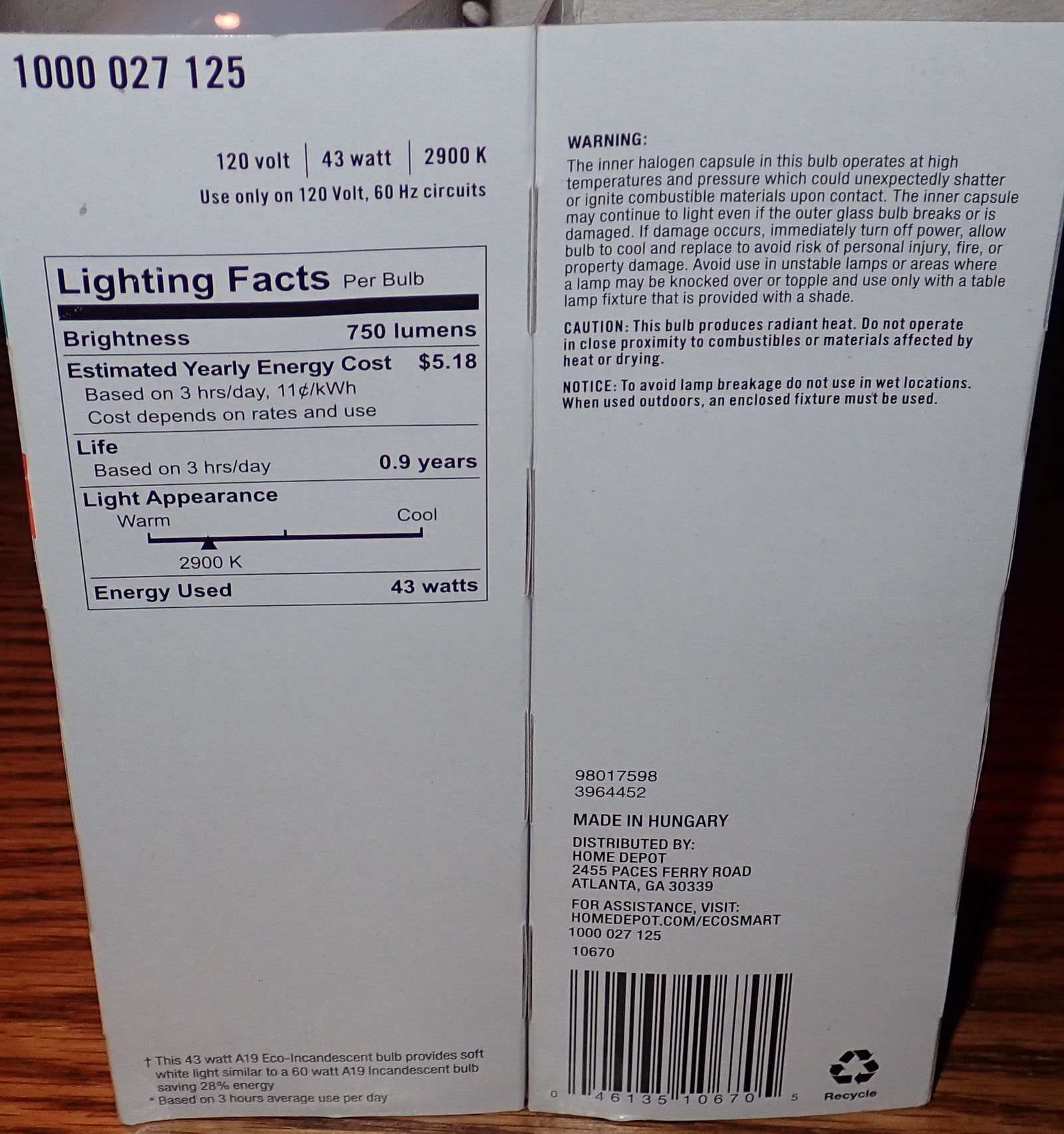
As for whiteboxing, though? They’re all rather different bulbs. This one has a quite visible double filament running around the interior capsule! Does it matter? No, but it’s strong evidence that all these bulbs are, in fact, different bulbs by different manufacturers. Again, though… you see this through the outer envelope. These aren’t great bulbs if the envelope is visible.
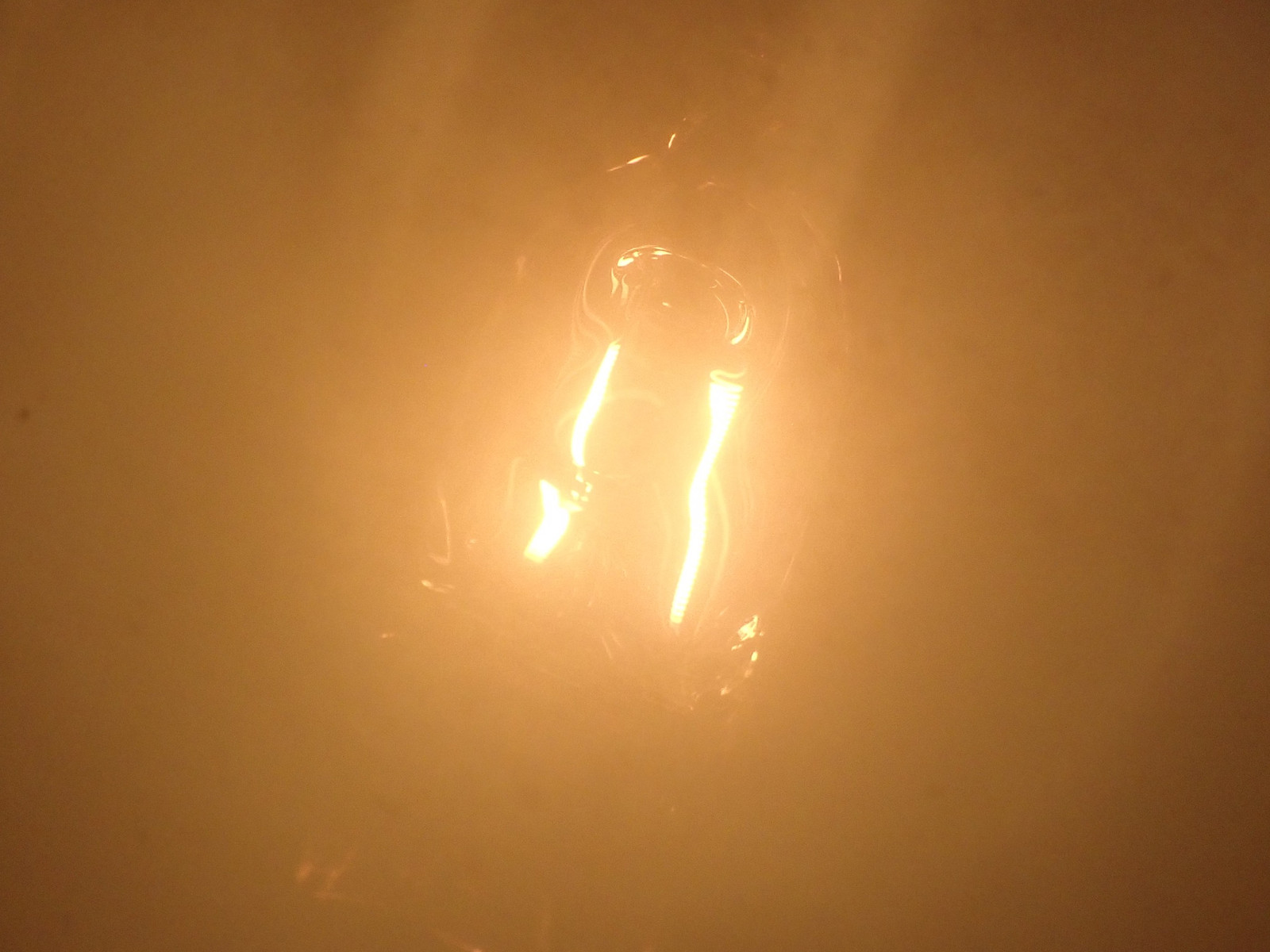
It pulls 43.6W running, and dims silently, but in addition to being able to clearly see the double filament capsule in the center, the end has all sorts of funky shadows going on from the double filament. Again, it’s fine as a bulb to dim without driving your ears nuts, but it’s not one you really want to expose for people to see - unless you’re into weird bulb lighting effects.
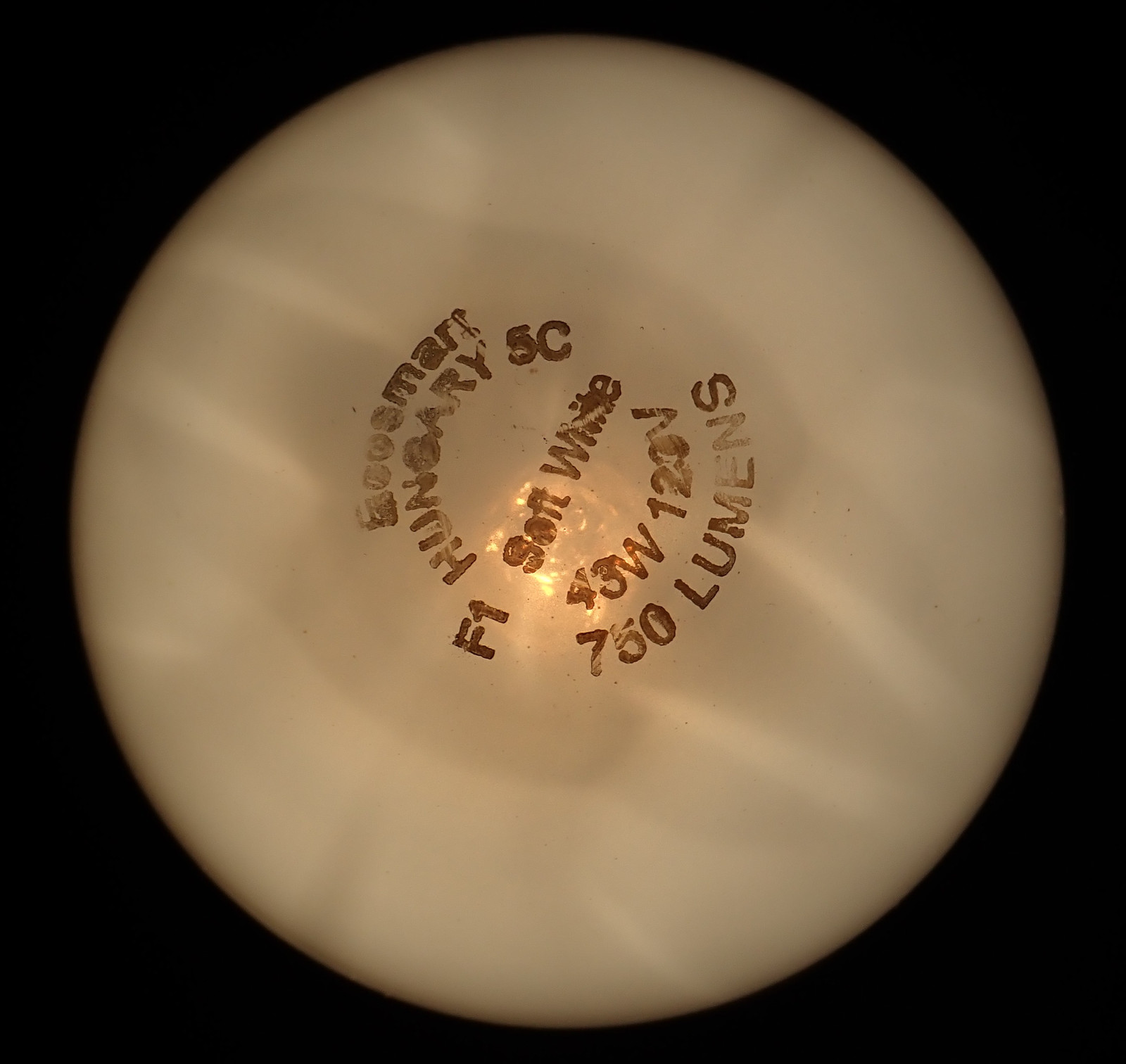
Spectrum-wise, though, it’s a halogen incandescent. Nothing of note here.
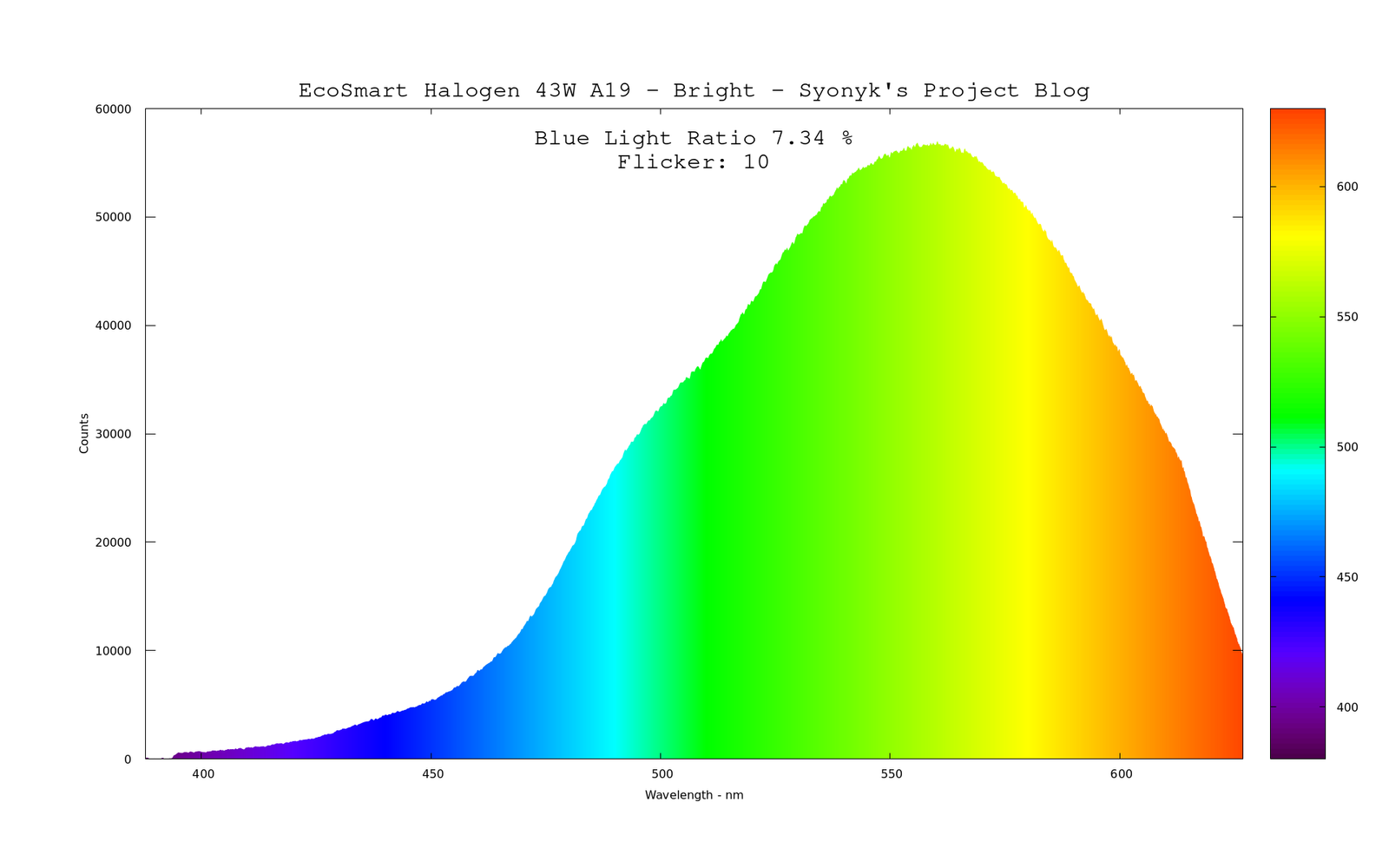
It does dim pretty well, though, with a nice reduction in the blue over the other halogen capsule bulbs. Just be aware that for deeply dimmed bulbs, the halogen scavenging cycle isn’t working (it’s too cold), and they may blacken the envelope somewhat and need high power operation to clear it. It’s actually a lot like lead fouling on aircraft spark plugs if you don’t ground lean hard. Some time at full heat (usually) fixes the problem…
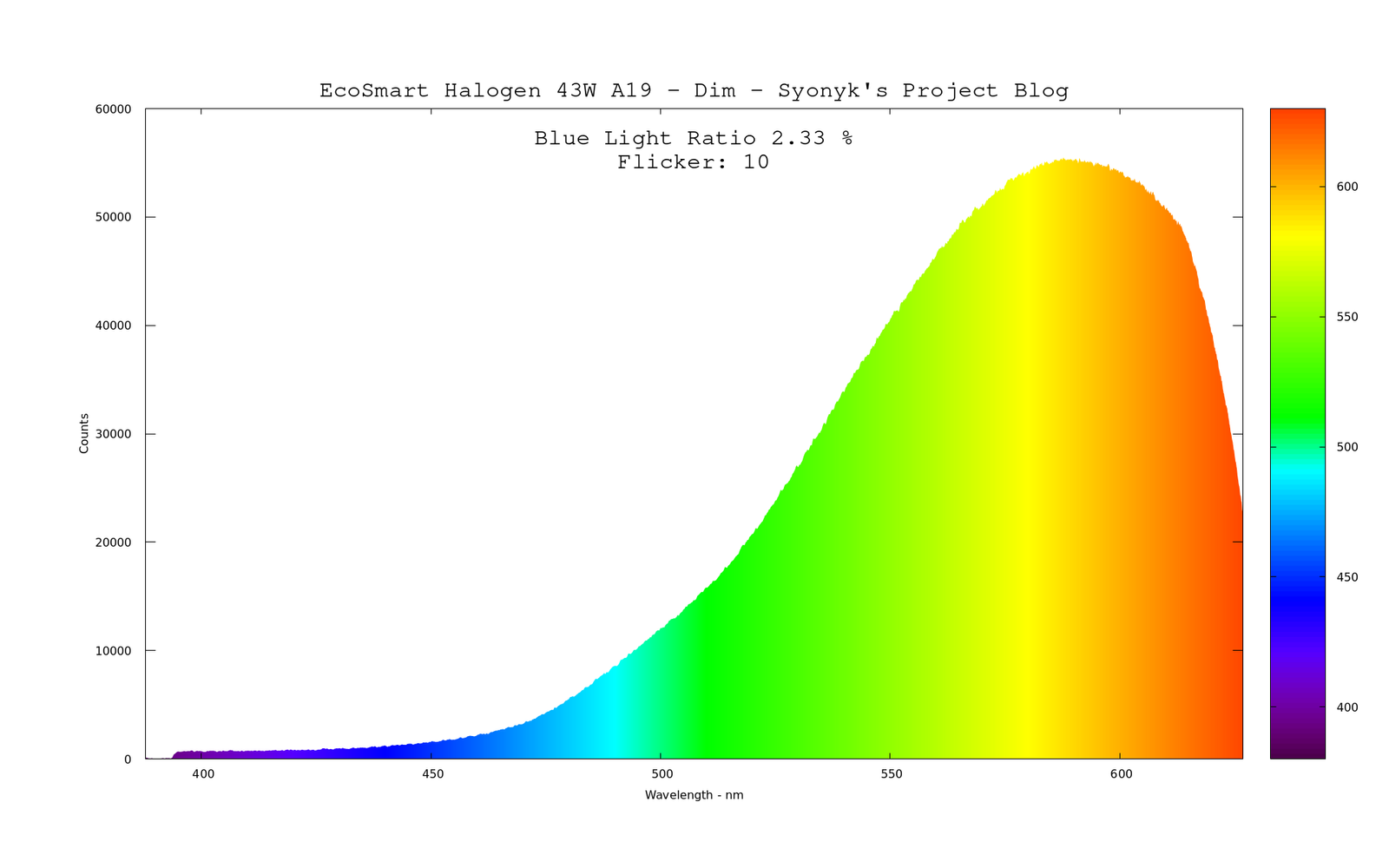
Finally, GE’s Soft White Halogen. It’s kind of special, really. Only uses 43W, saving 28% on energy. Also only produces 620 lumens vs (by their own box!) 840 lumens for a regular 60W, which is… 26% less light. And if you compare it to the actual output of other 60W bulbs, it’s even worse. So, yay? Sorry. I’m not impressed here.
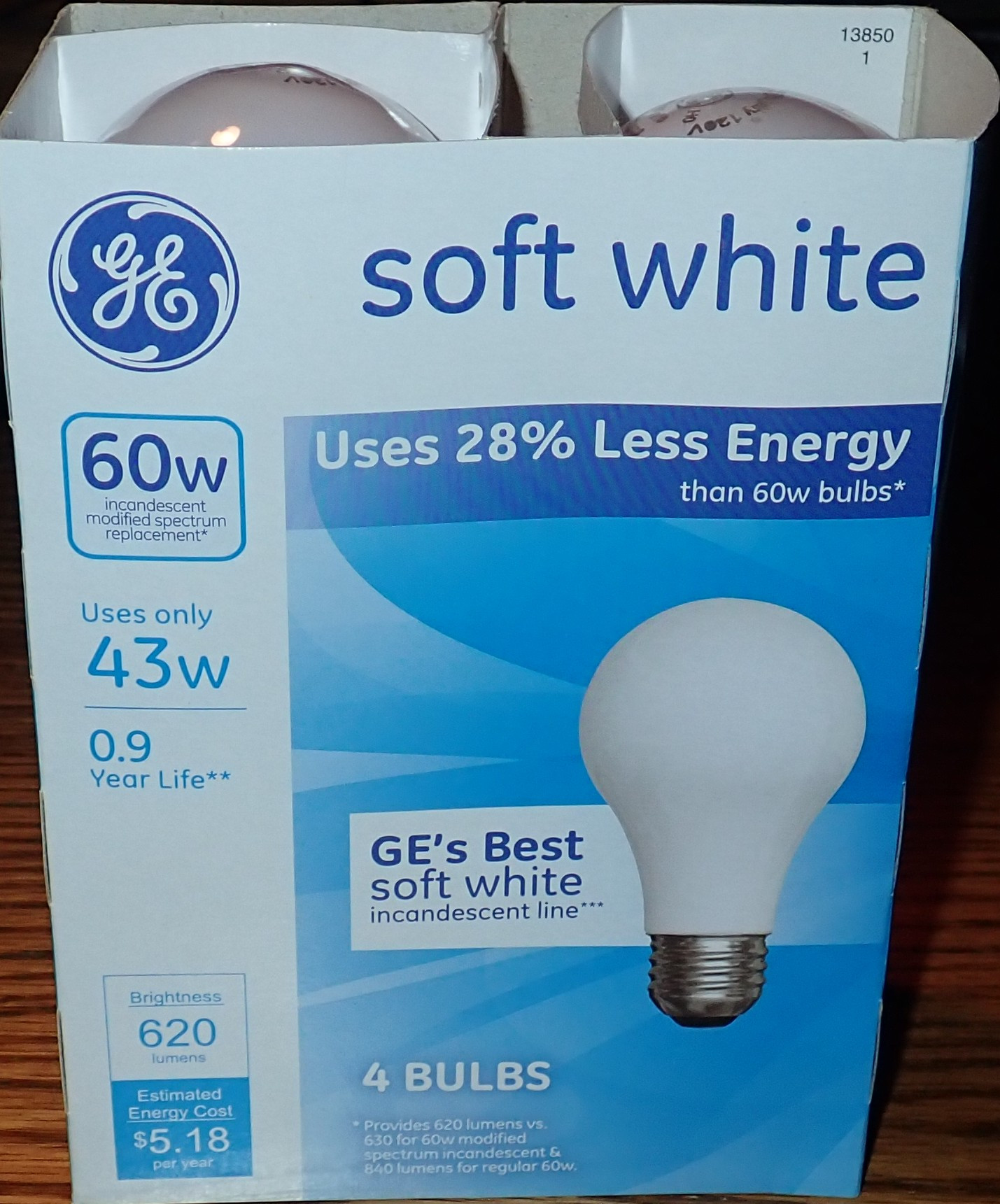
“Warning: Do not use this bulb. No, really, we warned you.” Well, I can’t argue. It’s not an impressive bulb by any metric.
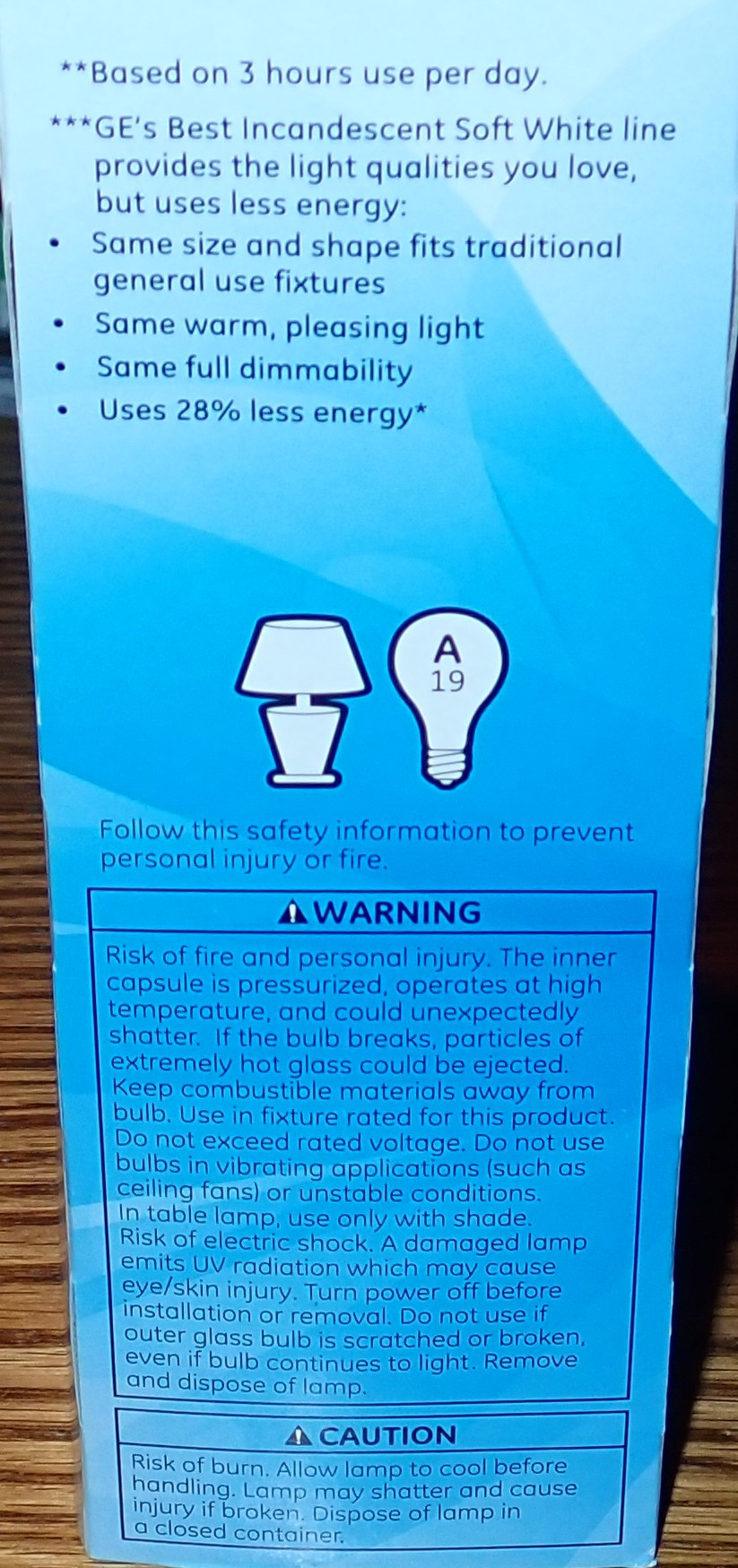
This one pulls 44.5W running and doesn’t sing at all. I’ve pulled the exposure down here a bit so you get a sense of what the bulb looks like. It has a strong single filament visible at the base, and some strong and uneven shadows around the rest of the envelope. Again, it makes light, it dims fine, but it’s just not a pretty bulb to have exposed.
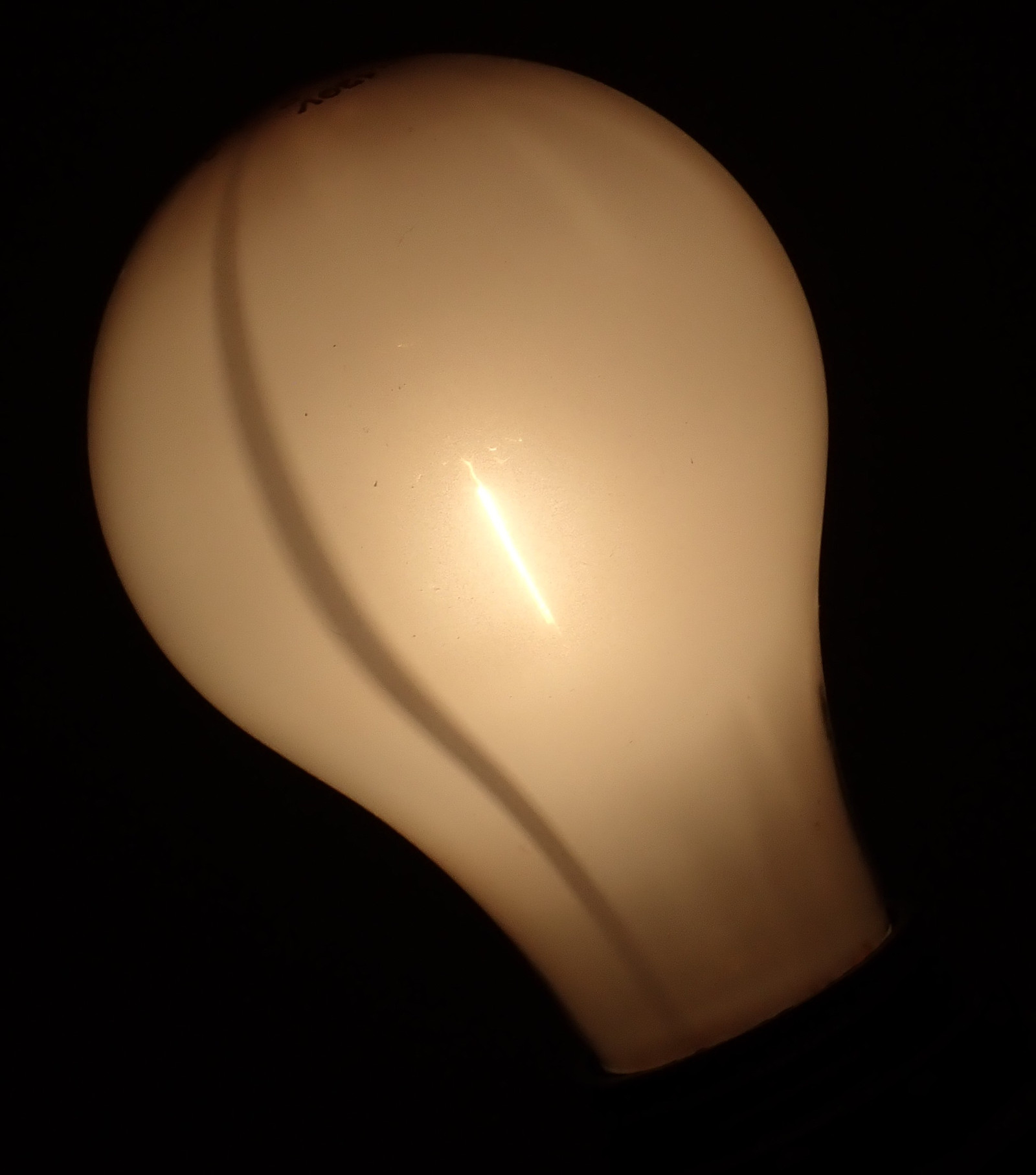
Halogen spectrum.
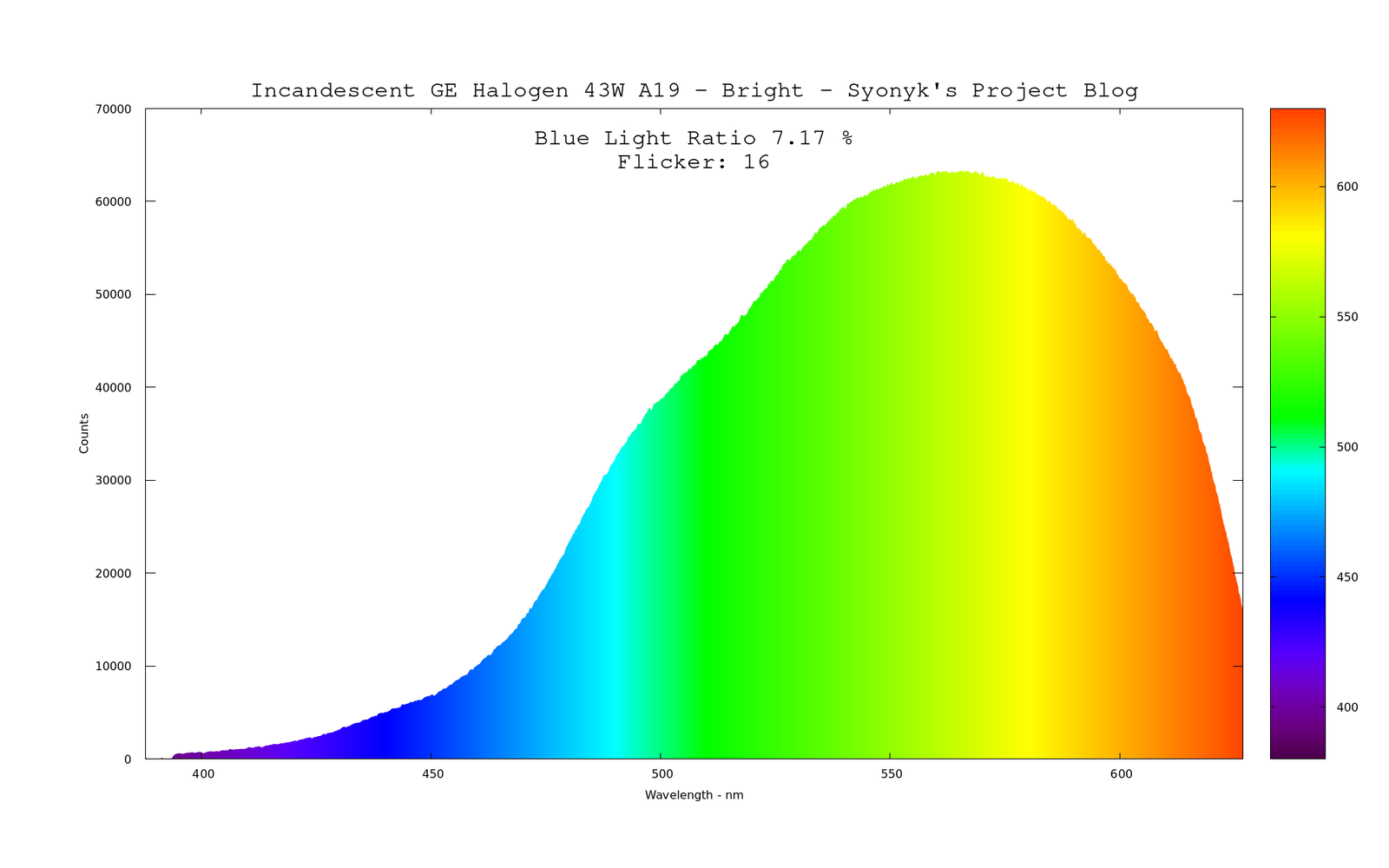
Dims tolerably well, but still has more blue than some of the older style incandescents.
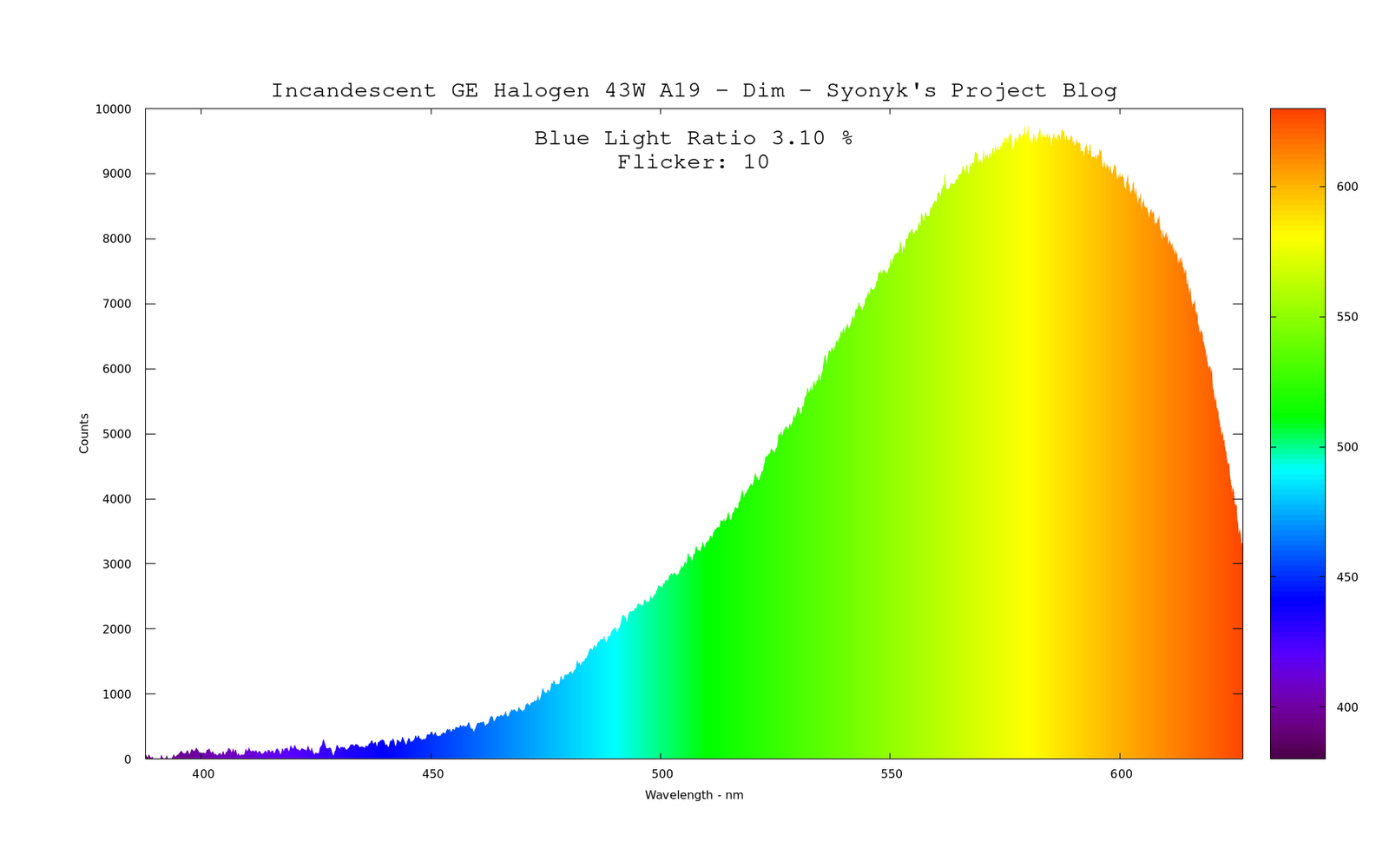
But the conclusion is clear, as far as I’m concerned - for a hidden incandescent bulb you want to dim, the Ecosmart is the best of this wave of plain halogen incandescents.
The “Reveal” (Neodymium Coated) Bulbs
There’s also a category of bulbs you’ll run across that are generically the neodymium oxide coated variety (typically Nd2O3 as far as I can tell). GE sells these as “Reveal,” though you can also buy them by the generic name from other vendors. The claim is that they eliminate a lot of the yellow light inherent in incandescent output, and provide a whiter, purer light that makes your closets sparkle and polishes your teeth, or something like that. They also have a funky spectrum.
I’ll start with a vintage GE 60W Reveal we’ve had in a lamp for many years. It’s nothing fancy, just the sort of regular bulb you’d find 20 years ago in any desk lamp (and it’s still in a desk lamp).
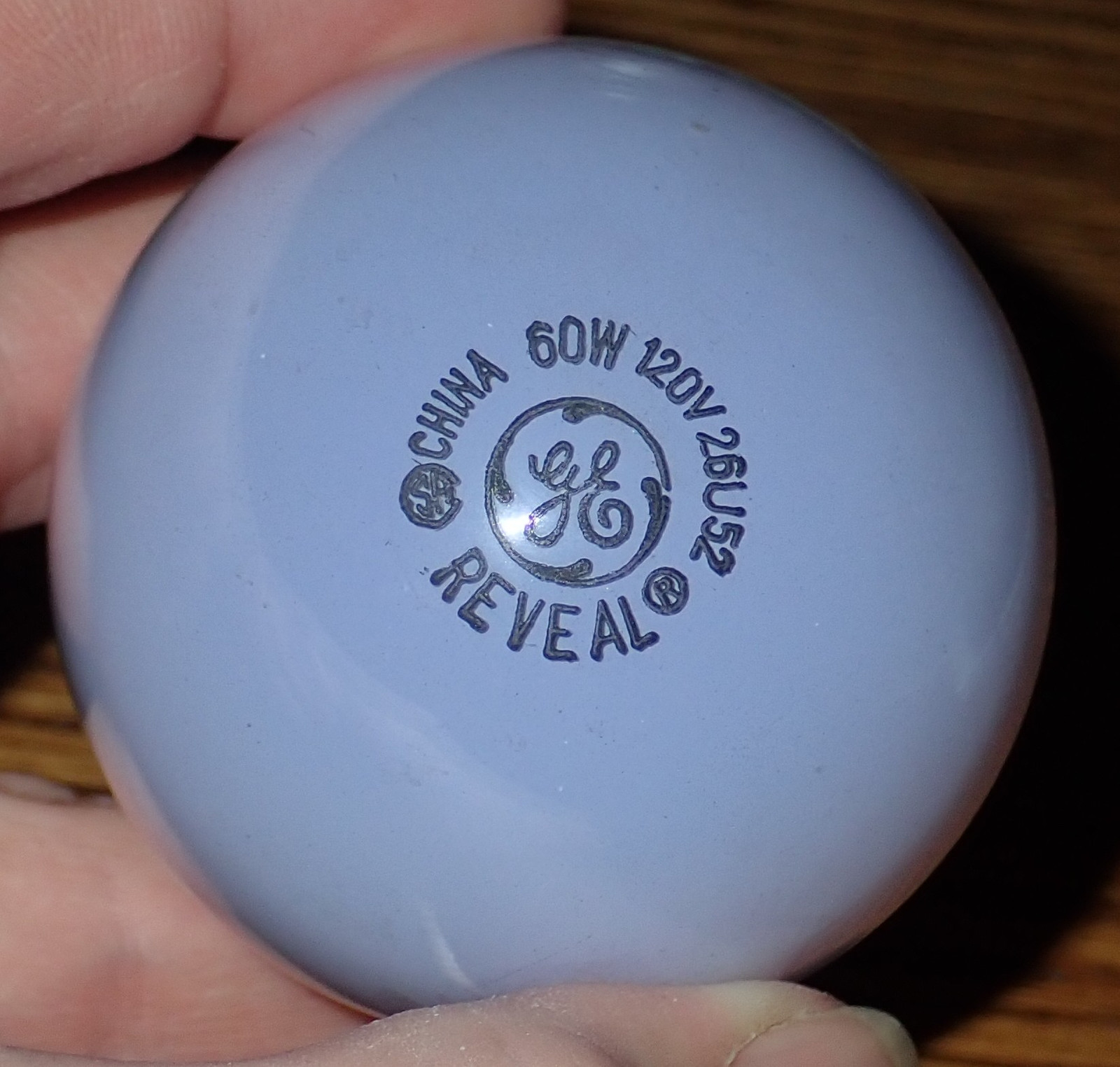
Bright, it looks like this! The claim about “less yellow”? It’s true. The yellows are massively swallowed by the coating, though the greens are also significantly impacted. This is just a regular filament in there - so the bizarre shapes are a result of the coating on the glass. I didn’t realize exactly what the “Reveal” thing meant when I first got my spectrometer, and I spent a while trying to figure out what on earth was wrong with it based on seeing this sort of curve before I tried another bulb and realized what was going on.
… does anyone else kind of see the spectrum giving the viewer the bird in this plot?
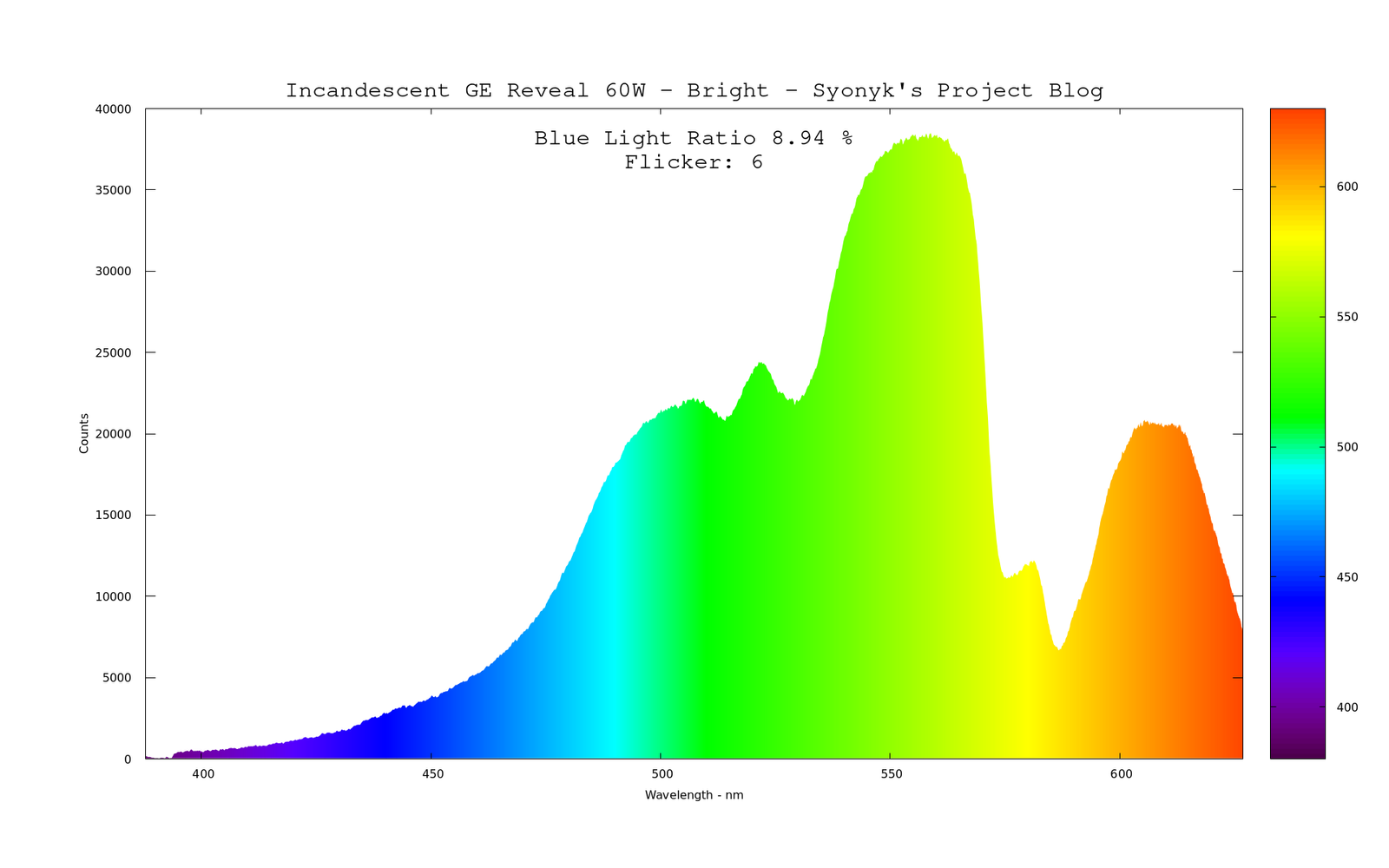
Dimmed, they’re OK, but they’re really not ideal as evening lights. You want the spectrum over in the greens, yellows, and reds, and swallowing the yellows means that you end up with more blue for a given light level than you would with a plain incandescent.
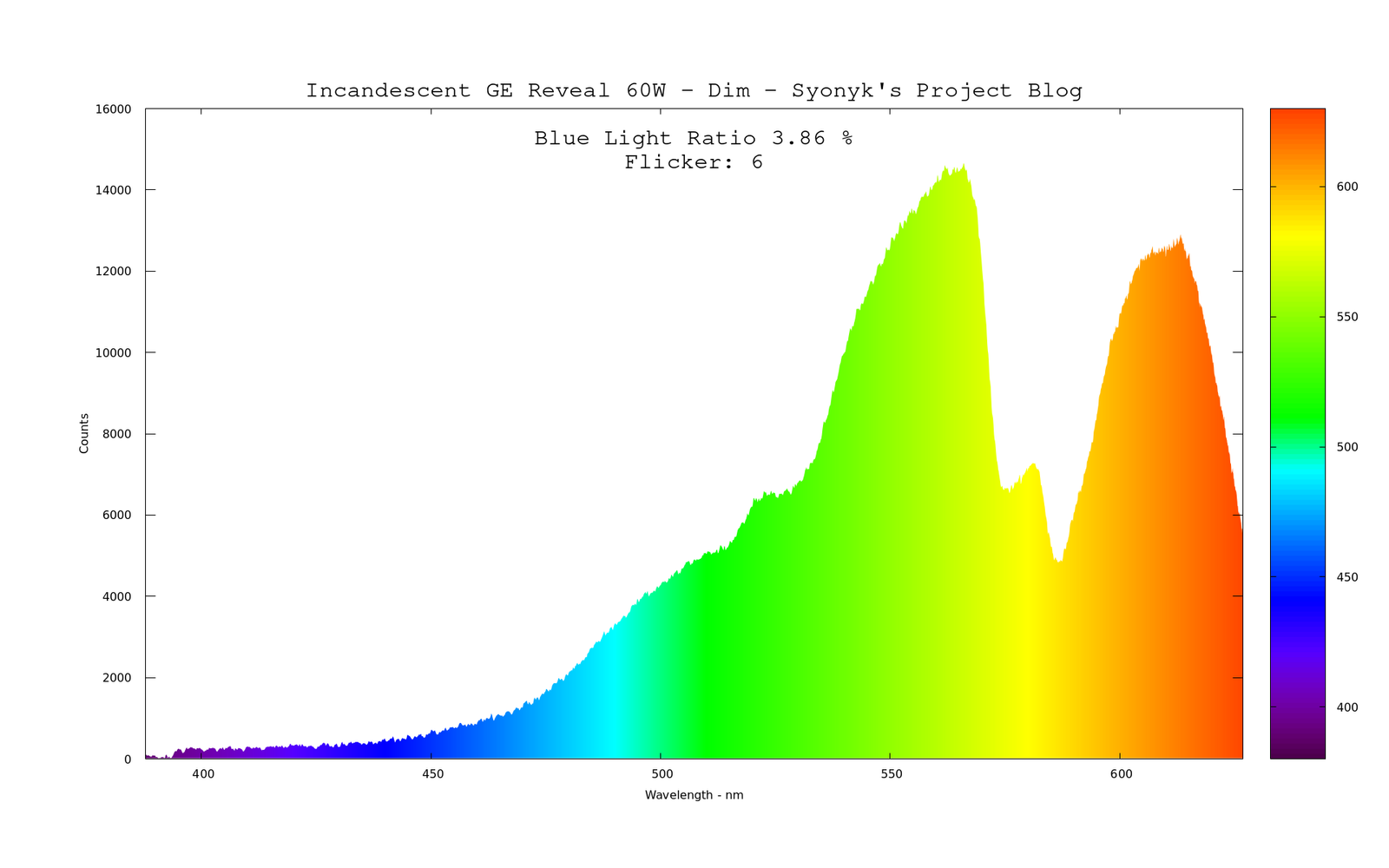
You can also buy generic neodymium bulbs that don’t try so hard to hide the weird blueish tinge of their coating. They’re often sold as lizard lights and such. GE seems to try to hide the tint in their Reveal bulbs, though.
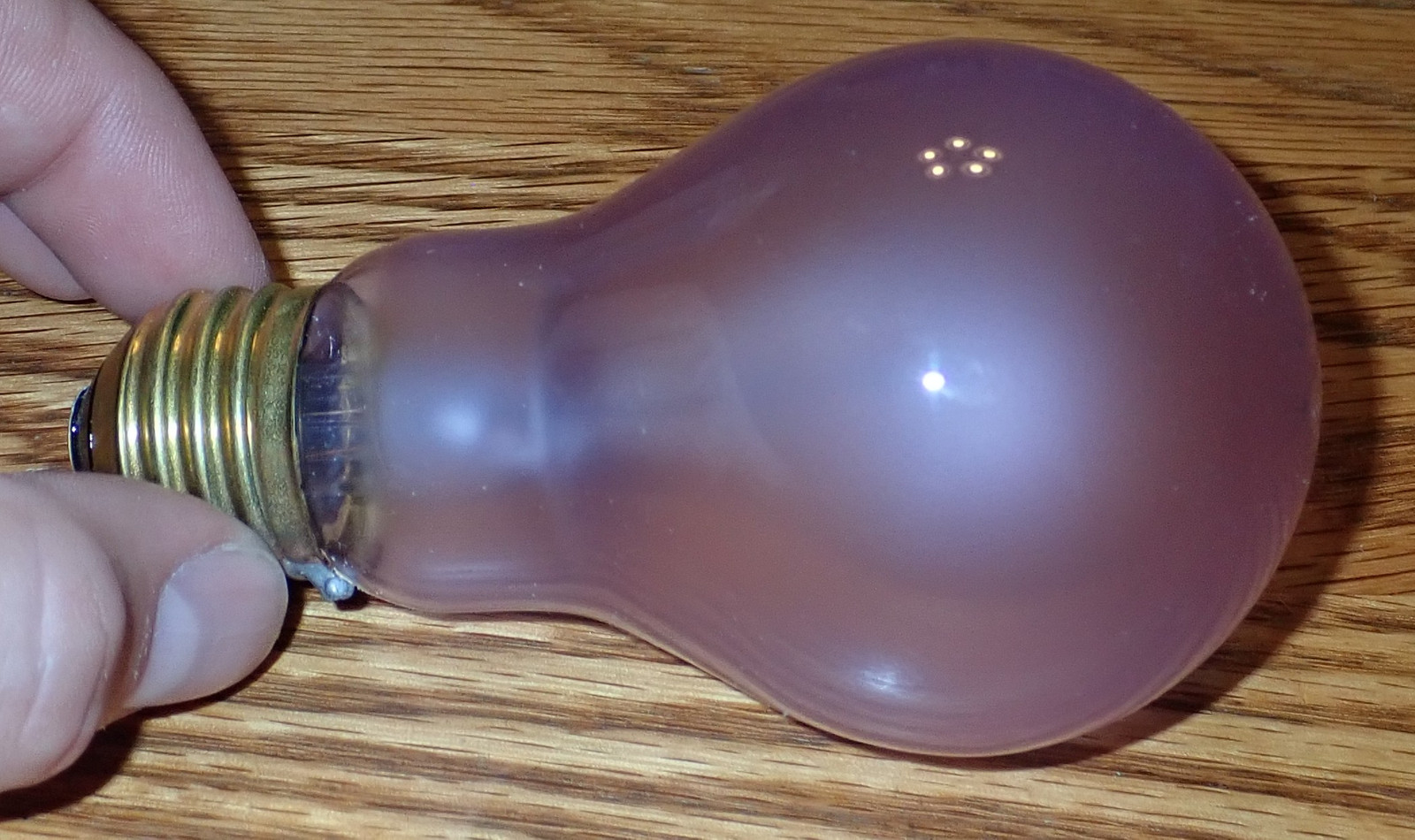
This bulb, in particular, is sold as a 12,000 hour bulb, and in a weird archaic turn, includes the company phone number on the bulb. I suppose I should call it and see if they’re still around…
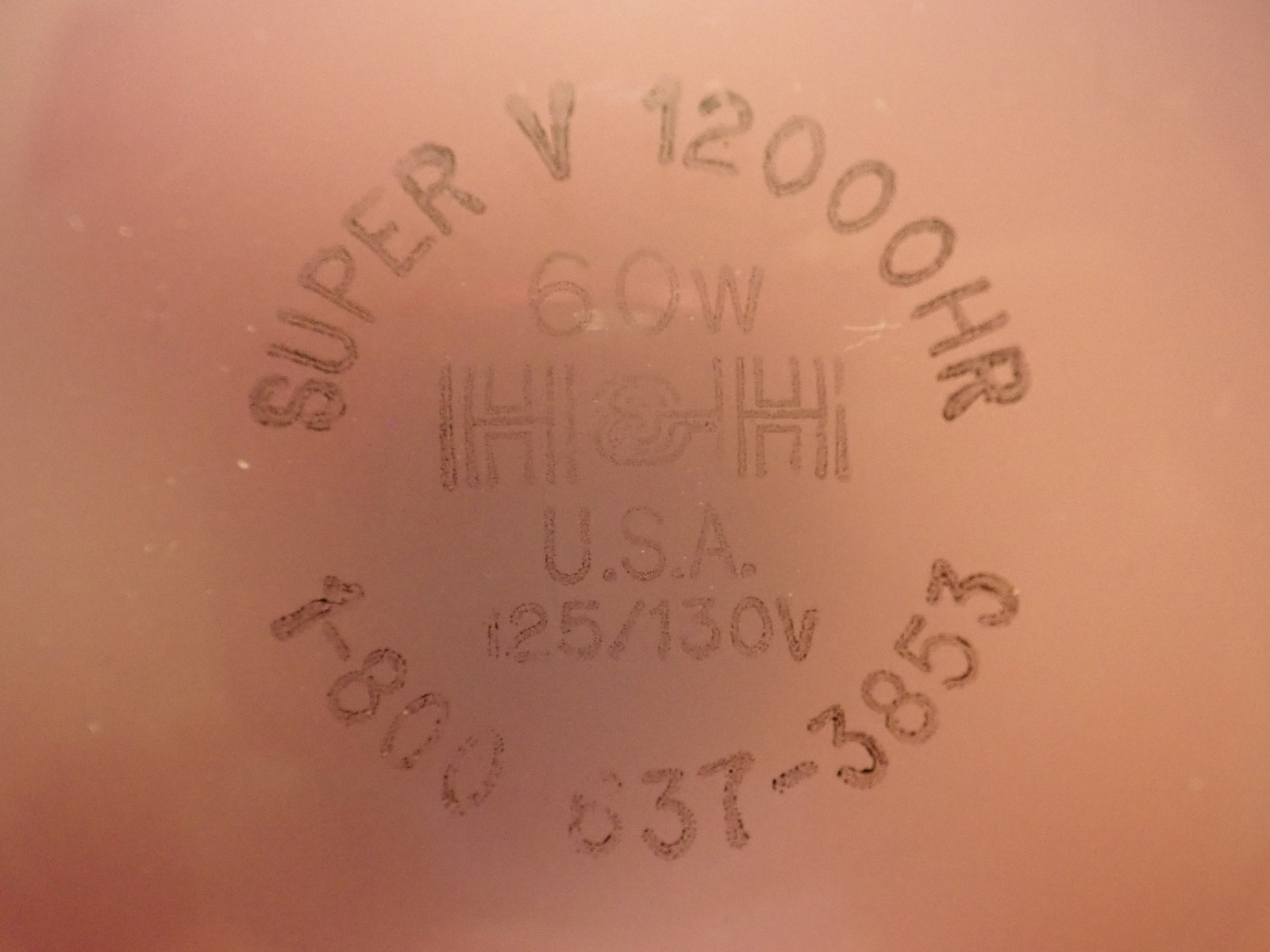
But fundamentally, neodymium oxide absorbs the light spectrum like neodymium oxide. You can’t hide the chemistry. Same spectrum, different bulb.
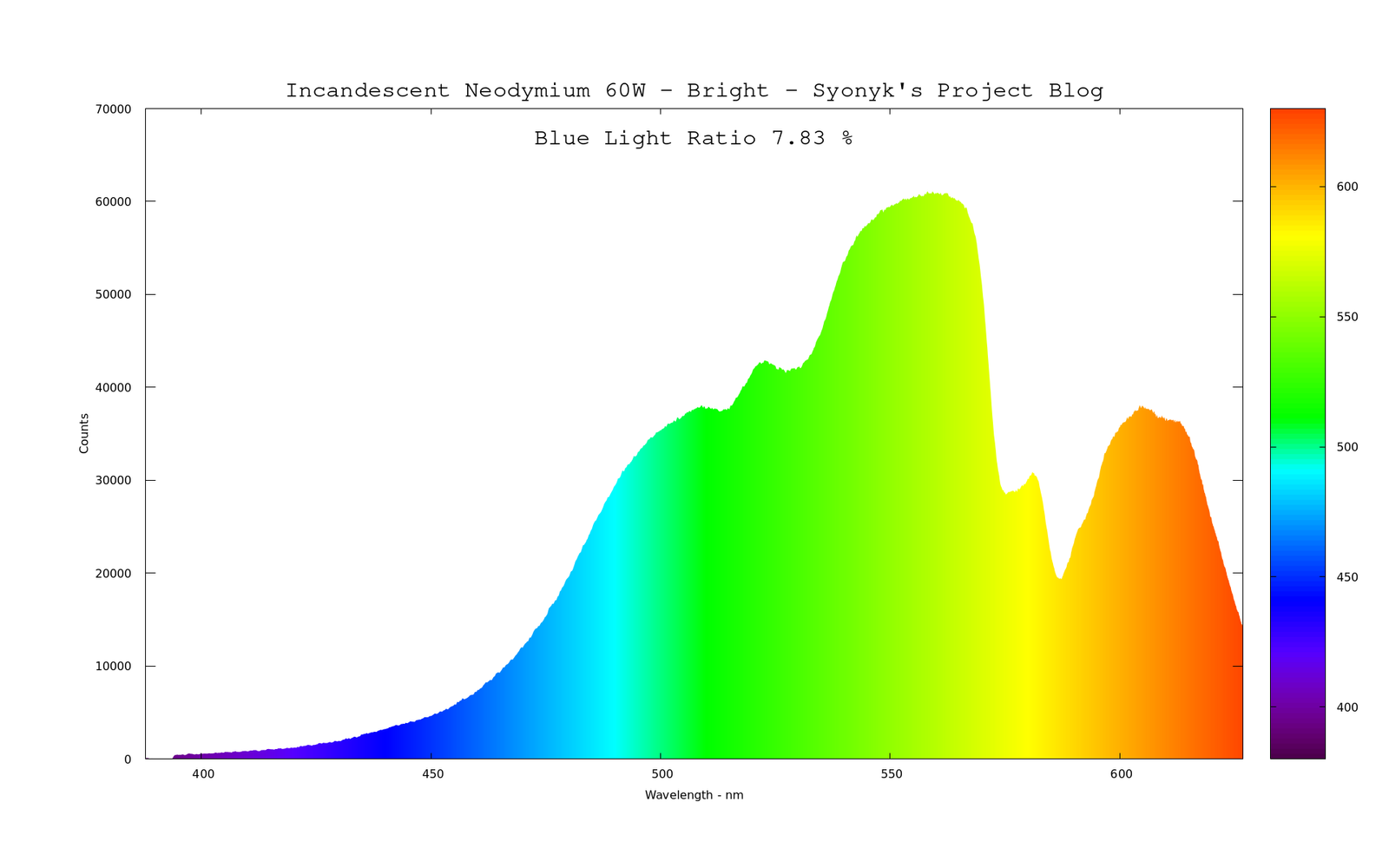
And they’re still not a great evening bulb, even dimmed.
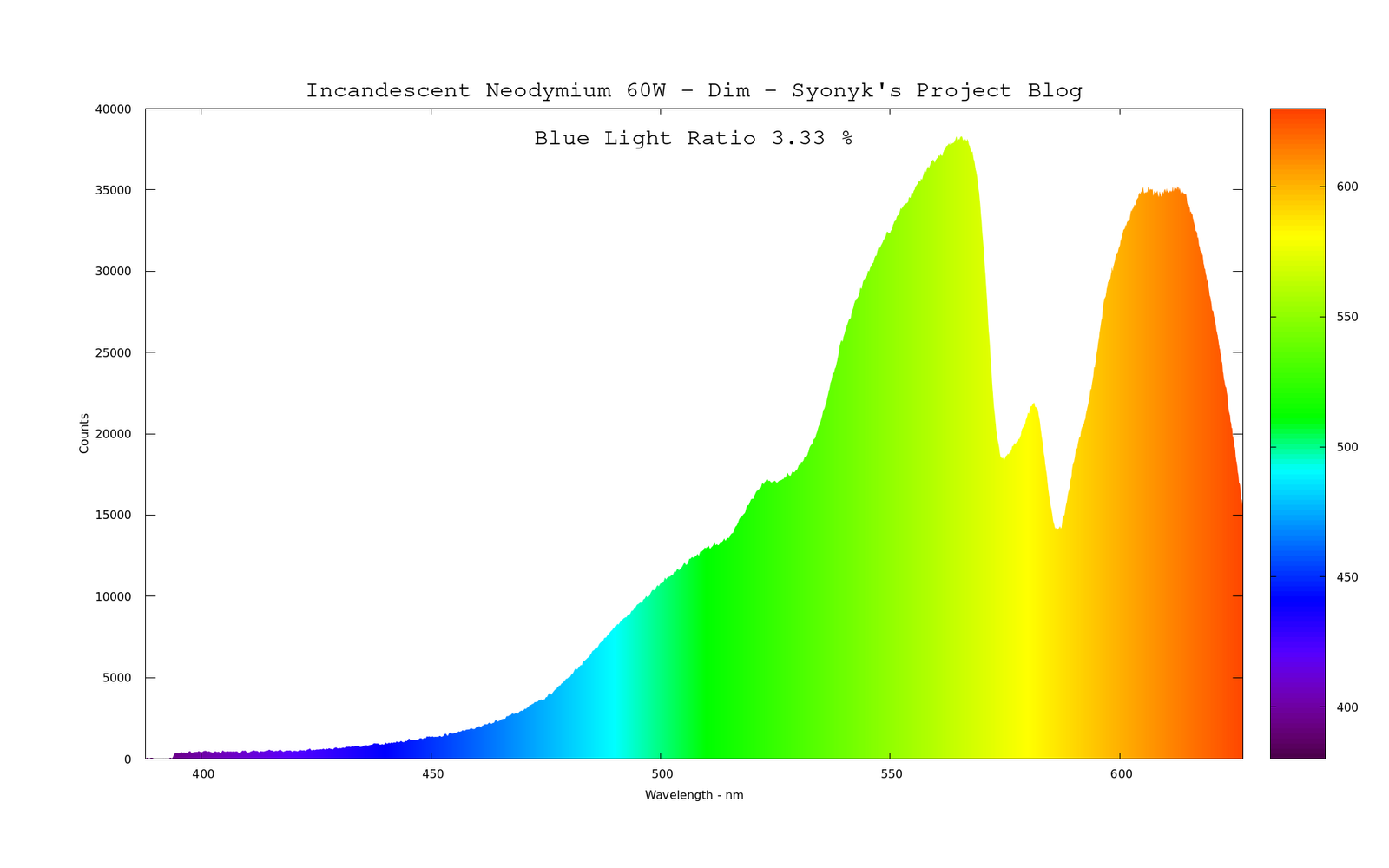
How about the GE Reveal “HD+ Light” bulbs? I’ll start out with the 150W plain filament version, because it’s big, powerful, bright, and you can probably still buy it. Can we all agree that marketing here needs to be strung up? Light is not “HD.” It’s light. And when you’re actively messing with the spectrum, I have a hard time with claims that it’s some amazing light. But, such is what the box claims.
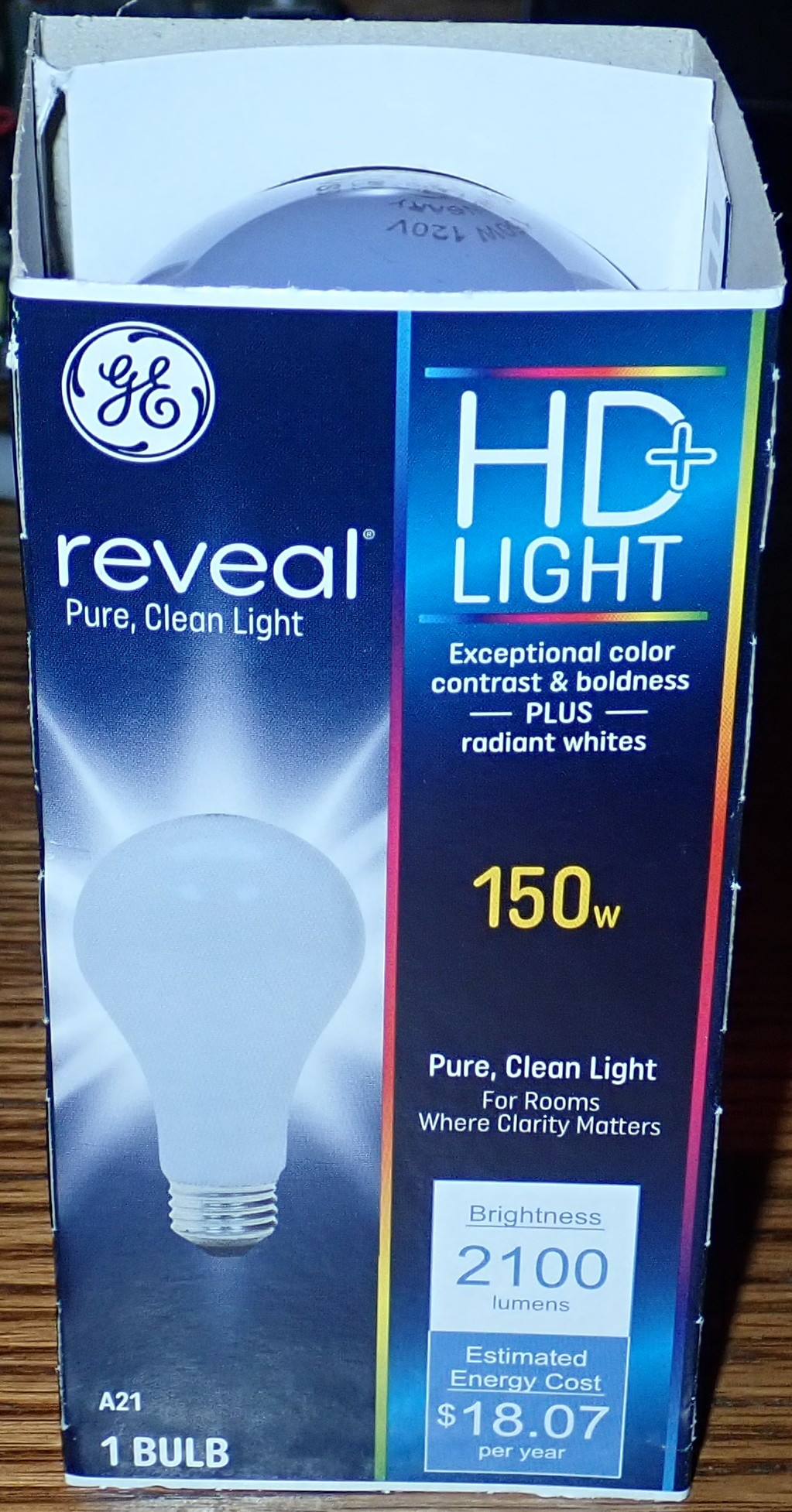
It’s a lot of light, a lot of power, and a rather alarmingly short lifespan at 0.7 years estimated (or about 750 hours). You can safely assume this bulb is being run hard. And, for the sort of white, blue, not-much-yellow light you’d expect, that’s exactly where you need to run a filament.
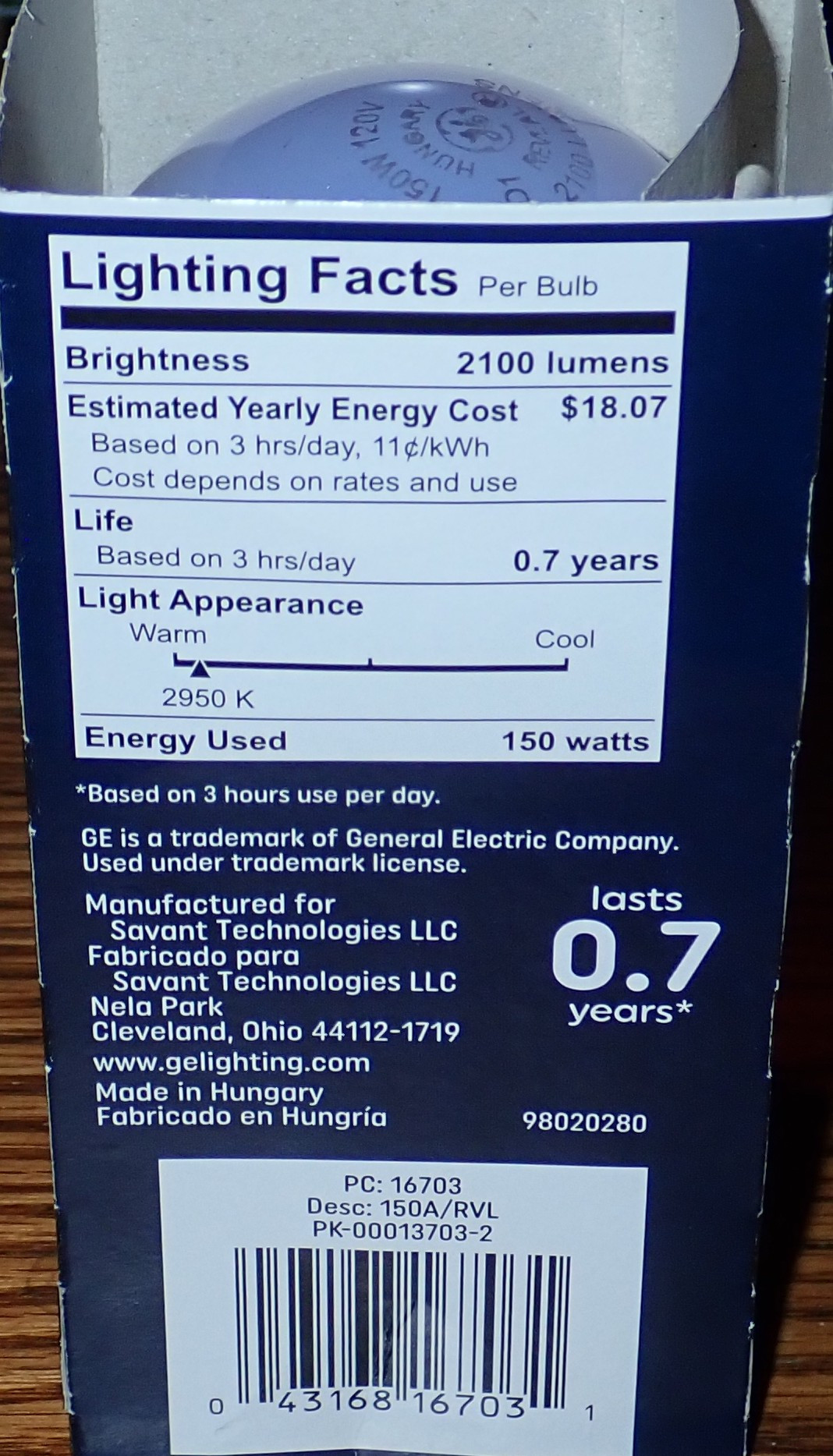
There are some shadows down the base when lit at 154W, but it’s overall a pretty good looking bulb. Just… I don’t know why you’d bother at this point. If you want bright and are OK with “funky spectrum,” just go with one of the LED options.
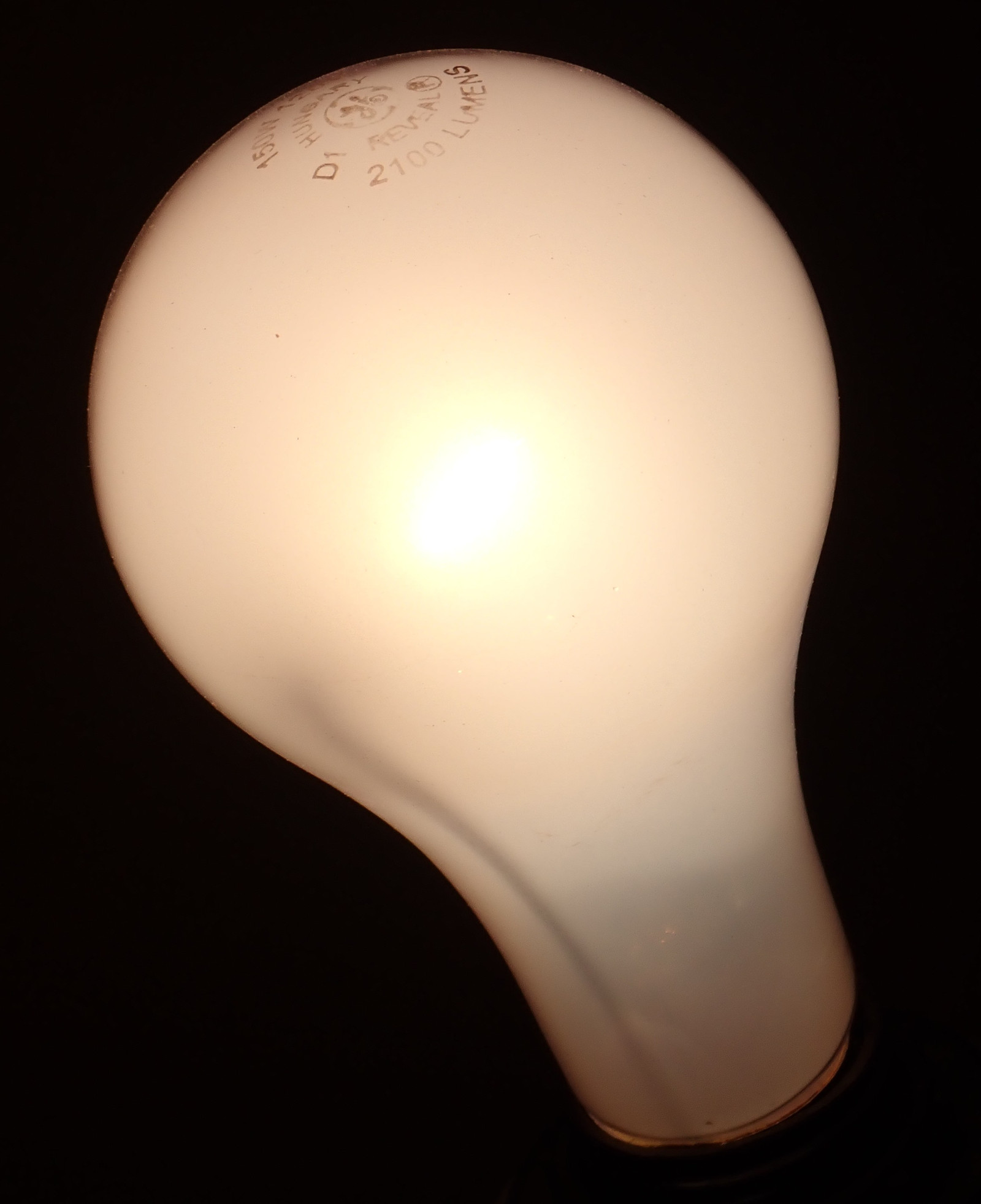
If you look closely at the filament, you’ll see that it’s far thicker than the 60W bulb filament - this is about the same scale. You can also see, in the middle, evidence of a support. The support wires help stabilize the filament, but they also cool a section where they touch - so you get somewhat less light for a given power. More filament supports means a more rugged, longer lived bulb (that also won’t sing), but in the land of “tradeoffs you can’t avoid,” also slightly less light output at a given power.
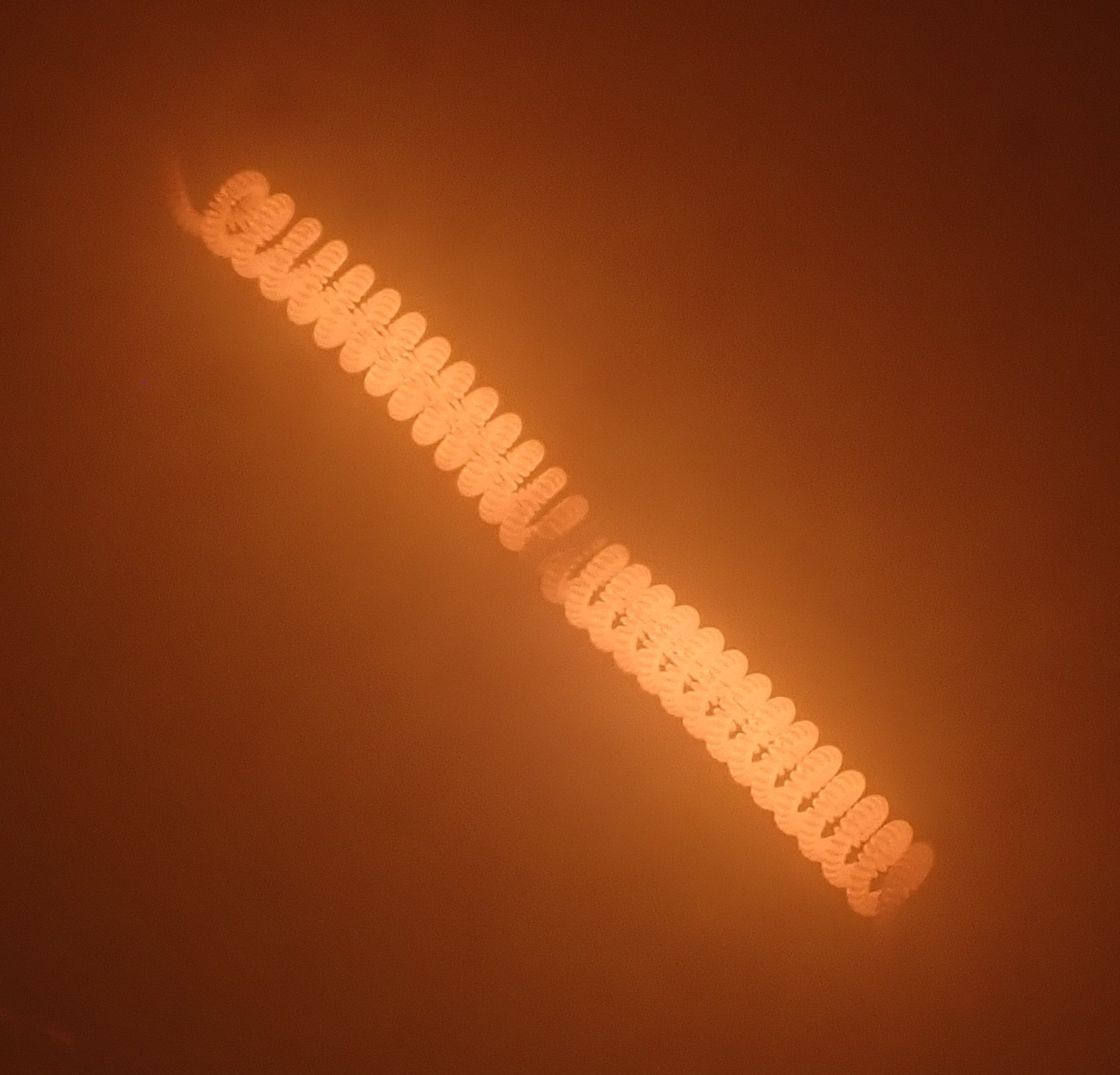
At full brightness, as you’d expect, this is a very blue bulb. It’s running the filament hot and blue, and absorbing a lot of the yellows. Interestingly, you can see the rather reduced flicker on this bulb - the higher physical mass of the filament solves a lot here, and you get a good bit less flicker from the AC waveform.
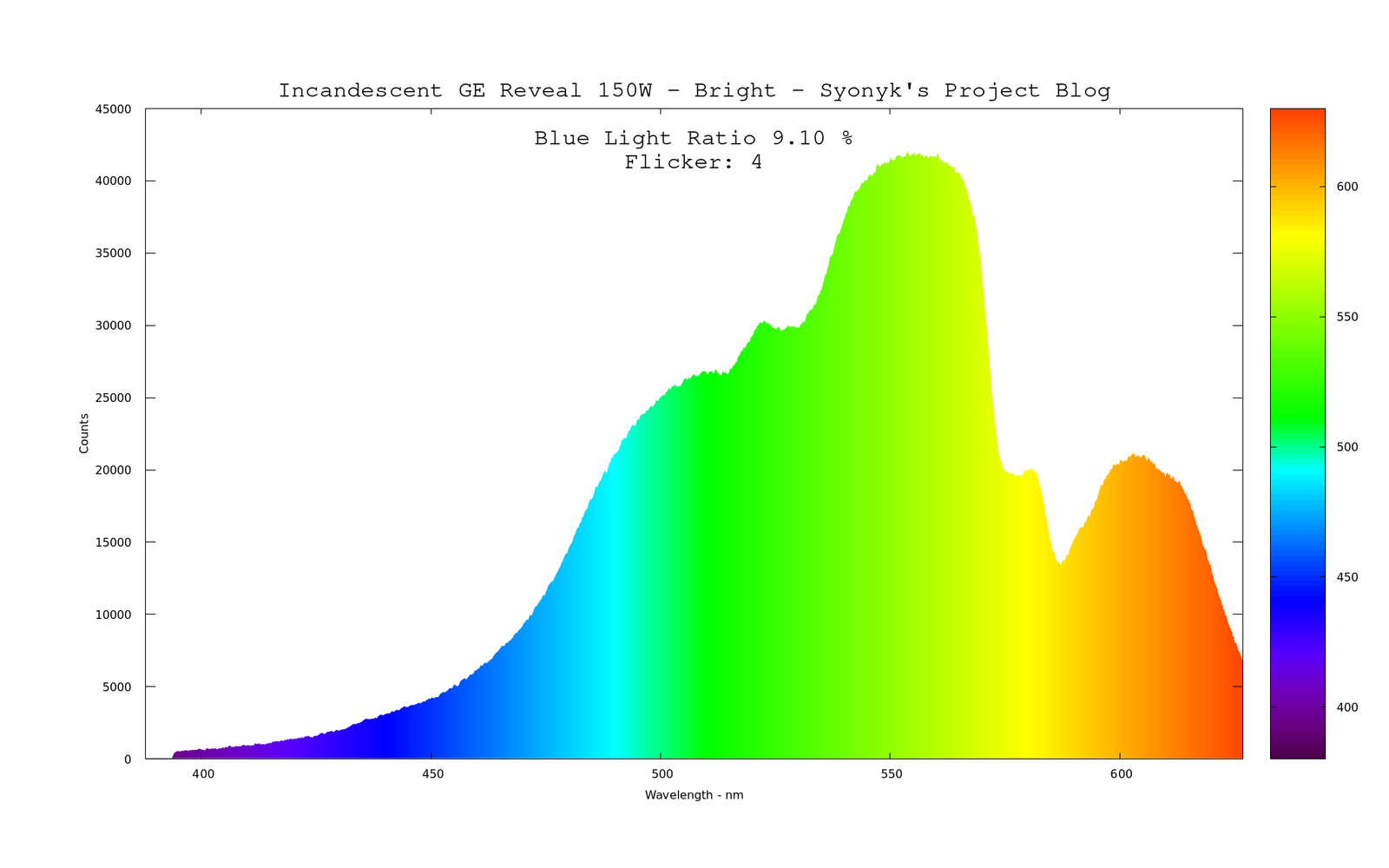
But even as blue as the bulb is, when you dim it, all the blue just goes away. This is the main theme of this post - as you dim incandescents, they get a lot more “human evening friendly light.” Even the ones that aren’t great to start with! I just can’t come up with a good reason to start with this type of bulb in 2023.
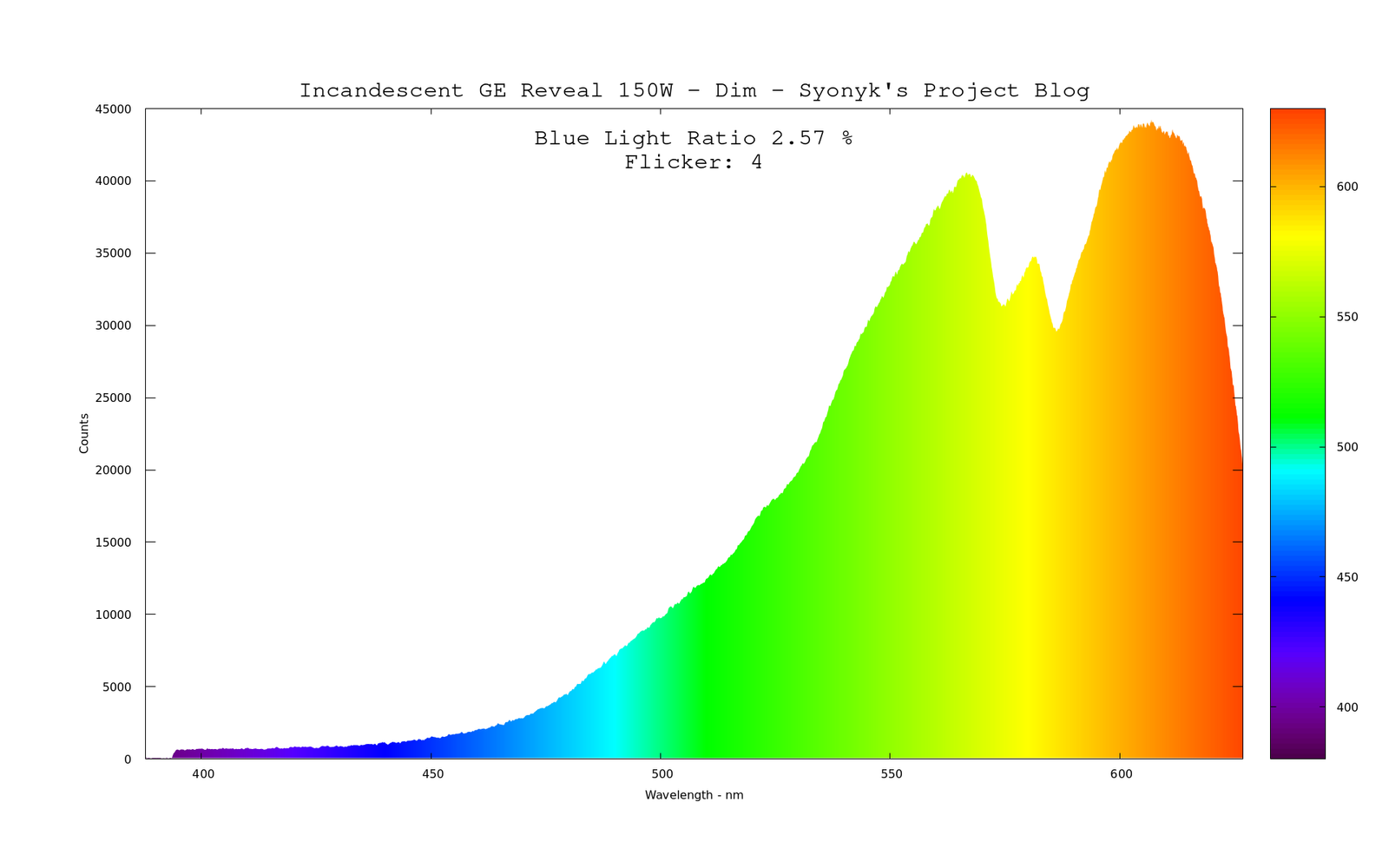
Finally, how about the new, halogen-based Reveal bulbs? First and foremost, they’re not putting out much light. Only 565 lumens on 60W? If you want this sort of pure white, blue-ish leaning light, just put a LED in.
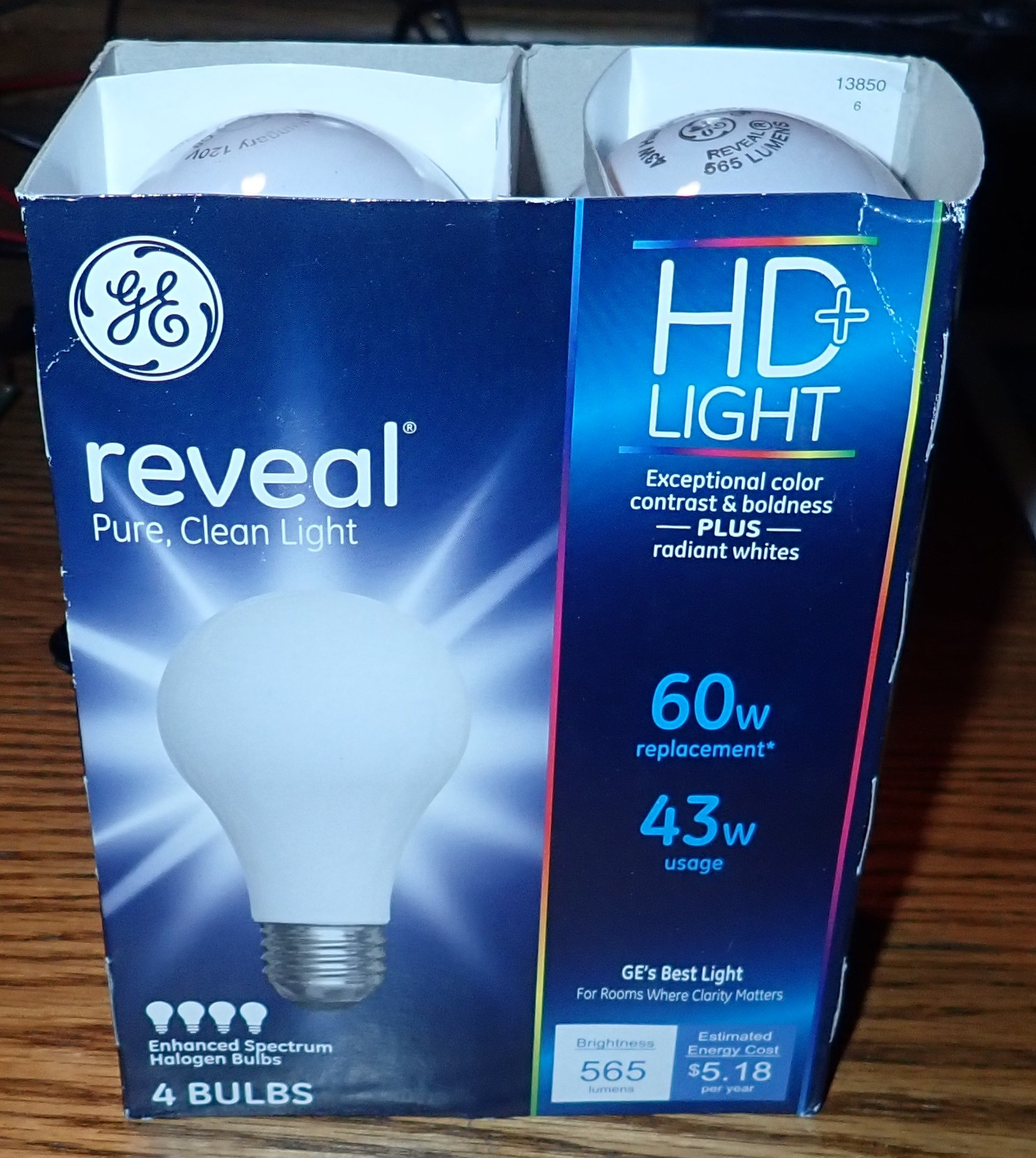
They’re full of marketing, for sure.
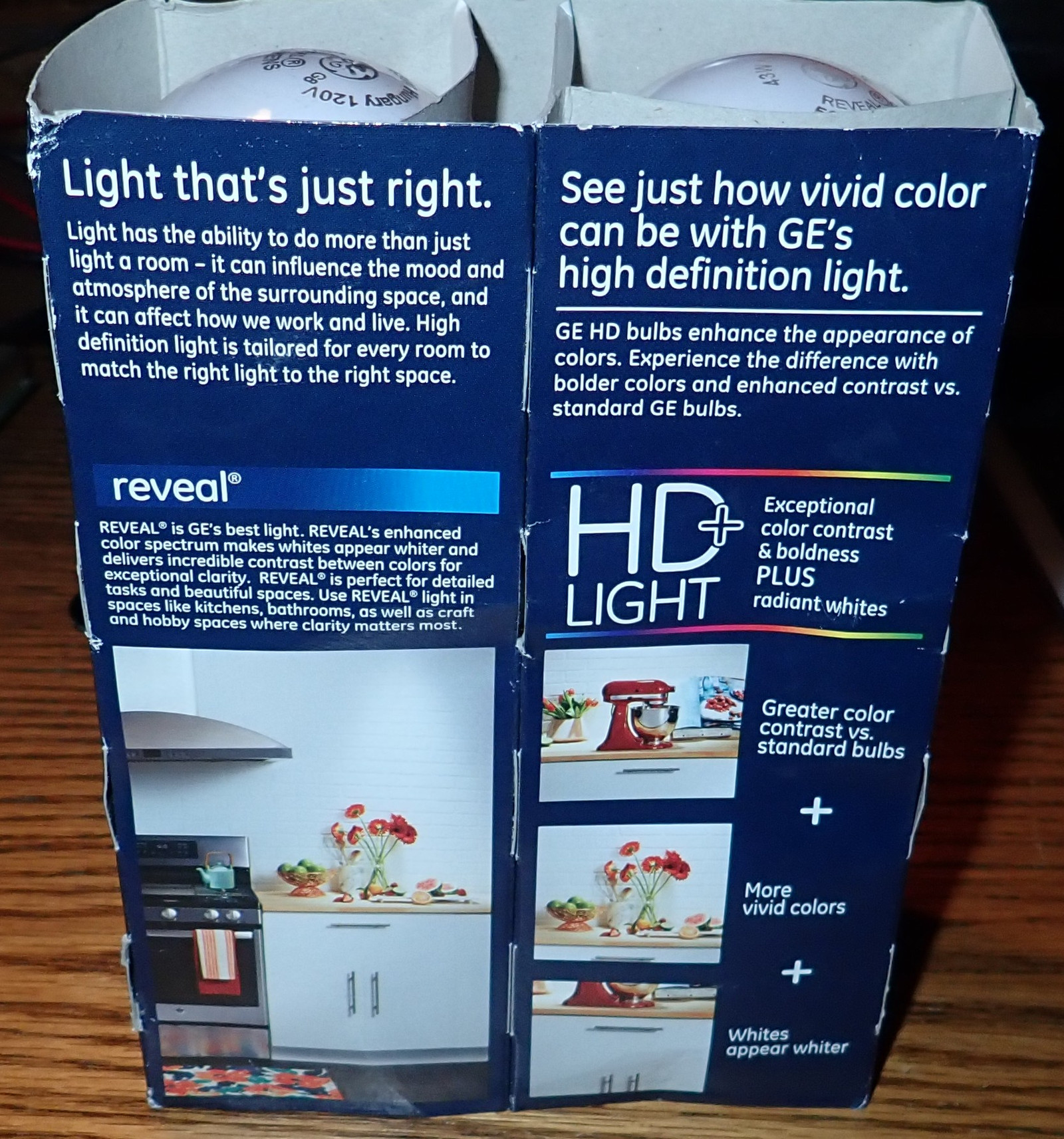
Turned up, it’s 43.8W, and it’s not a bad looking bulb, all things considered - one major shadow, and a visible filament at the base, but fairly even lighting. Just a bit “speckled.”
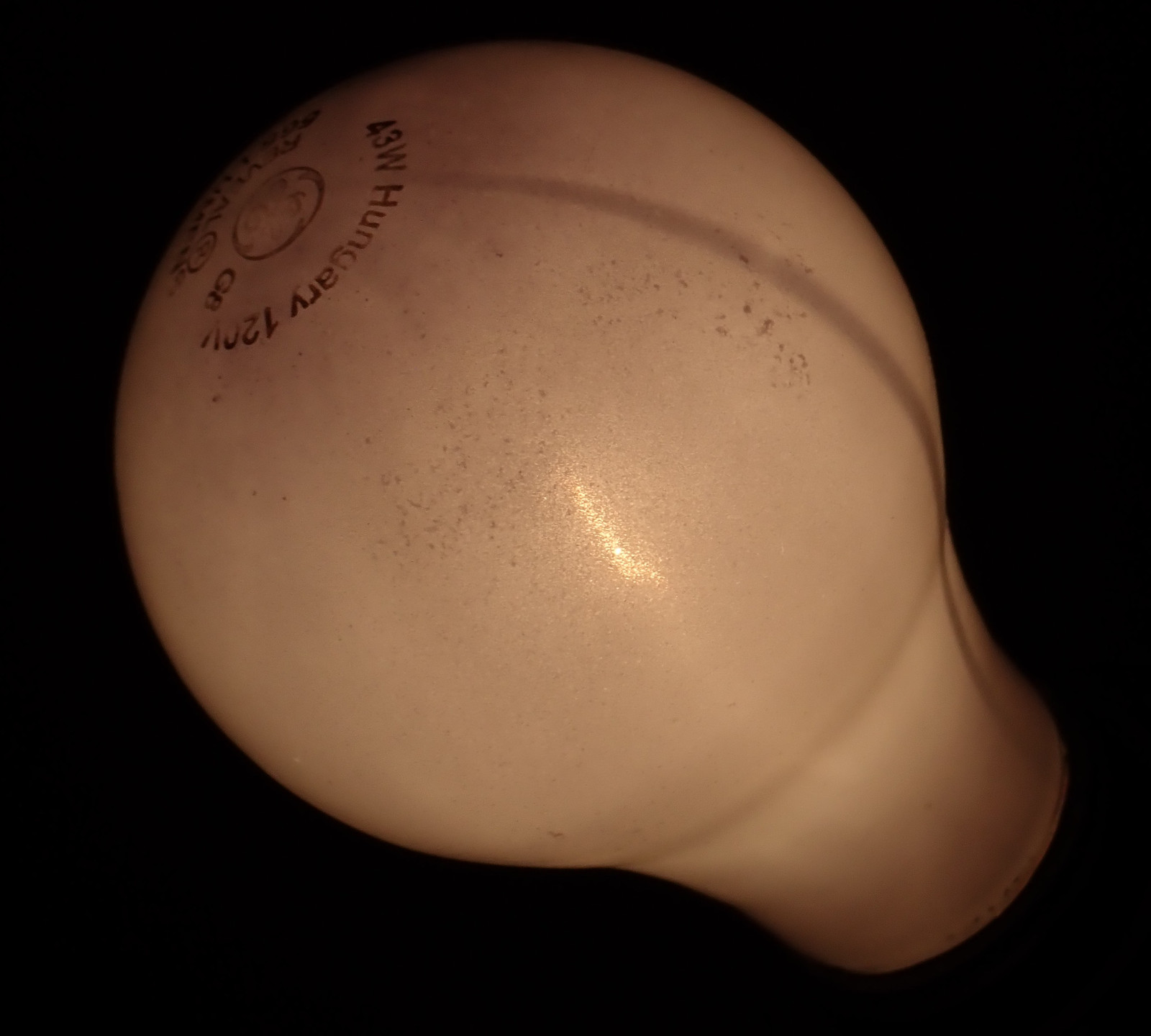
And, once again, you see the neodymium spectrum. Blackbody, with the yellow and various other colors swallowed. The small, hot filaments do have an awful lot of flicker, though - there’s just no thermal mass to help them carry through the dips.
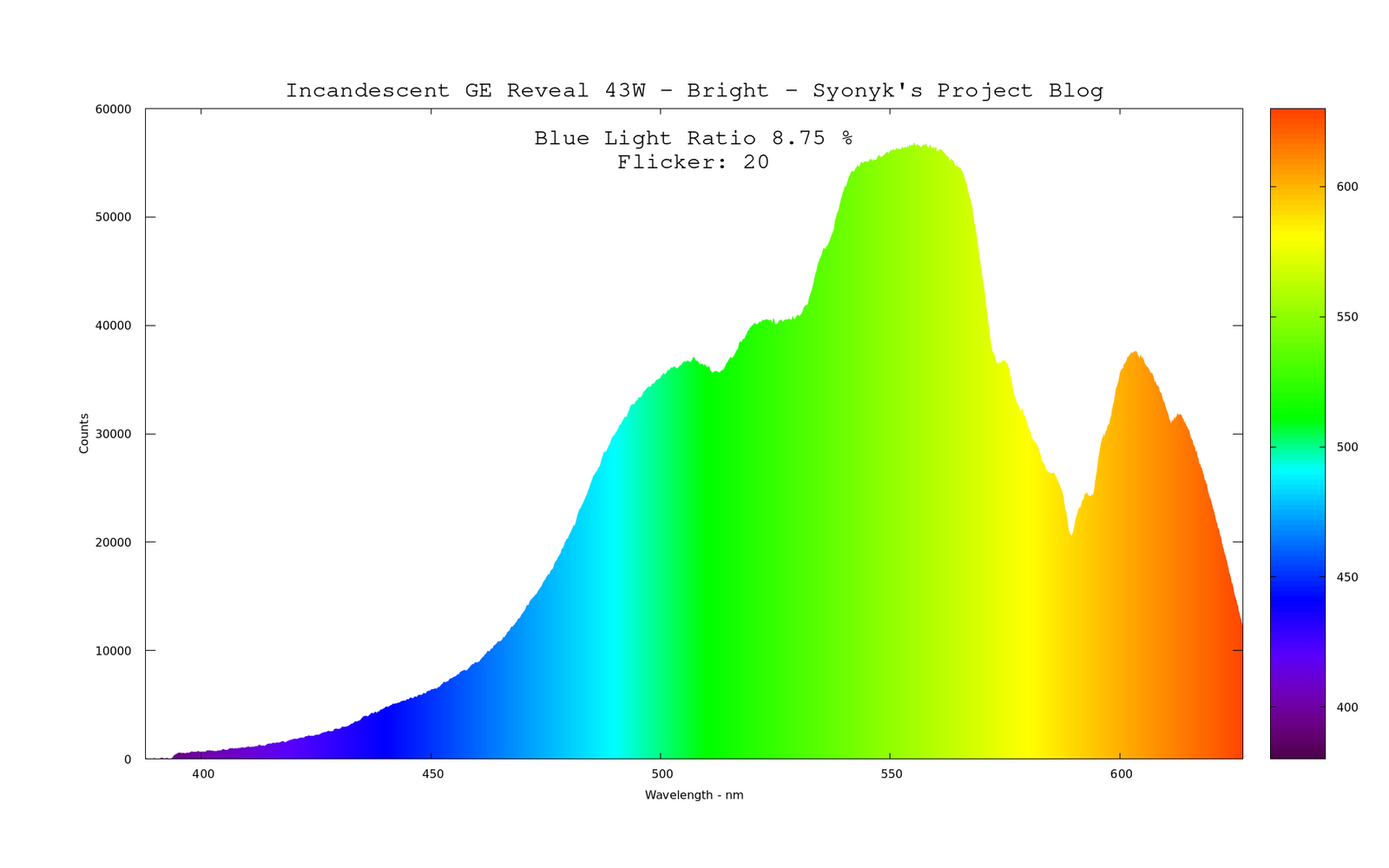
Dimmed, same story. Less blue, by a lot, but the little halogen capsule bulbs aren’t great evening bulbs no matter how you slice and dice them.
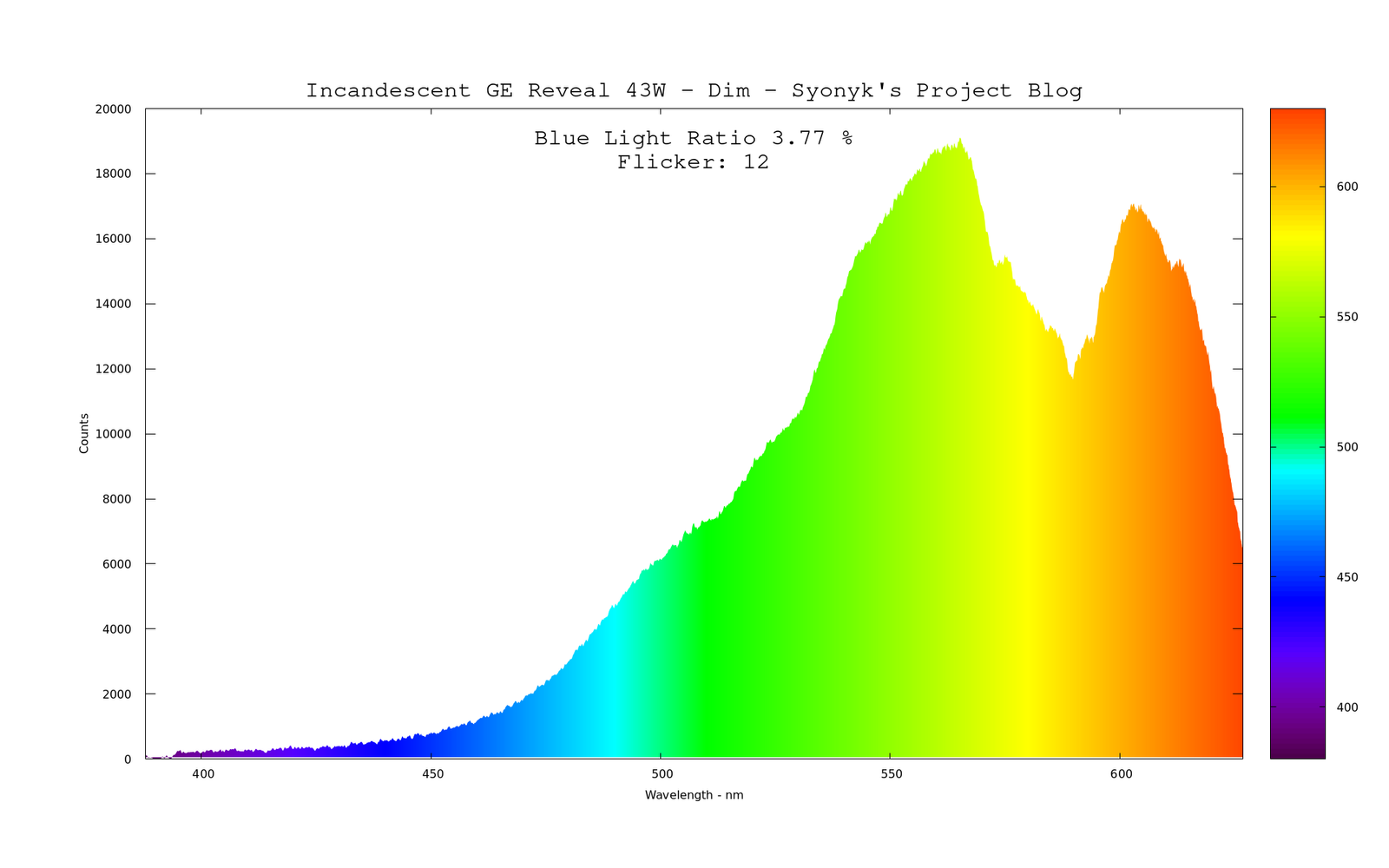
The neodymium bulbs are definitely “whiter light” than a plain old incandescent, and the halogen capsule ones save energy, but I just don’t see a real point to them or a place in a modern incandescent use pattern. They dim fine, but they’re still bluer than a regular bulb when dimmed, and they’re not as white as a modern LED, if you want that sort of light. LED spectrums are a bit funky, but so are these. So, technically interesting, but I just don’t see a point to them anymore. For anything you’d want to do with a bulb, there are better options now.
“Edison Bulbs”
Finally, how about some of the big, long, exposed filament sort of bulbs sold as “Edison bulbs”? These are very warm light bulbs, and I’ve been using one as an evening bulb (or night bulb) for years now - I picked up, rather inadvertently, a 240V rated Edison bulb and have been running it on 120V since my daughter was born 8 and change years ago, with no problems at all.
The first one I’m looking at is a “Vintage Globe” sort of bulb. They don’t put out much light for the power consumed - I was poking fun at the 60W 600 lumen bulbs above, and this is less than half, putting out a rated 245 lumens at 63.6W. This is just, again, a quirk of physics. A cool running filament doesn’t put out much light, but it does last a long time, and doesn’t put out much blue.
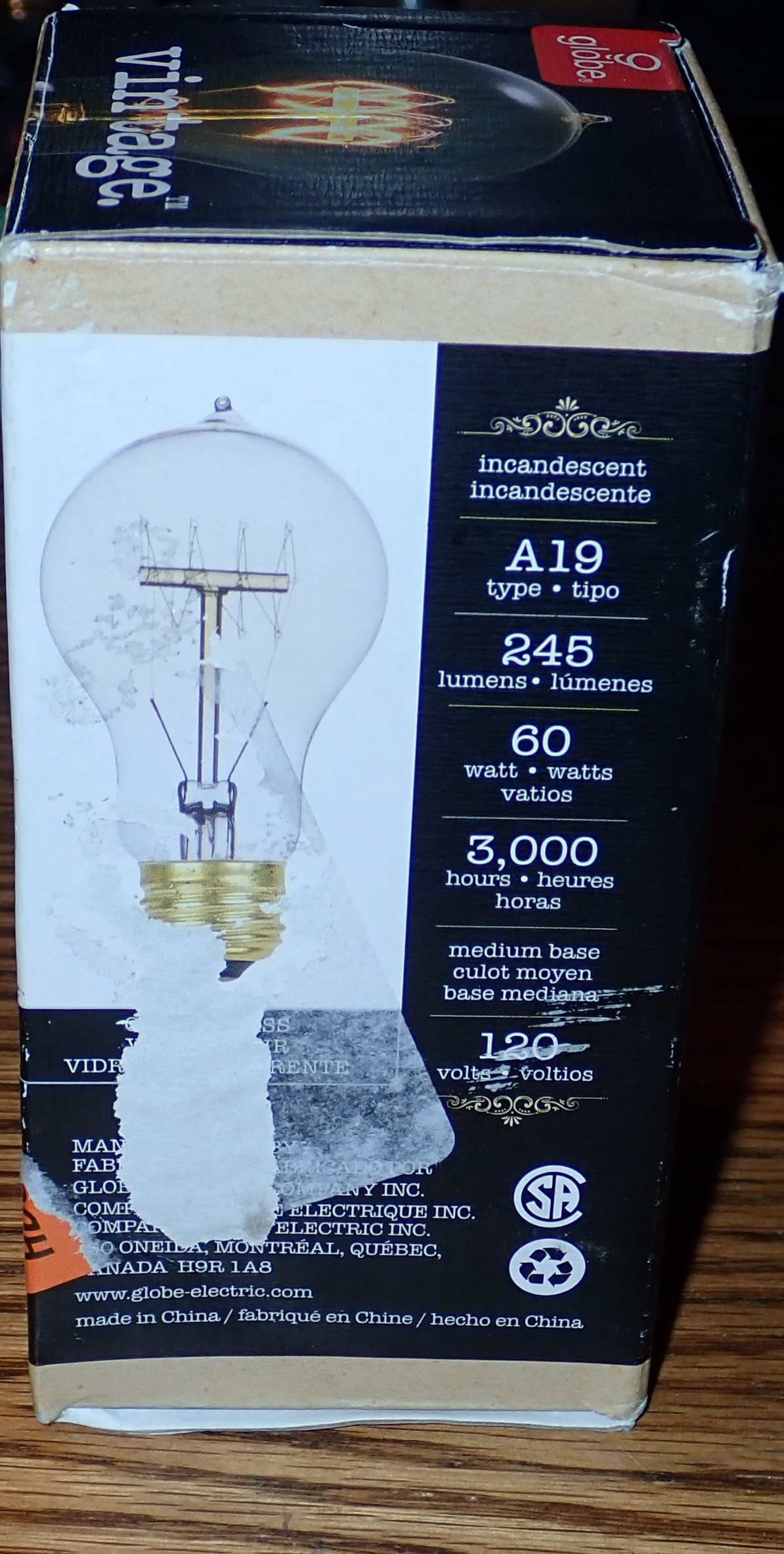
Crank it up, and it’s a rather pretty looking bulb with a lot of filament supports, a glass main support, and a very warm glow!
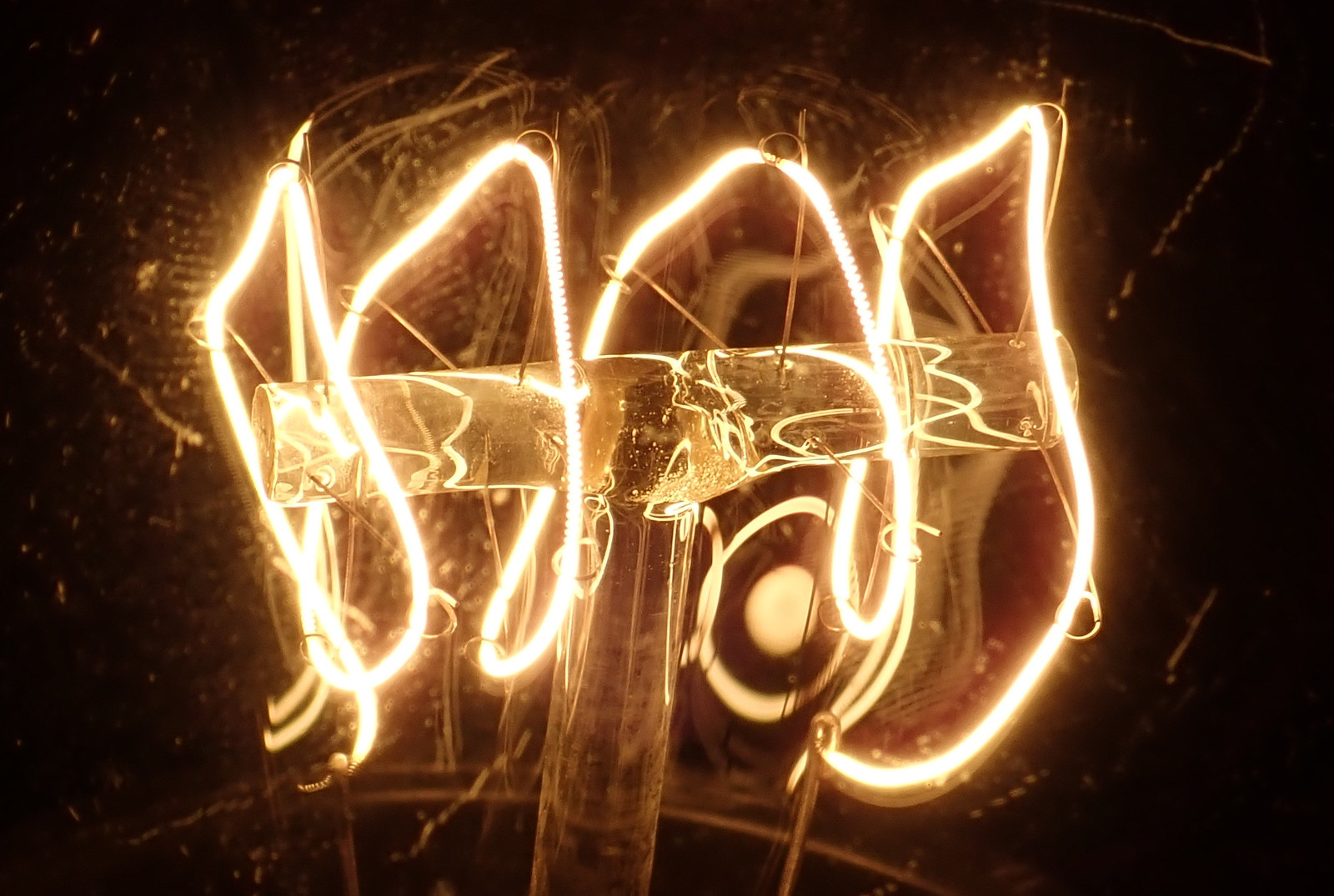
At full brightness, which isn’t particularly bright, it looks for all the world like any other blackbody radiator - a nice smooth spectrum until my meter starts falling off in the reds. There’s not much flicker, either.,
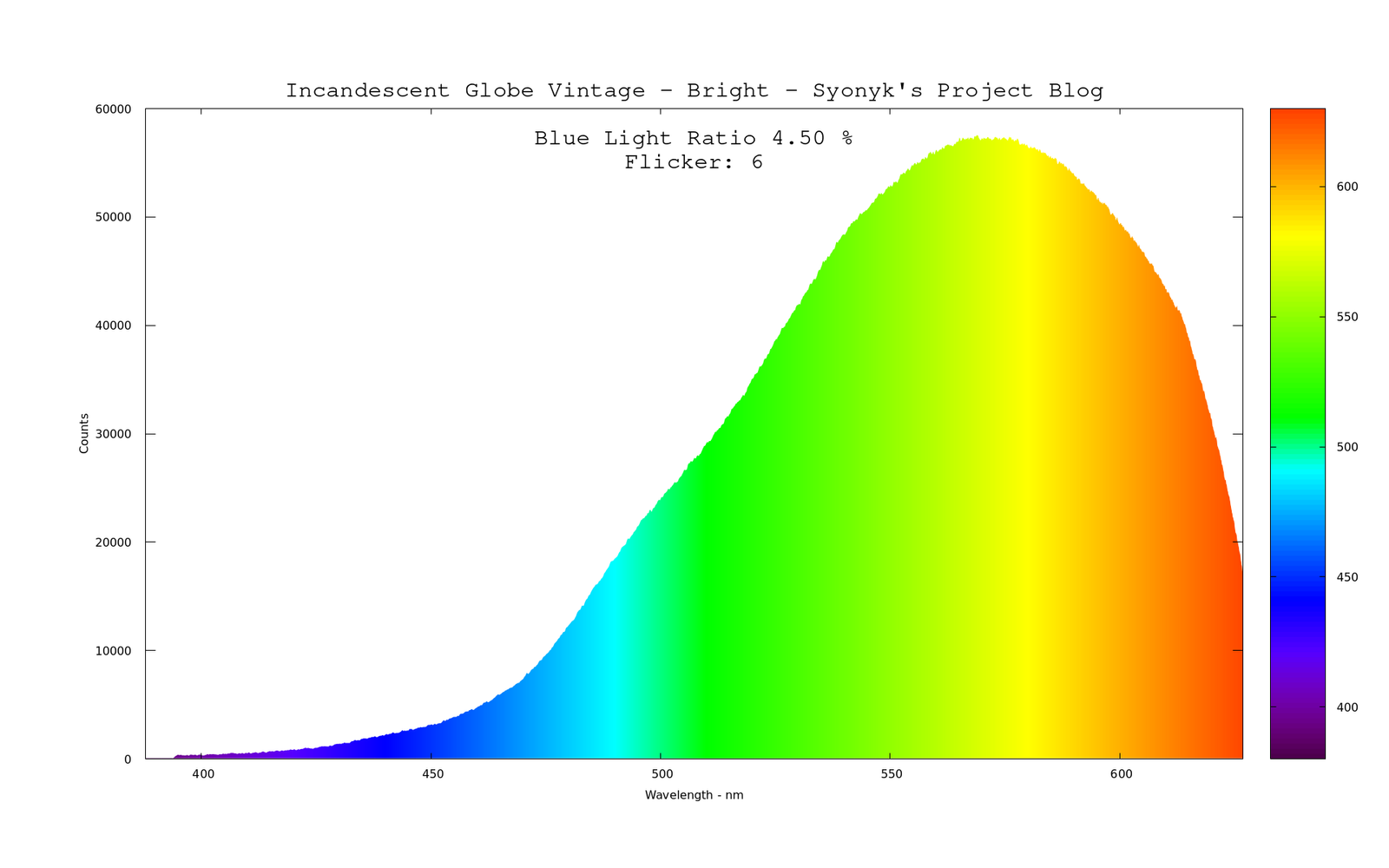
Dim it, and it gets even better - not much blue, and not much flicker. If you want some sort of “dimmed evening bedroom bulb,” these are a great option.
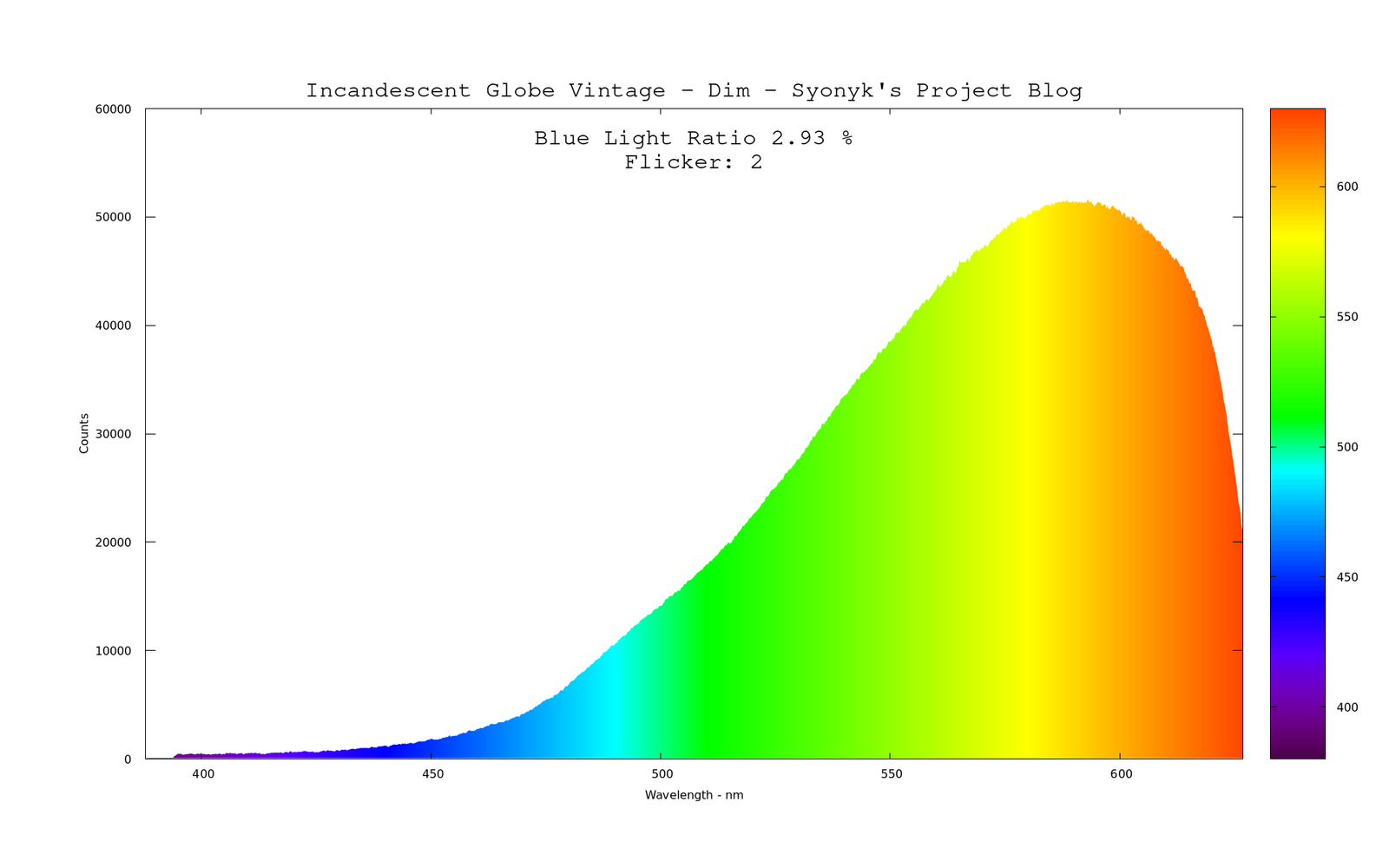
How about the Feit Electric “vintage style bulb”? This one lists a wonderfully low color temperature of 2100K, and, on top of that, amber glass!
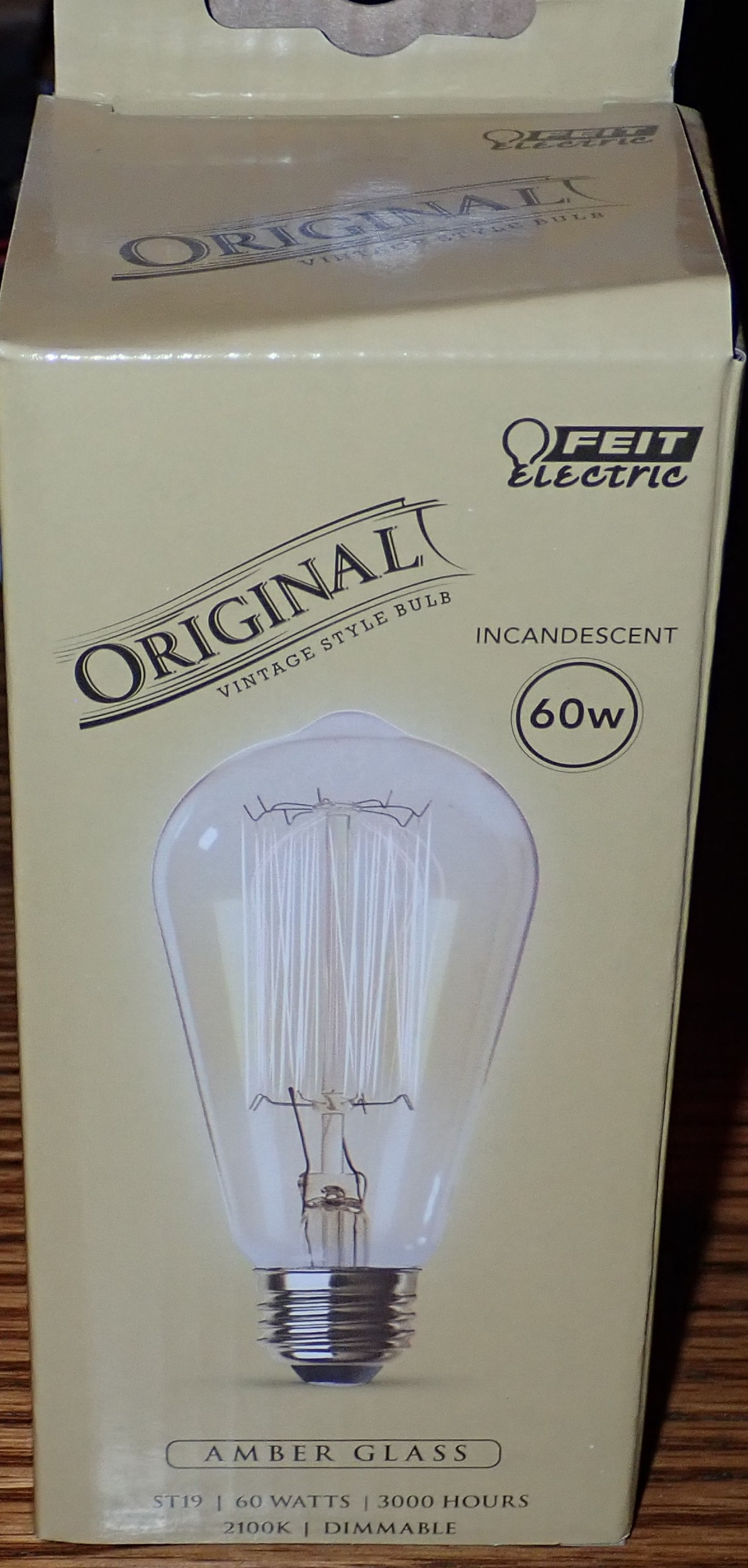
Pull the bulb out, and you’ll notice that, in fact, it’s rather tinted! This should help pull even more blue out of the spectrum.
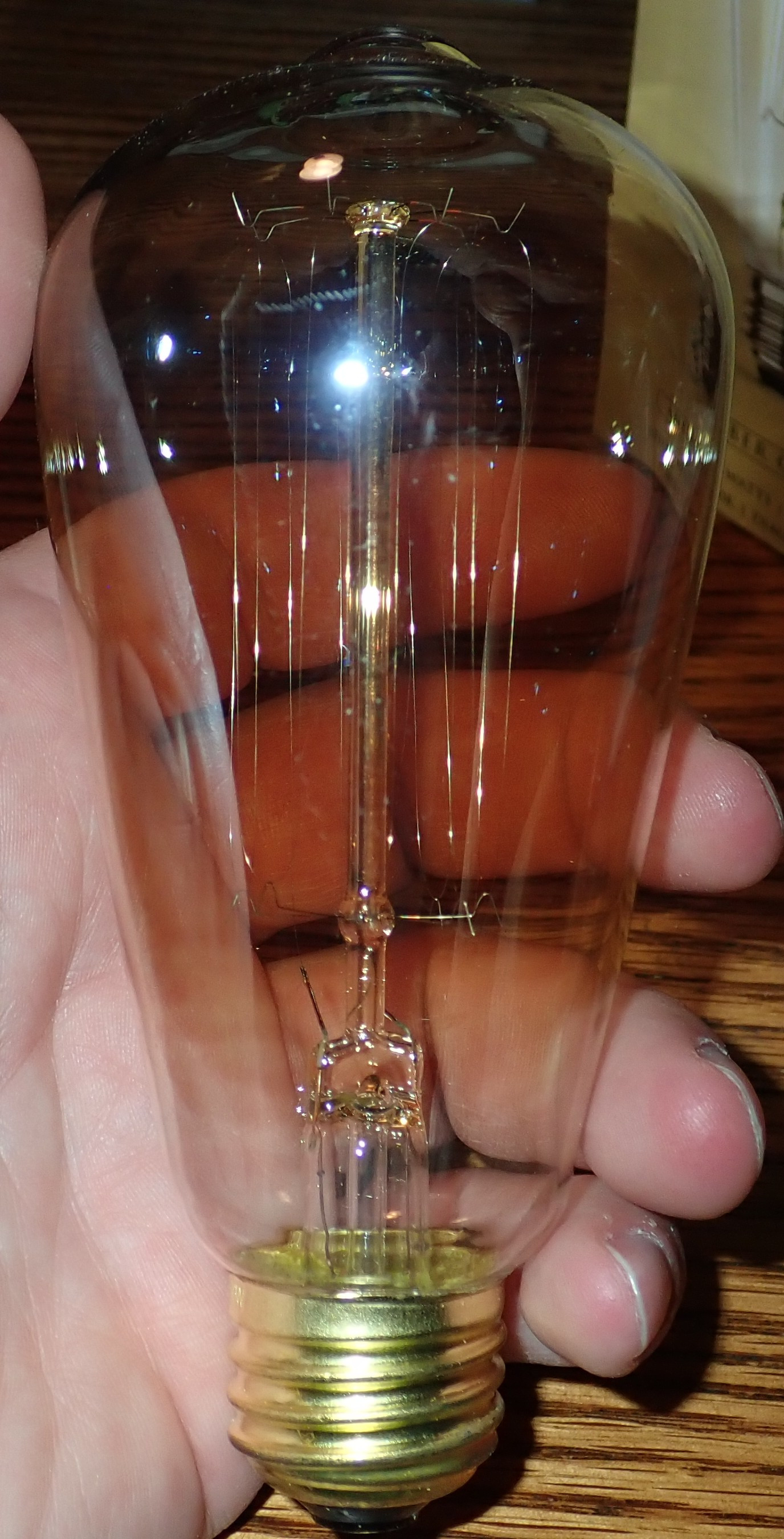
Lit up, it’s hard to photograph from all the assorted reflections, but it’s a very warm sort of color.
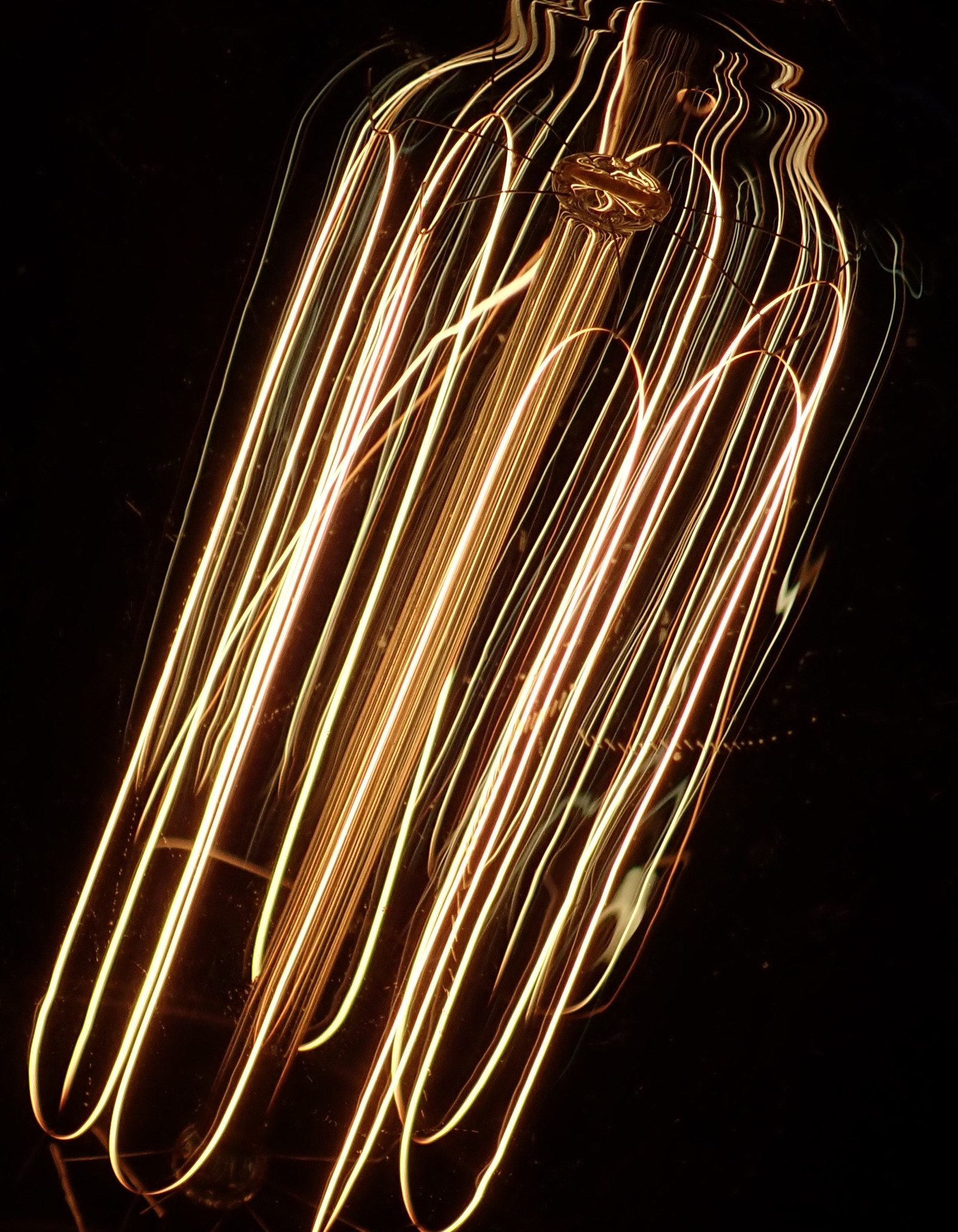
Throw the spectrometer at it, and… yup! Very little blue, even at full brightness. Just not a lot of light for 58.8W.
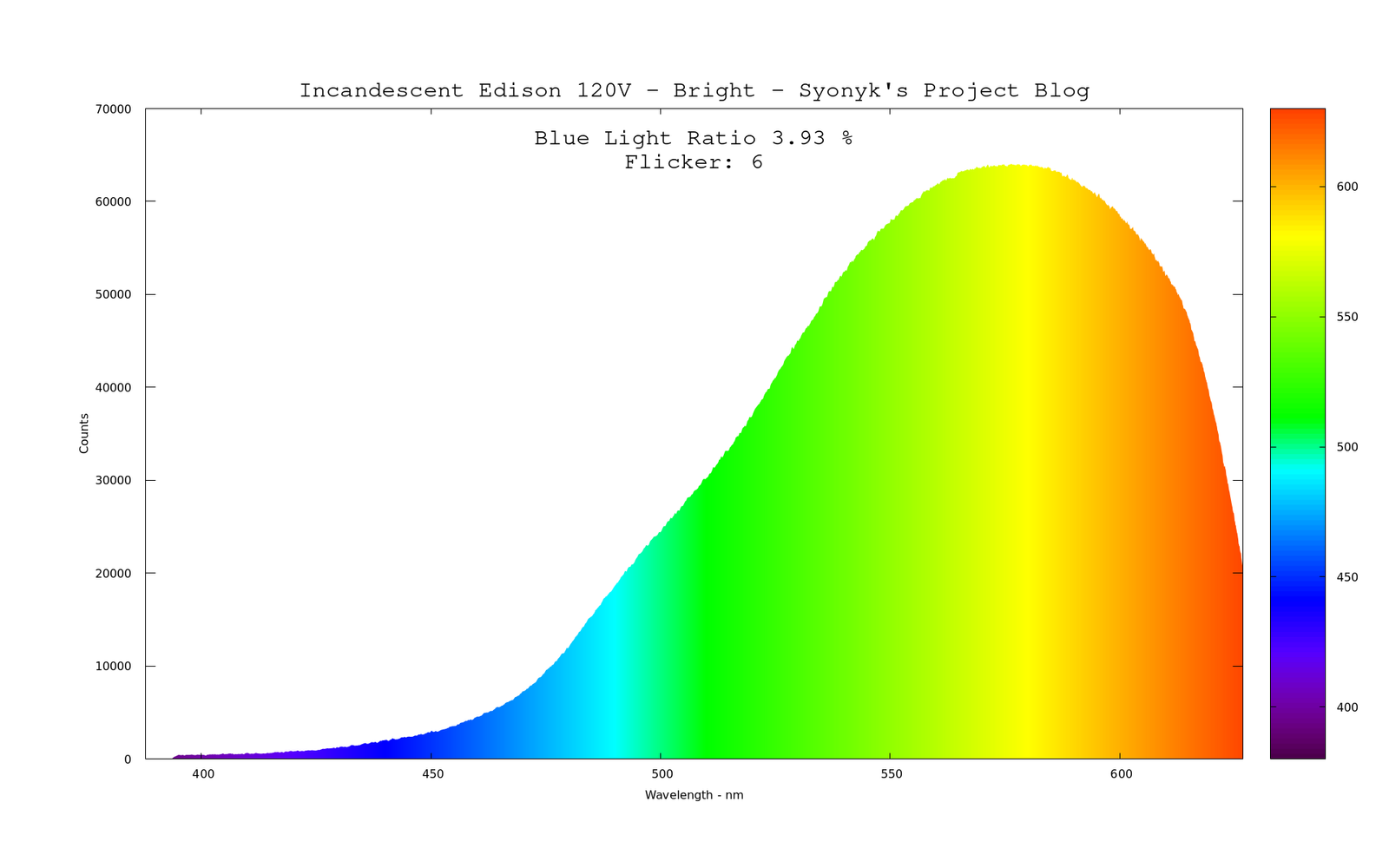
Dim it, and you get even less blue. This is just a beautiful evening bulb - enough light to read by, but also not enough blue to keep you awake!
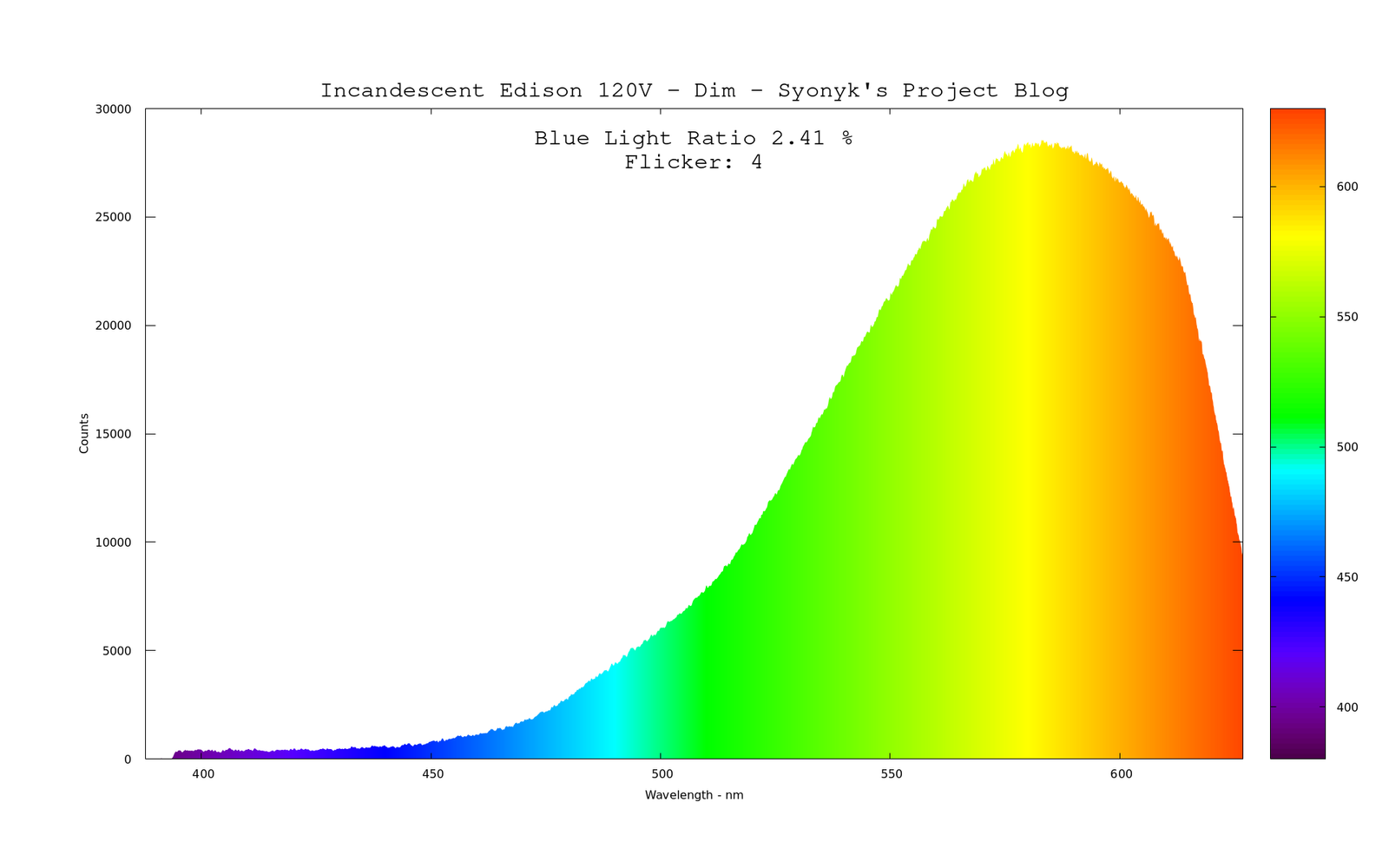
As for that 240V bulb at 120V? I got it to be super dim at night for “middle of the night kid up” sort of reasons, and at 13.9W, it should last “just about forever.”
What Incandescent Bulb Should You Run?
Alright. This has been yet again, one of my longer posts, and I should work on making them shorter. But what bulbs should you run if you want to (before they’re fully unavailable) acquire some incandescents?
As far as I’m concerned, the “Reveal” sort of neodymium bulbs don’t serve a purpose anymore. If you want that sort of light, just run an LED. You get a lot more light for your watts, you get a similar enough spectrum, and you can go a lot “whiter” (higher color temperature) than you can run a filament.
For bulbs that you want to dim, but are hidden fully behind some sort of lampshade (or the “boob lamp” style ceiling fixtures), run one of the halogen capsule sort - and I’d suggest the Ecosmart, if you can find them.
And, finally, for any sort of exposed incandescent, you want new old stock - because the new stock I have all sing loudly when dimmed, and that’s just hugely annoying. For what it’s worth, while I’ve not reviewed any here, I’ve also not found any singing issues with the various BR30 bulbs I’m running in my ceiling cans.
But please install dimmers for them!
Where to Get Them
Of course, it’s hard to actually find incandescent bulbs anymore. For now, your best bet will be eBay. But I’ve no idea how long this will remain an option, or if the various enforcement departments will try to make an example of a few “black market sellers of bulbs” to… I don’t know, complete the process of ensuring everyone is short on sleep and more subject to manipulation by their black mirrors? I really don’t understand the point of the “hard bans” other than to just actively piss off people at this point - most people had already moved to LEDs, and given how blue they all are in the evenings, they do screw with sleep. Back to lanterns, I guess!
Final Thoughts
I’ve been running down this rabbithole of LEDs, incandescent bulbs, dimmers, spectrums, and sleep for most of a year now. What’s the result been in my life out of it?
Most of my “evening lights” are now incandescent bulbs of some form or another, and I spend a lot of the winter evenings by lantern light. I’ve yet to find a single LED that is anywhere close to a dimmed incandescent in terms of “lack of blue light.” The LEDs, dimmed, will put out less light - but they put it out in about the same spectrum as when bright. Incandescents don’t. They dim to red, and get less and less blue as you dim them more. You really do need a lot less light in the evenings than you think, once your eyes adjust. I’ve been trying to be very aggressive about “No LEDs after sundown,” and it’s made a very real difference in my sleep.
I still have a few more posts in this series. A question that came up early is, “Well, how about the orange blue blocking lenses at night?” The answer is “They help, but you have to be really careful about which ones you use, because some of them aren’t much better than nothing at all.”
But it’s pretty darn hard to argue with something that looks like this in the evening.
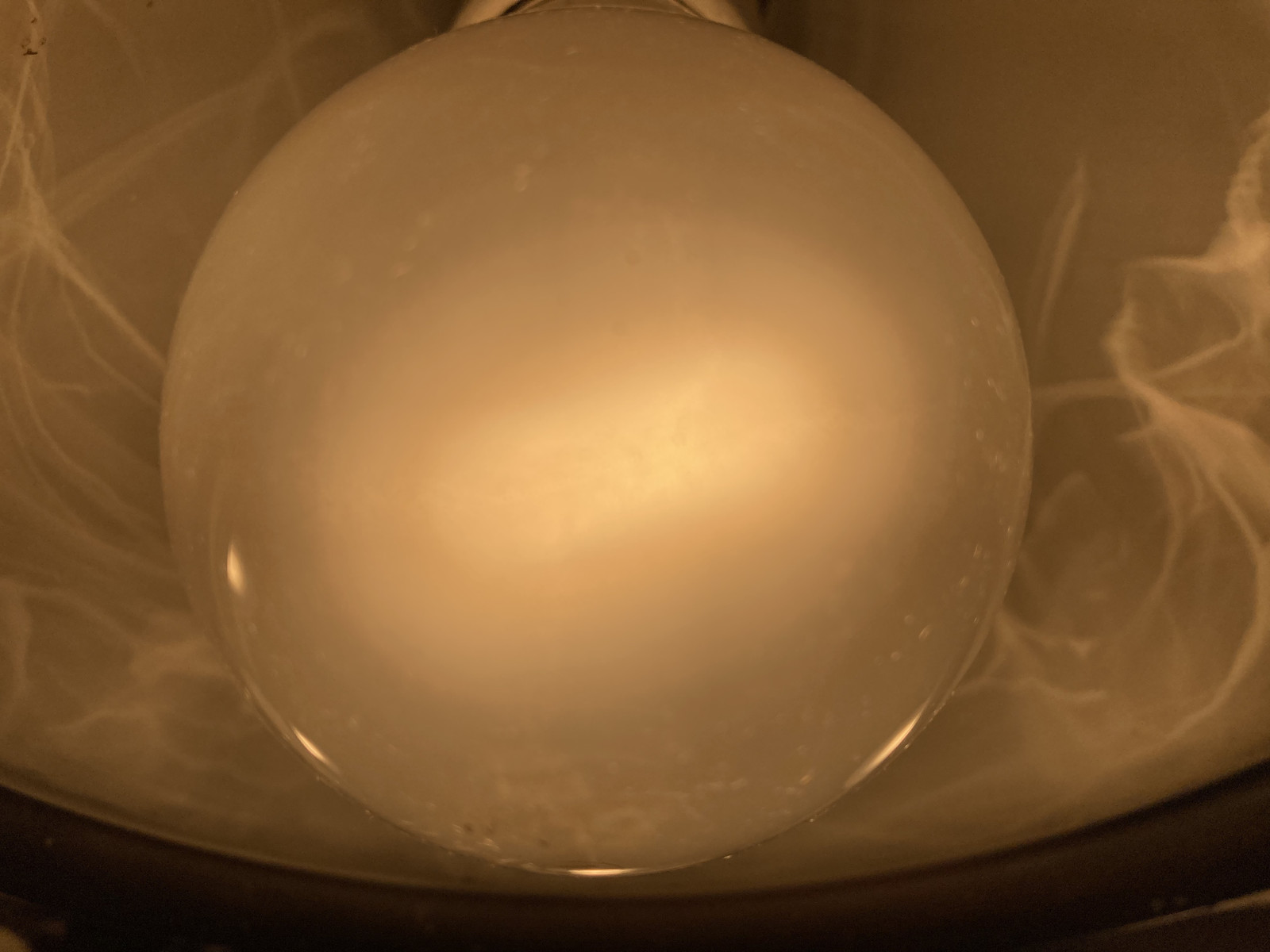
Comments
Comments are handled on my Discourse forum - you'll need to create an account there to post comments.If you've found this post useful, insightful, or informative, why not support me on Ko-fi? And if you'd like to be notified of new posts (I post every two weeks), you can follow my blog via email! Of course, if you like RSS, I support that too.
